Samsung Electronics Co SF760P Mono Laser Printer User Manual Egmont S english
Samsung Electronics Co Ltd Mono Laser Printer Egmont S english
Contents
- 1. Users Manual 1
- 2. Users Manual 2
Users Manual 1

BASIC
User’s Guide
SF-76xP Series
BASIC
User’s Guide
This guide provides information concerning installation, basic operation and
troubleshooting on windows.
ADVANCED
This guide provides information about installation, advanced configuration, operation and
troubleshooting on various OS environments.
Some features may not be available depending on models or countries.
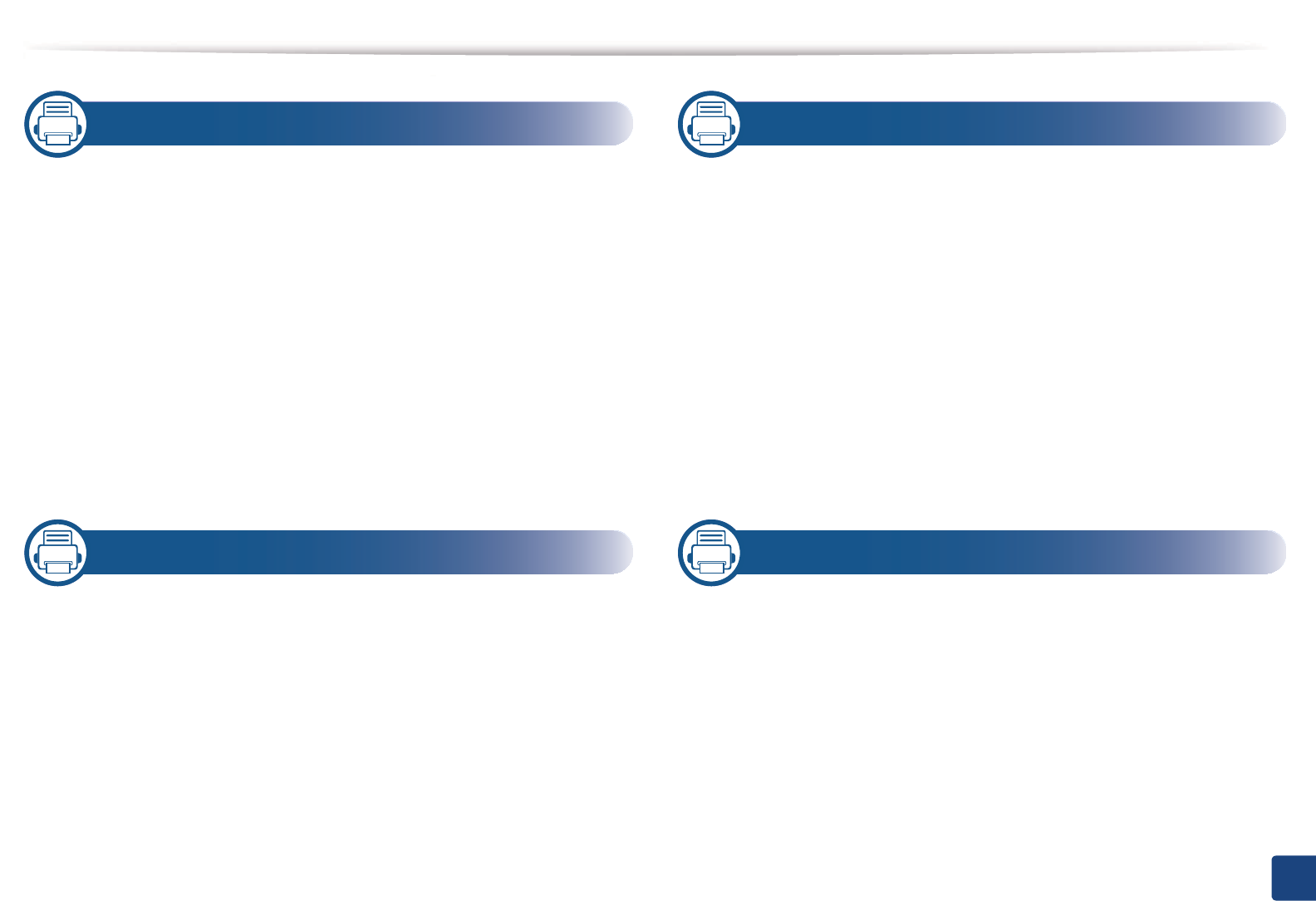
2
BASIC
1. Introduction
Key benefits 5
Features by models 7
Useful to know 12
About this user’s guide 13
Safety information 14
Machine overview 19
Control panel overview 23
Turning on the machine 25
Installing the driver locally 26
Reinstalling the driver 27
2. Menu Overview and Basic Setup
Menu overview 29
Machine’s basic settings 34
Media and tray 36
Basic printing 46
Basic copying 50
Basic scanning 53
Basic faxing 54
3. Maintenance
Ordering supplies and accessories 59
Available supplies 60
Available maintenance parts 61
Storing the toner cartridge 62
Redistributing toner 64
Replacing the toner cartridge 66
Monitoring the supplies life 68
Setting the toner low alert 69
Cleaning the machine 70
Tips for moving & storing your machine 77
4. Troubleshooting
Tips for avoiding paper jams 79
Clearing original document jams 80
Clearing paper jams 82
Understanding the status LED 85
Understanding display messages 87

3
BASIC
5. Appendix
Specifications 92
Regulatory information 100
Copyright 110

1. Introduction
This chapter provides information you need to know before using the machine.
•Key benefits 5
• Features by models 7
• Useful to know 12
• About this user’s guide 13
• Safety information 14
• Machine overview 19
• Control panel overview 23
• Turning on the machine 25
• Installing the driver locally 26
• Reinstalling the driver 27
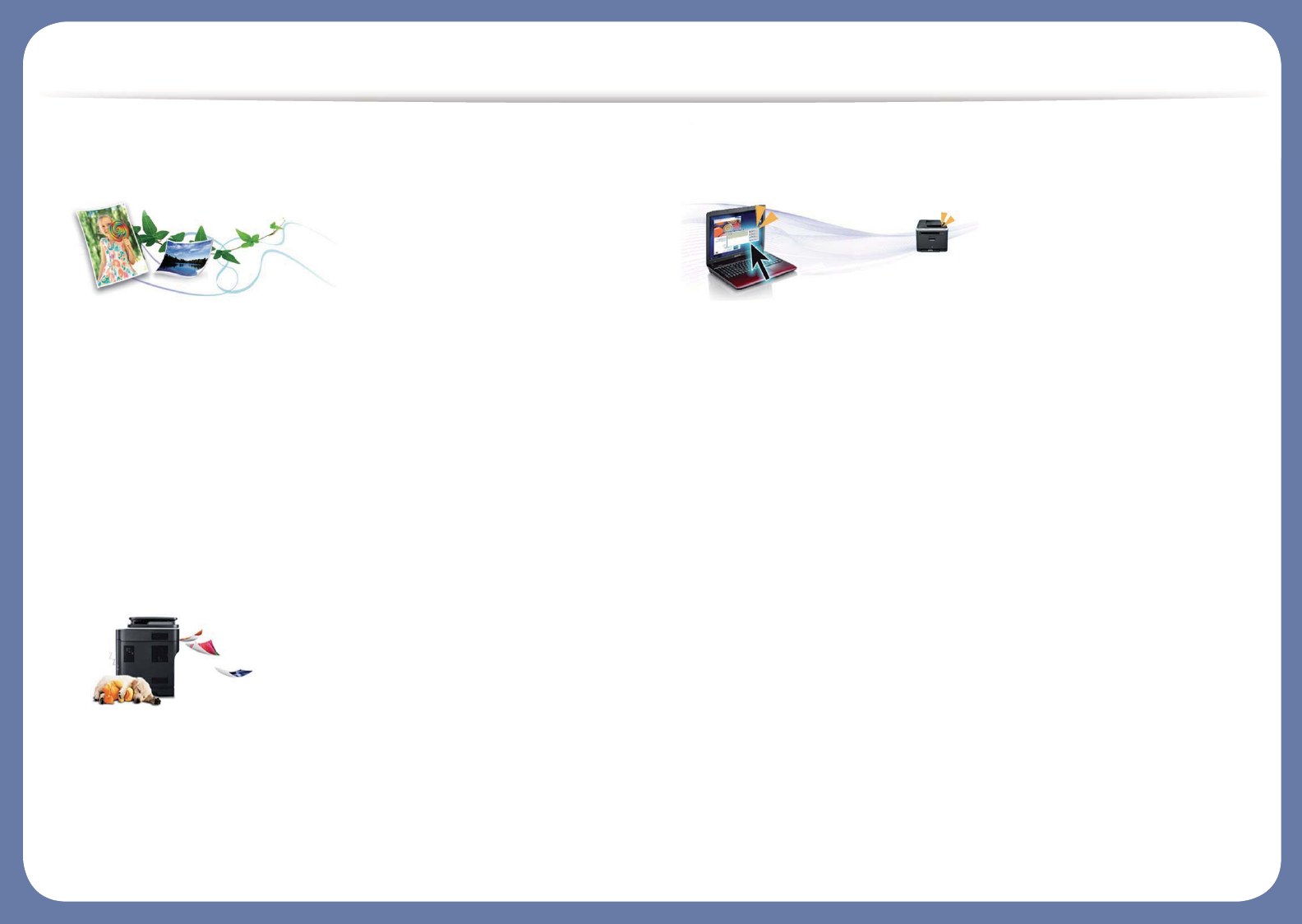
Key benefits
Environmentally friendly
• To save toner and paper, this machine supports Eco feature (see "Easy Eco
Driver" on page 169).
• To save paper, you can print multiple pages on one single sheet of paper
(see "Using advanced print features" on page 140).
• To save paper, you can print on both sides of the paper (Double-sided
printing(Manual)) (see "Using advanced print features" on page 140).
• To save electricity, this machine automatically conserves electricity by
substantially reducing power consumption when not in use.
Fast high resolution printing
• You can print with a resolution of up to 1,200 x 1,200 dpi effective output.
• Fast, on-demand printing.
- For single-side printing, 20 ppm (A4) or 21 ppm (Letter).
Convenience
• Easy Capture Manager allows you to easily edit and print whatever you
captured using the Print Screen key on the keyboardG(see "Easy Capture
Manager" on page 167).
•Samsung Easy Printer Manager and Printing Status (or Smart Panel) is a
program that monitors and informs you of the machine’s status and allows
you to customize the machine’s settings (see "Using Samsung Printer
Status" on page 173 or "Using Smart Panel" on page 175).
• AnyWeb Print helps you screen-capture, preview, scrap, and print the
screen of Windows Internet Explorer more easily, than when you use the
ordinary program (see "Samsung AnyWeb Print" on page 168).
• Smart Update allows you to check for the latest software and install the
latest version during the printer driver installation process. This is available
only for Windows.
• If you have Internet access, you can get help, support application, machine
drivers, manuals, and order information from the Samsung website,
www.samsung.com > find your product> Support or Downloads

Key benefits
Wide range of functionality and application support
• Supports various paper sizes (see "Print media specifications" on page 94).
• Print watermark: You can customize your documents with words, such as
“Confidential” (see "Using advanced print features" on page 140).
• Print posters: The text and pictures of each page of your document are
magnified and printed across the multiple sheets of paper and can then be
taped together to form a poster (see"Using advanced print features" on
page 140).
• You can print in various operating systems (see "System requirements" on
page 97).
• Your machine is equipped with a USB interface.

Features by models
Some features and optional goods may not be available depending on model or country.
Operating System
(Ɣ: Included, Blank: Not available)
Software
Operating System SF-76xP Series
Windows Ɣ
Macintosh Ɣ
Linux Ɣ
Unix
Software SF-76xP Series
SPL printer driver Ɣ
PCL printer driver
PS printer driver
XPS printer driveraƔ
Direct Printing Utility

Features by models
(Ɣ: Included, Blank: Not available)
Samsung Easy Printer
Manager
Scan to PC settings Ɣ
Fax to PC settings Ɣ
Device settings Ɣ
Samsung Printer Status Ɣ
Smart Panel Ɣ
AnyWeb Print Ɣ
SyncThru™ Web Service
SyncThru Admin Web Service
Easy Eco Driver (Eco printing) Ɣ
Fax Samsung Network PC Fax Ɣ
Scan Twain scan driver Ɣ
WIA scan driver Ɣ
Samsung Scan Assistant Ɣ
SmarThru 4
SmarThru Office Ɣ
a. For XPS driver, it is only supported for Windows through the Samsung website (www.samsung.com)
Software SF-76xP Series
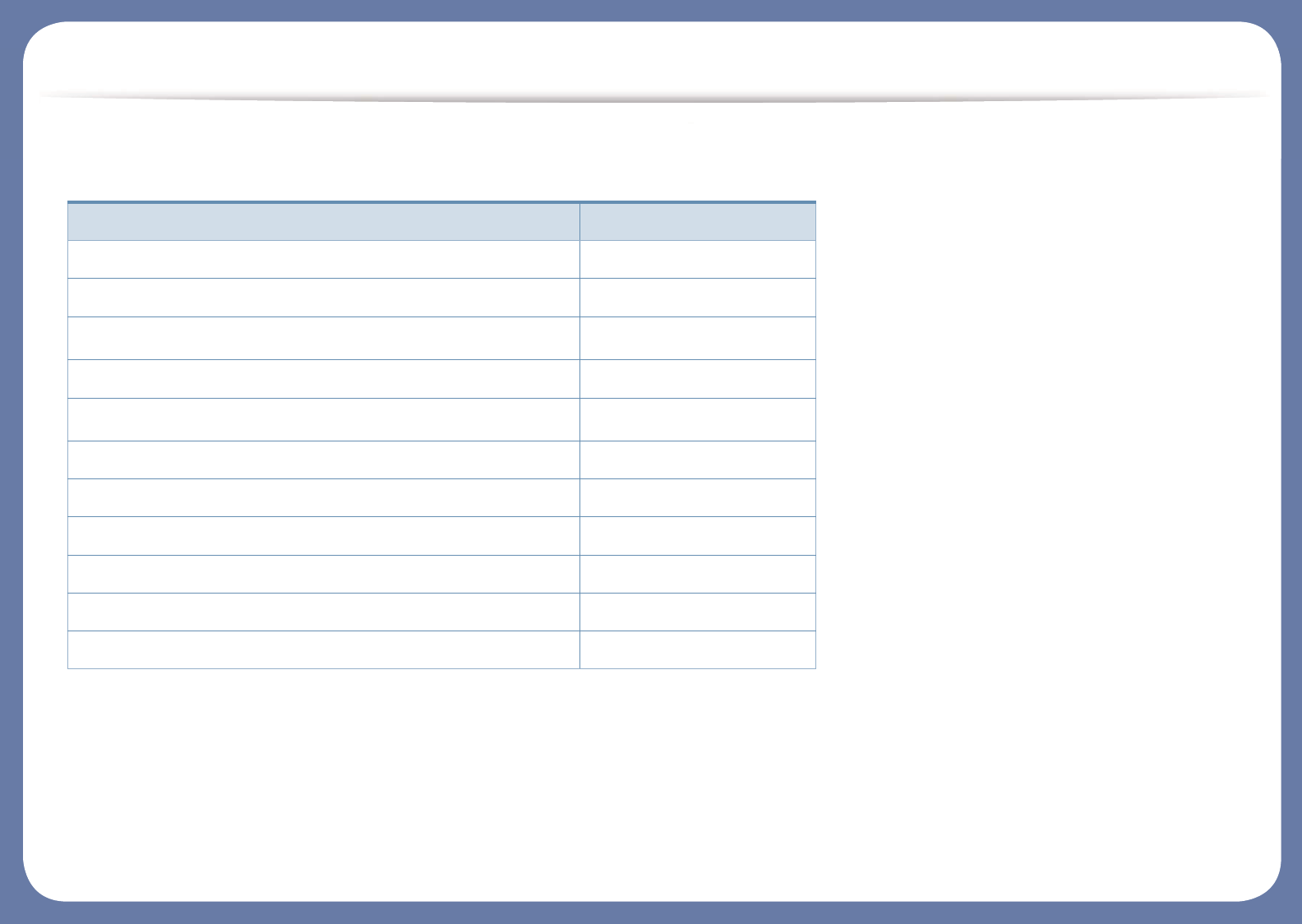
Features by models
Variety feature
Features SF-76xP Series
Hi-Speed USB 2.0 Ɣ
Network Interface Ethernet 10/100 Base TX wired LAN
Network Interface 802.11b/g/n wireless LANa
Eco printing (Control panel)
Duplex (2-sided) printing (Manual)bƔ
USB memory interface
Memory module
Mass Storage Device (HDD)
Duplex Automatic Document Feeder (DADF)
Automatic Document Feeder (ADF) Ɣ
Handset Ɣ
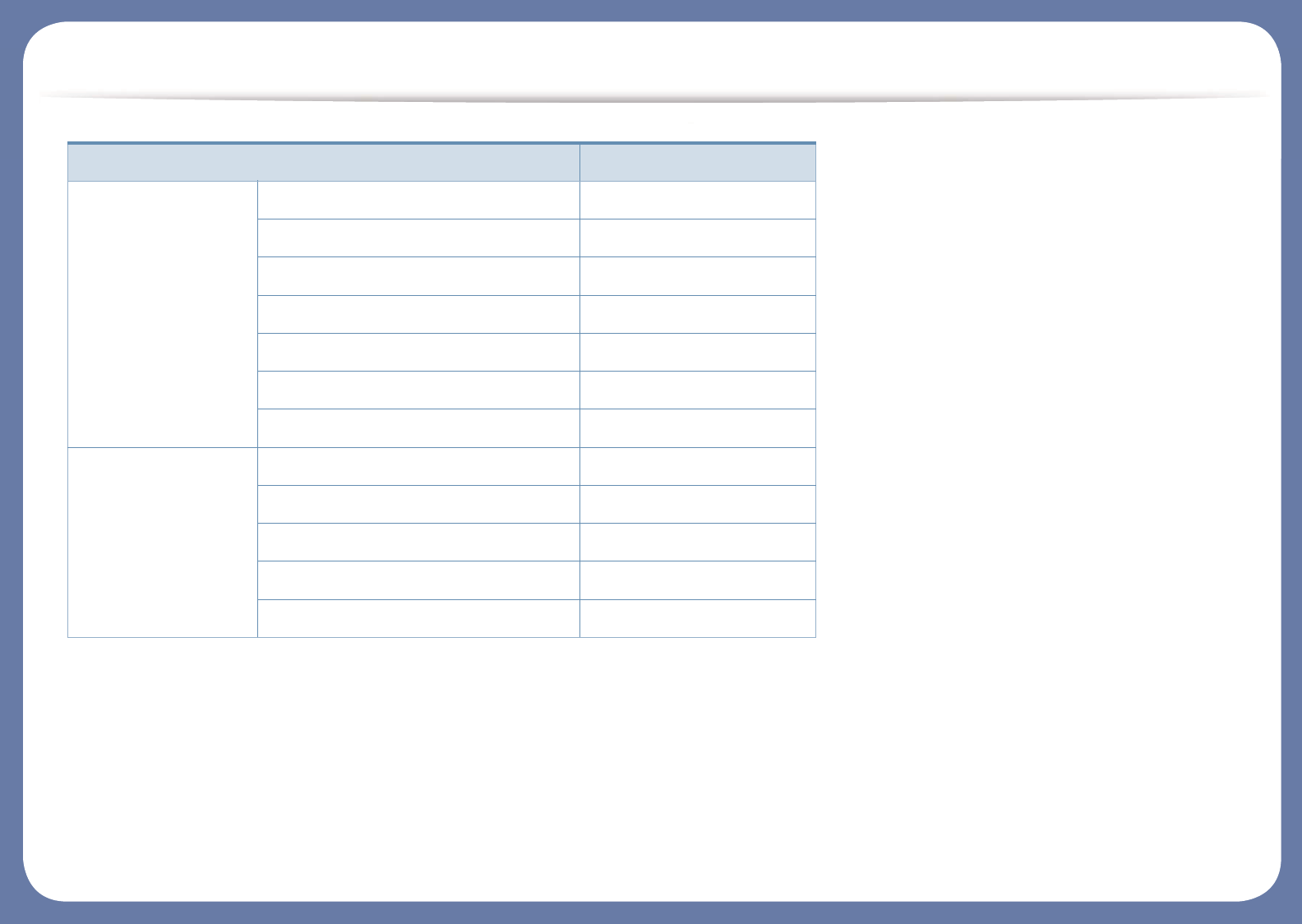
Features by models
Fax Multi-send Ɣ
Delay send Ɣ
Priority send Ɣ
Duplex send
Secure receive Ɣ
Duplex print
Send/ Receive forward - fax Ɣ
Scan Scanning to email
Scanning to SMB server
Scanning to FTP server
Duplex scan
Scan to PC Ɣ
Features SF-76xP Series
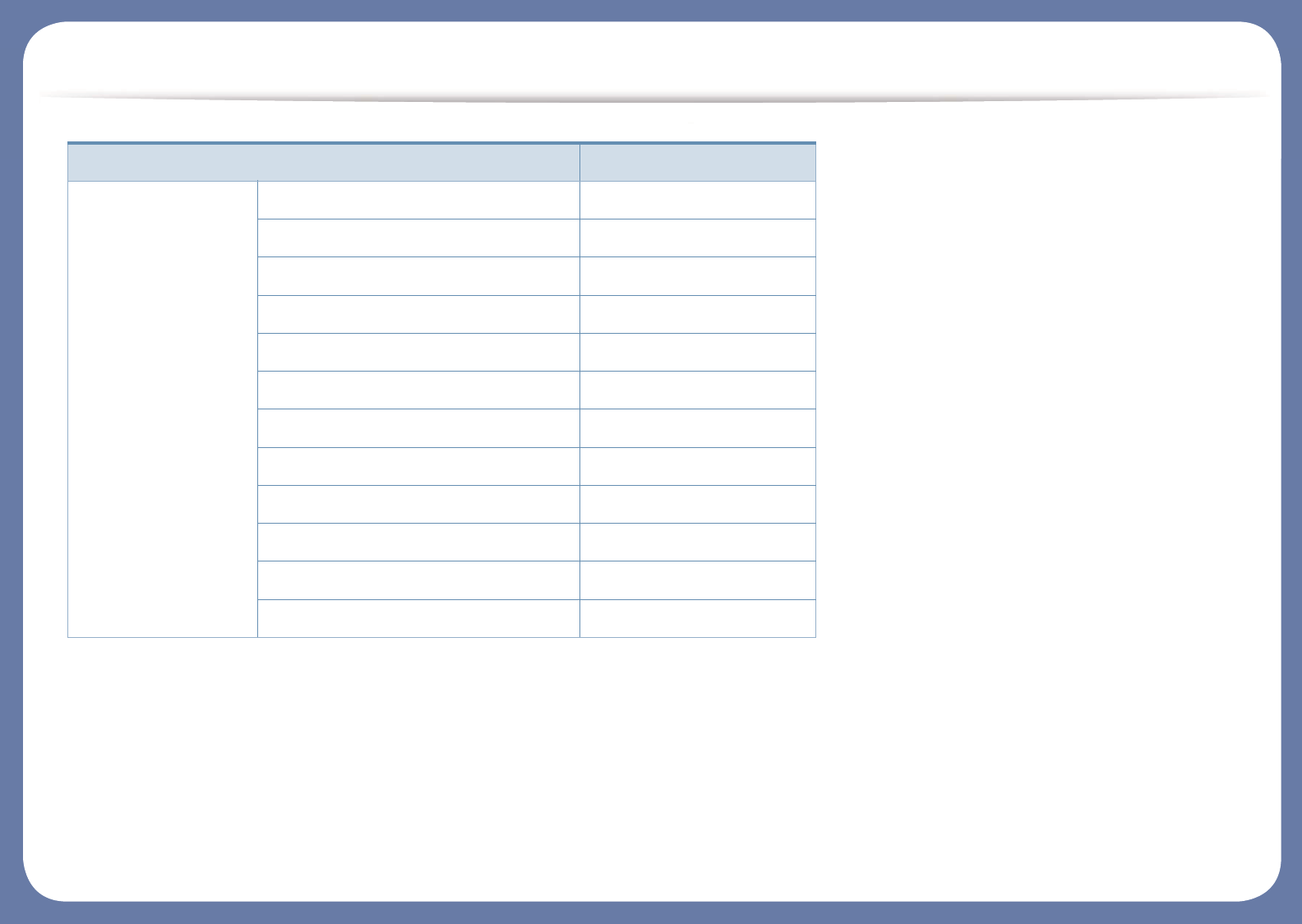
Features by models
(Ɣ: Included, Blank: Not available)
Copy ID card copying
Reduced or enlarged copying Ɣ
Collation Ɣ
Poster
Clone
Book
2-up/4-up Ɣ
Adjust background Ɣ
Margin shift
Edge erase
Gray enhance
Duplex copy
a. Depending on your country, wireless LAN card may not be available. For some counties, only 802.11 b/g can be
applied. Contact your local Samsung dealer or the retailer where you bought your machine.
b. Windows only.
Features SF-76xP Series
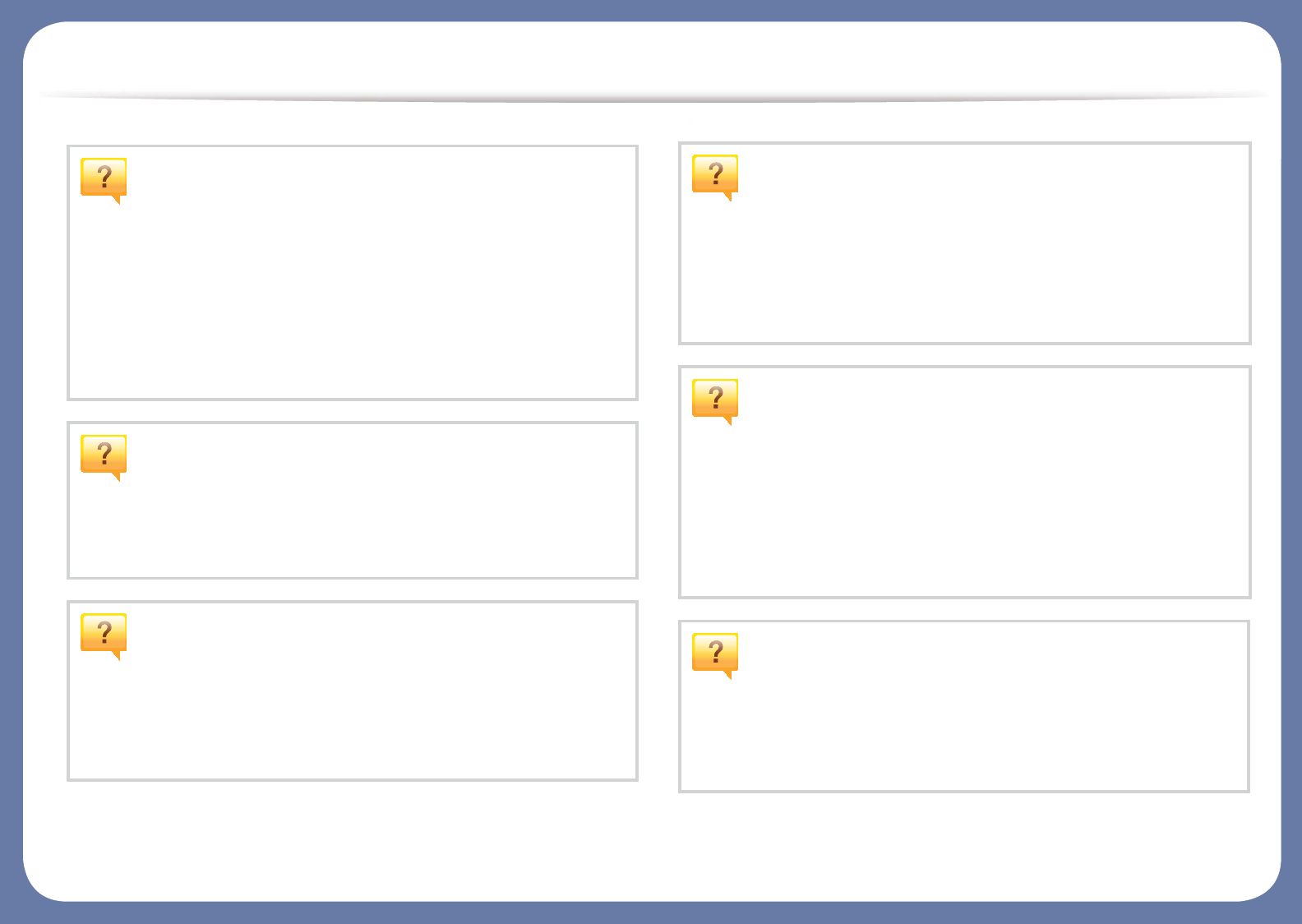
Useful to know
The machine does not print.
• Open the print queue list and remove the document from the
list (see "Canceling a print job" on page 47).
• Remove the driver and install it again (see "Installing the
driver locally" on page 26).
• Select your machine as your default machine in your
Windows (see "Setting your machine as a default machine" on
page 139).
Where can I purchase accessories or supplies?
• Inquire at a Samsung distributor or your retailer.
• Visit www.samsung.com/supplies. Select your country/
region to view product service information.
The status LED flashes or remains constantly on.
• Turn the product off and on again.
• Check the meanings of LED indications in this manual and
troubleshoot accordingly (see "Understanding the status
LED" on page 85).
A paper jam has occurred.
• Open and close the top cover or scan unit (see "Front view" on
page 20).
• Check the instructions on removing jammed paper in this
manual and troubleshoot accordingly (see "Clearing paper
jams" on page 82).
Printouts are blurry.
• The toner level might be low or uneven. Shake the toner
cartridge (see "Redistributing toner" on page 64).
• Try a different print resolution setting (see "Opening printing
preferences" on page 48).
• Replace the toner cartridge (see "Replacing the toner
cartridge" on page 66).
Where can I download the machine’s driver?
• You can get help, support application, machine drivers,
manuals, and order information from the Samsung website,
www.samsung.com > find your product> Support or
Downloads.

13
1. Introduction
About this user’s guide
This user's guide provides information for your basic understanding of the
machine as well as detailed steps to explain machine usage.
• Read the safety information before using the machine.
• If you have a problem using the machine, refer to the troubleshooting
chapter.
• Terms used in this user’s guide are explained in the glossary chapter.
• All illustrations in this user’s guide may differ from your machine depending
on its options or model you purchased.
• The screenshots in this administrator’s guide may differ from your machine
depending on the machine’s firmware/driver version.
• The procedures in this user’s guide are mainly based on Windows 7.
1
Conventions
Some terms in this guide are used interchangeably, as below:
• Document is synonymous with original.
• Paper is synonymous with media, or print media.
• Machine refers to printer or MFP.
2
General icons
Icon Text Description
Caution
Gives users information to protect the machine
from possible mechanical damage or
malfunction.
Note
Provides additional information or detailed
specification of the machine function and
feature.
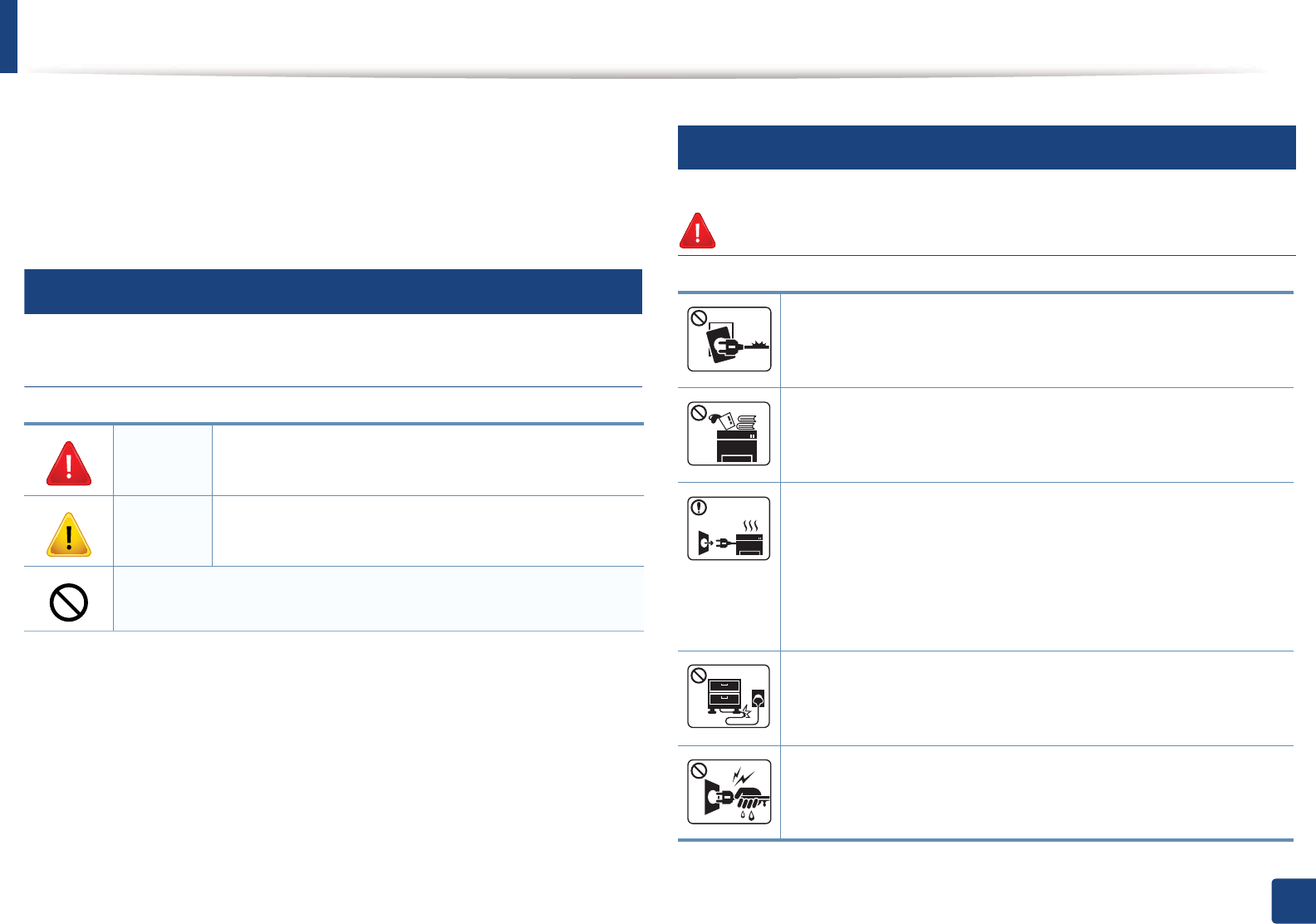
14
1. Introduction
Safety information
These warnings and precautions are included to prevent injury to you and
others, and to prevent any potential damage to your machine. Be sure to read
and understand all of these instructions before using the machine. After reading
this section, keep it in a safe place for future reference.
3
Important safety symbols
Explanation of all icons and signs used in this chapter
4
Operating environment
Warning
Warning Hazards or unsafe practices that may result in severe
personal injury or death.
Caution Hazards or unsafe practices that may result in minor
personal injury or property damage.
Do not attempt.
Do not use if the power cord is damaged or if the electrical outlet is
not grounded.
This could result in electric shock or fire.
Do not place anything on top of the machine (water, small metal or
heavy objects, candles, lit cigarettes, etc.).
This could result in electric shock or fire.
• If the machine gets overheated, it releases smoke, makes
strange noises, or generates an odd odor, immediately turn off
the power switch and unplug the machine.
• The user should be able to access the power outlet in case of
emergencies that might require the user to pull the plug out.
This could result in electric shock or fire.
Do not bend, or place heavy objects on the power cord.
Stepping on or allowing the power cord to be crushed by a heavy
object could result in electric shock or fire.
Do not remove the plug by pulling on the cord; do not handle the
plug with wet hands.
This could result in electric shock or fire.
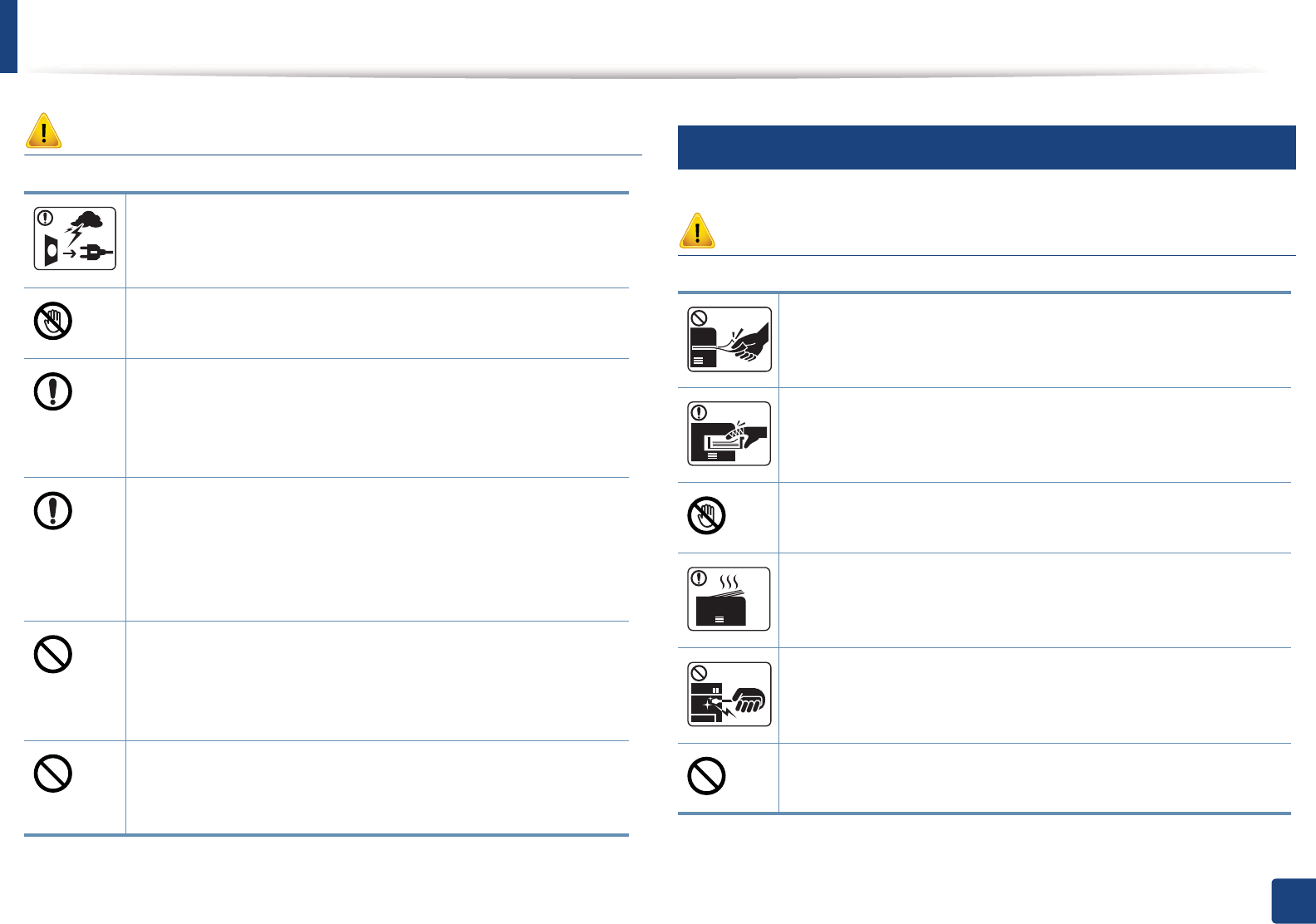
Safety information
15
1. Introduction
Caution
5
Operating method
Caution
During an electrical storm or for a period of non-operation,
remove the power plug from the electrical outlet.
This could result in electric shock or fire.
Be careful, the paper output area is hot.
Burns could occur.
If the machine has been dropped, or if the cabinet appears
damaged, unplug the machine from all interface connections and
request assistance from qualified service personnel.
Otherwise, this could result in electric shock or fire.
If the machine does not operate properly after these instructions
have been followed, unplug the machine from all interface
connections and request assistance from qualified service
personnel.
Otherwise, this could result in electric shock or fire.
If the plug does not easily enter the electrical outlet, do not
attempt to force it in.
Call an electrician to change the electrical outlet, or this could
result in electric shock.
Do not allow pets to chew on the AC power, telephone or PC
interface cords.
This could result in electric shock or fire and/or injury to your pet.
Do not forcefully pull the paper out during printing.
It can cause damage to the machine.
Be careful not to put your hand between the machine and paper
tray.
You may get injured.
Be care when replacing paper or removing jammed paper.
New paper has sharp edges and can cause painful cuts.
When printing large quantities, the bottom part of the paper
output area may get hot. Do not allow children to touch.
Burns can occur.
When removing jammed paper, do not use tweezers or sharp metal
objects.
It can damage the machine.
Do not allow too many papers to stack up in the paper output tray.
It can damage the machine.

Safety information
16
1. Introduction
6
Installation / Moving
Warning
Caution
Do not block or push objects into the ventilation opening.
This could result in elevated component temperatures which can
cause damage or fire.
Use of controls or adjustments or performance of procedures other
than those specified herein may result in hazardous radiation
exposure.
This machine's power reception device is the power cord.
To switch off the power supply, remove the power cord from the
electrical outlet.
Do not place the machine in an area with dust, humidity, or water
leaks.
This could result in electric shock or fire.
Before moving the machine, turn the power off and disconnect all
cords. The information below are only suggestions based on the
units weight. If you have a medical condition that prevents you
from lifting, do not lift the machine. Ask for help, and always use
the appropriate amount of people to left the device safety.
Then lift the machine:
• If the machine weighs under 20 kg (44.09 lbs), lift with 1 person.
• If the machine weighs 20 kg (44.09 lbs) - 40kg (88.18 lbs), lift
with 2 people.
• If the machine weighs more than 40 kg (88.18 lbs), lift with 4 or
more people.
The machine could fall, causing injury or machine damage.
Do not place the machine on an unstable surface.
The machine could fall, causing injury or machine damage.
Use only No.26 AWGa or larger, telephone line cord, if necessary.
Otherwise, it can cause damage to the machine.
Make sure you plug the power cord into a grounded electrical
outlet.
Otherwise, this could result in electric shock or fire.

Safety information
17
1. Introduction
7
Maintenance / Checking
Caution
Use the power cord supplied with your machine for safe
operation. If you are using a cord which is longer than 2 meters (6
feet) with a 110V machine, then the gauge should be 16 AWG or
larger.
Otherwise, it can cause damage to the machine, and could result
in electric shock or fire.
Do not put a cover over the machine or place it in an airtight
location, such as a closet.
If the machine is not well-ventilated, this could result in fire.
Do not overload wall outlets and extension cords.
This can diminish performance, and could result in electric shock
or fire.
The machine should be connected to
the power level which is specified on the label.
If you are unsure and want to check the power level you are using,
contact the electrical utility company.
a. AWG: American Wire Gauge
Unplug this product from the wall outlet before cleaning the
inside of the machine. Do not clean the machine with benzene,
paint thinner or alcohol; do not spray water directly into the
machine.
This could result in electric shock or fire.
When you are working inside the machine replacing supplies or
cleaning the inside, do not operate the machine.
You could get injured.
Keep cleaning supplies away from children.
Children could get hurt.
Do not disassemble, repair or rebuild the machine by yourself.
It can damage the machine. Call a certified technician when the
machine needs repairing.
To clean and operate the machine, strictly follow the user's guide
provided with the machine.
Otherwise, you could damage the machine.
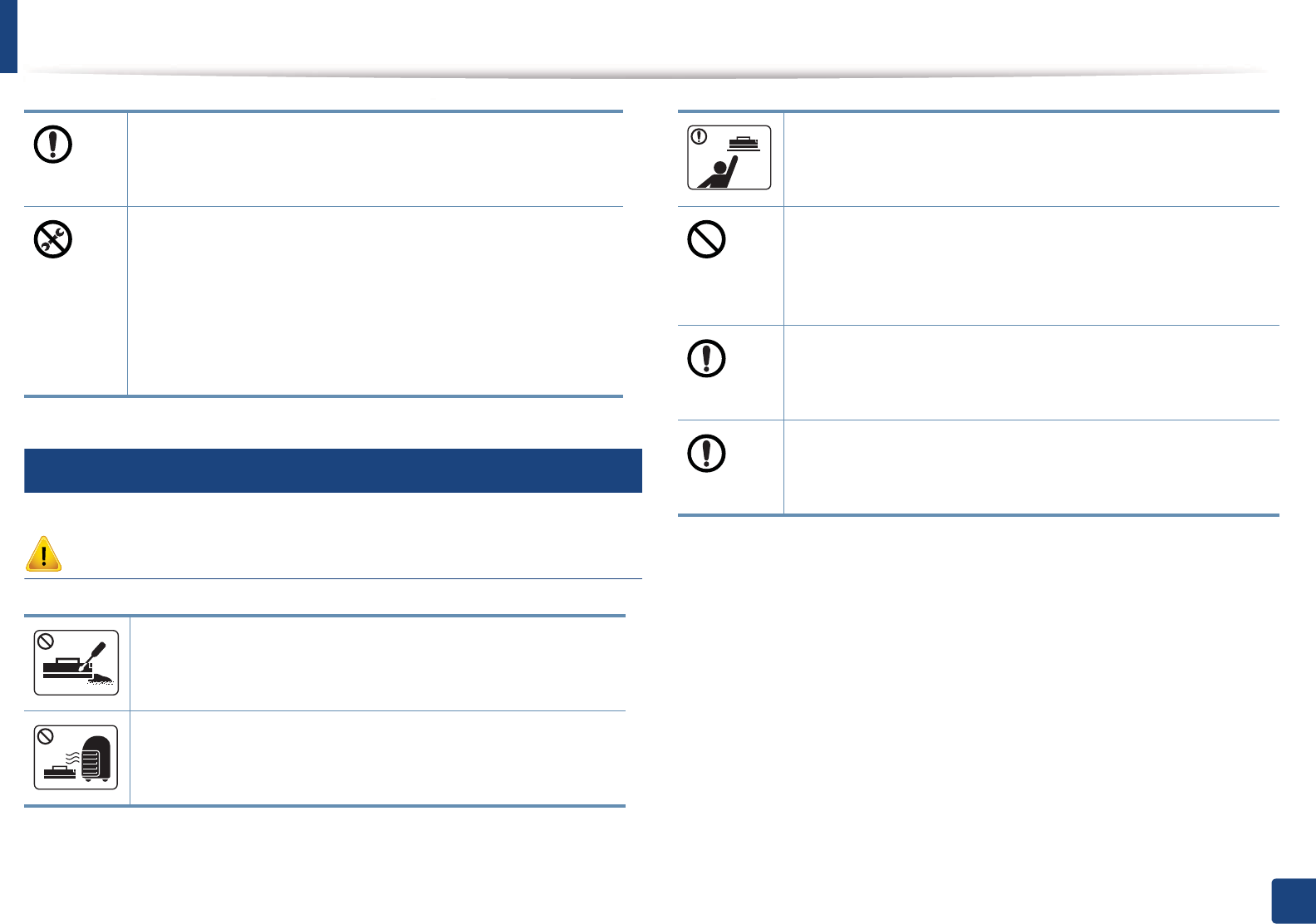
Safety information
18
1. Introduction
8
Supply usage
Caution
Keep the power cable and the contact surface of the plug clean
from dust or water.
Otherwise, this could result in electric shock or fire.
• Do not remove any covers or guards that are fastened with
screws.
• Fuser units should only be repaired by a certified service
technician. Repair by non-certified technicians could result in
fire or electric shock.
• The machine should only be repaired by a Samsung service
technician.
Do not disassemble the toner cartridge.
Toner dust can be dangerous if inhaled or ingested.
Do not burn any of the supplies such as toner cartridge or fuser
unit.
This could cause an explosion or uncontrollable fire.
When storing supplies such as toner cartridges, keep them away
from children.
Toner dust can be dangerous if inhaled or ingested.
Using recycled supplies, such as toner, can cause damage to the
machine.
In case of damage due to the use of recycled supplies, a service
fee will be charged.
When toner gets on your clothing, do not use hot water to wash
it.
Hot water sets toner into fabric. Use cold water.
When changing the toner cartridge or removing jammed paper,
be careful not to let toner dust touch your body or clothes.
Toner dust can be dangerous if inhaled or ingested.
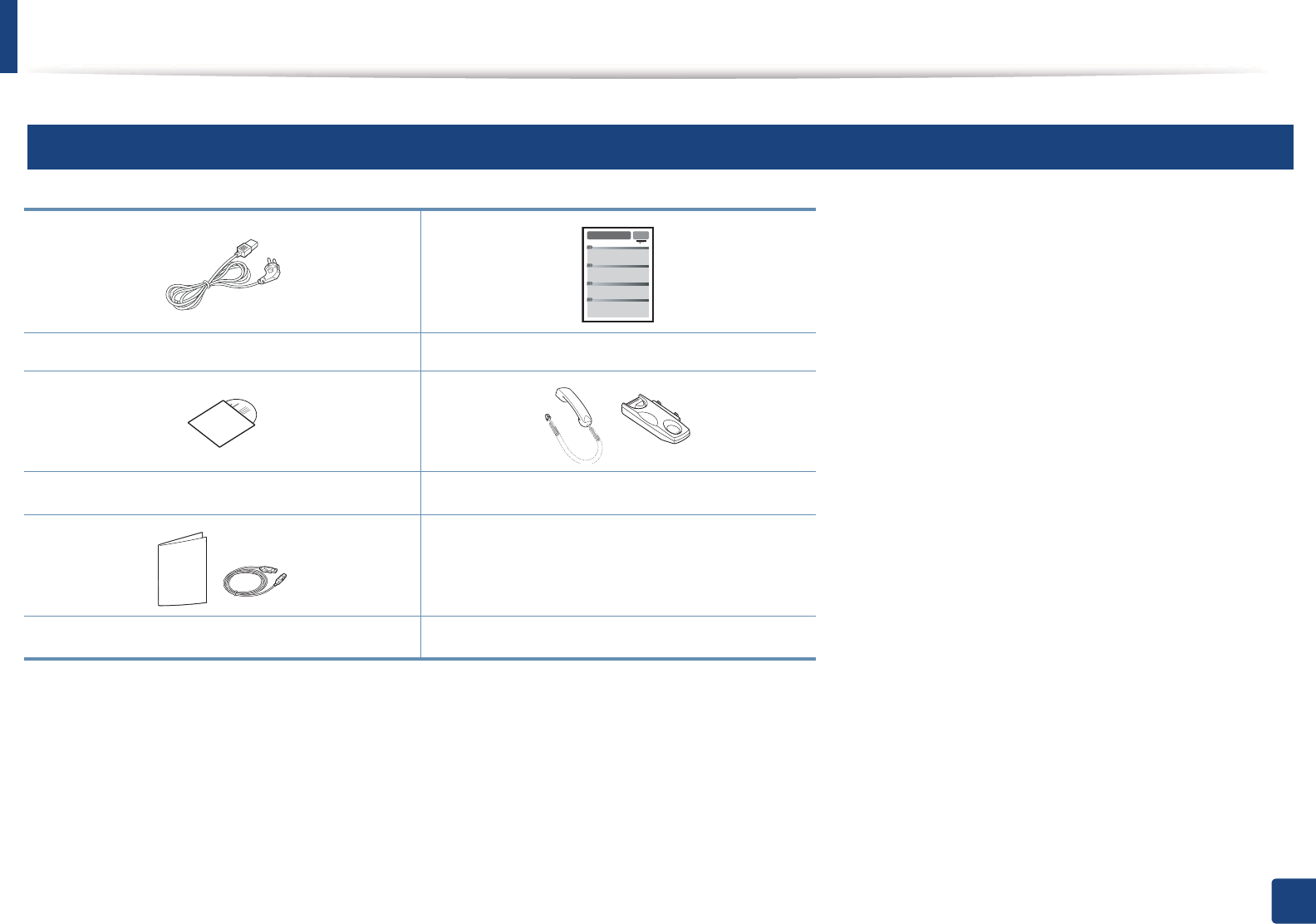
19
1. Introduction
Machine overview
9
Accessories
Power cord Quick installation guide
Software CDa
a. The software CD contains the print drivers user’s guide, and software applications.
Handset
Misc. accessoriesb
b. Miscellaneous accessories included with your machine may vary by country of purchase and specific model.
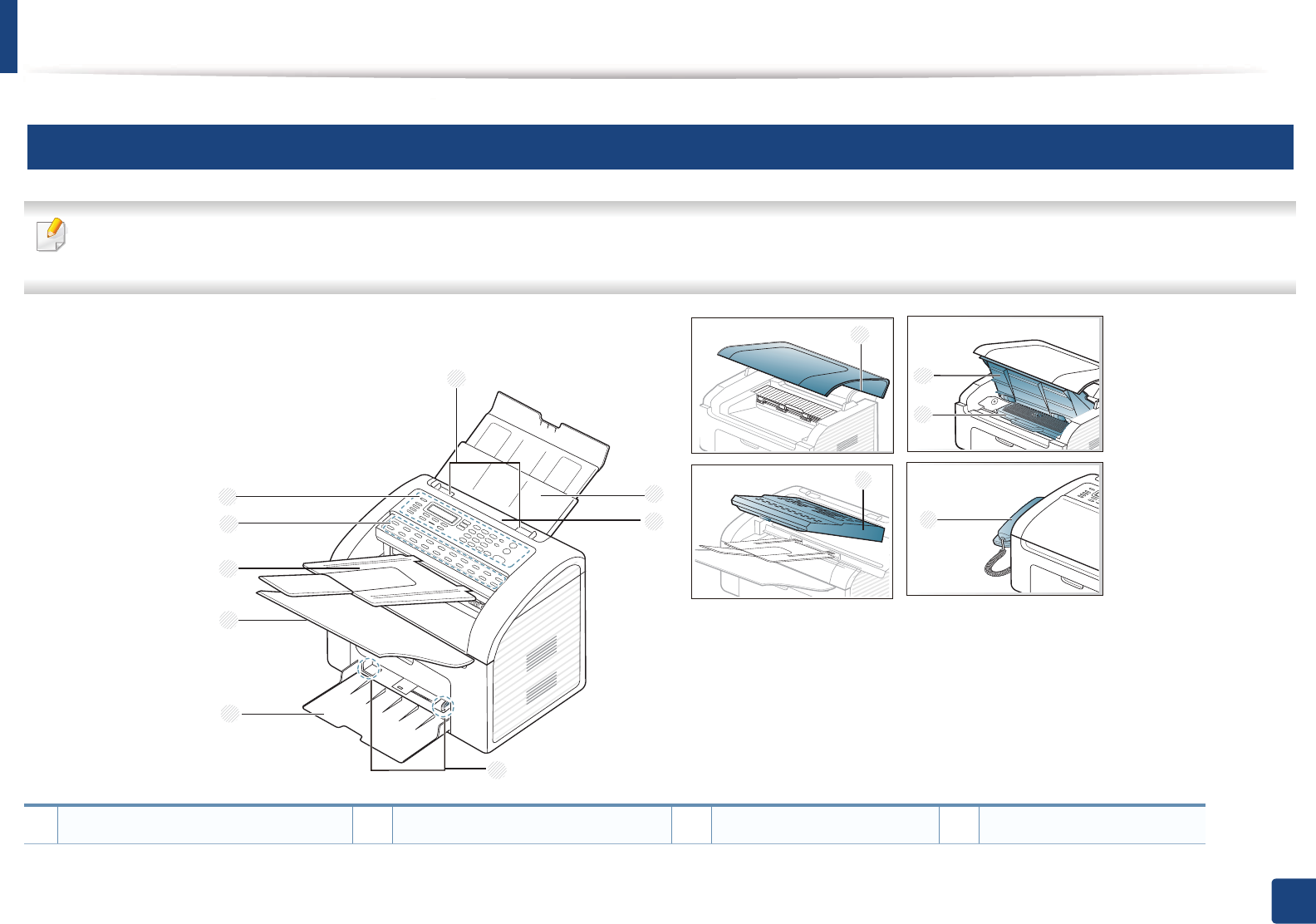
Machine overview
20
1. Introduction
10
Front view
• This illustration may differ from your machine depending on your model.
• Some features and optional goods may not be available depending on model or country (see "Features by models" on page 7).
1Document feeder width guides 5 Tray 9 Control panel 13 Scan unit
9
4
1
2
8
6
5
3
7
11
12
11
12
13
14
10
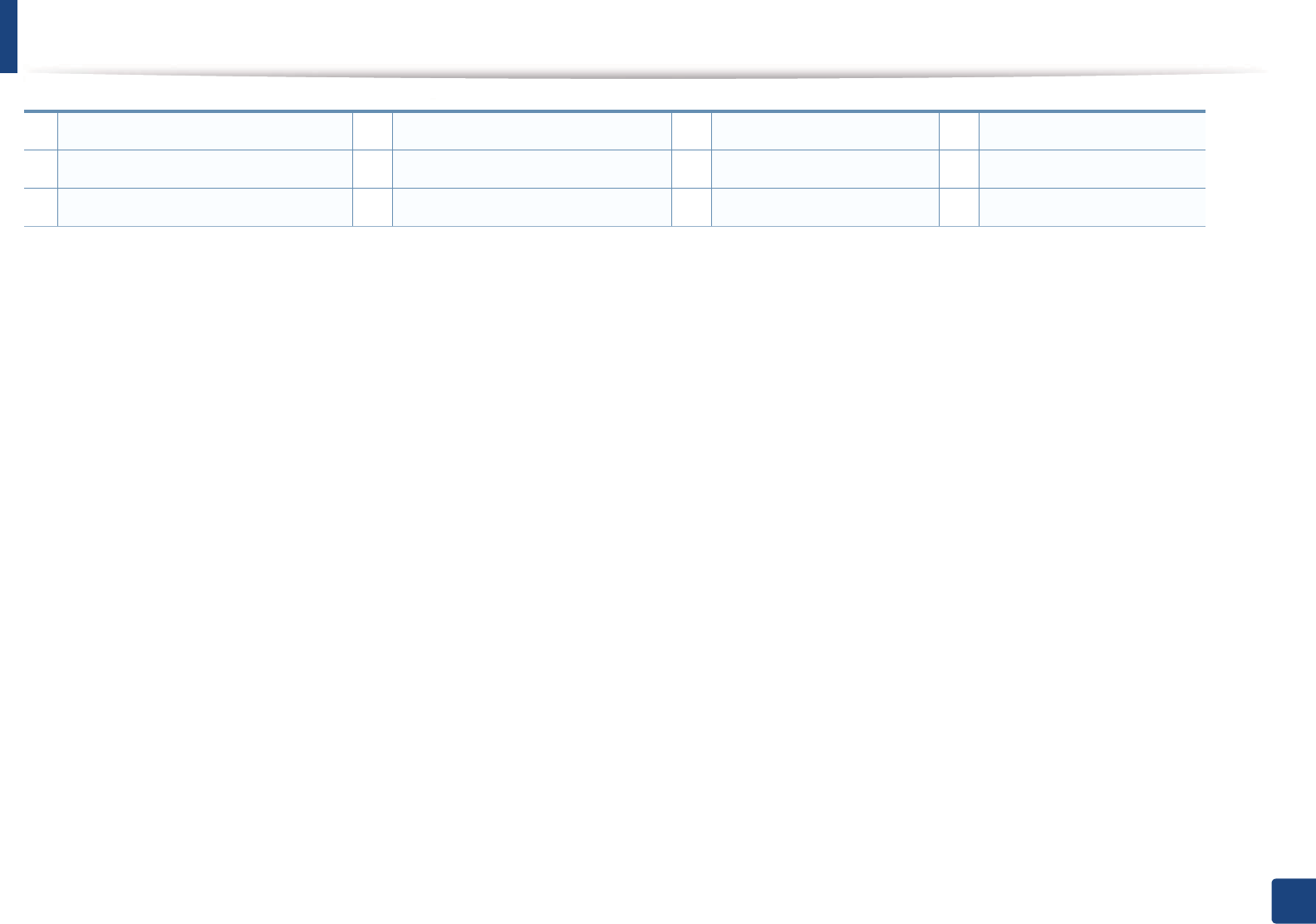
Machine overview
21
1. Introduction
2Document feeder input tray 6 Output tray 10 Top cover 14 Handset
3Document feeder 7 Document feeder output tray 11 Inner cover
4Paper width guides 8 One-touch dial 12 Toner cartridge
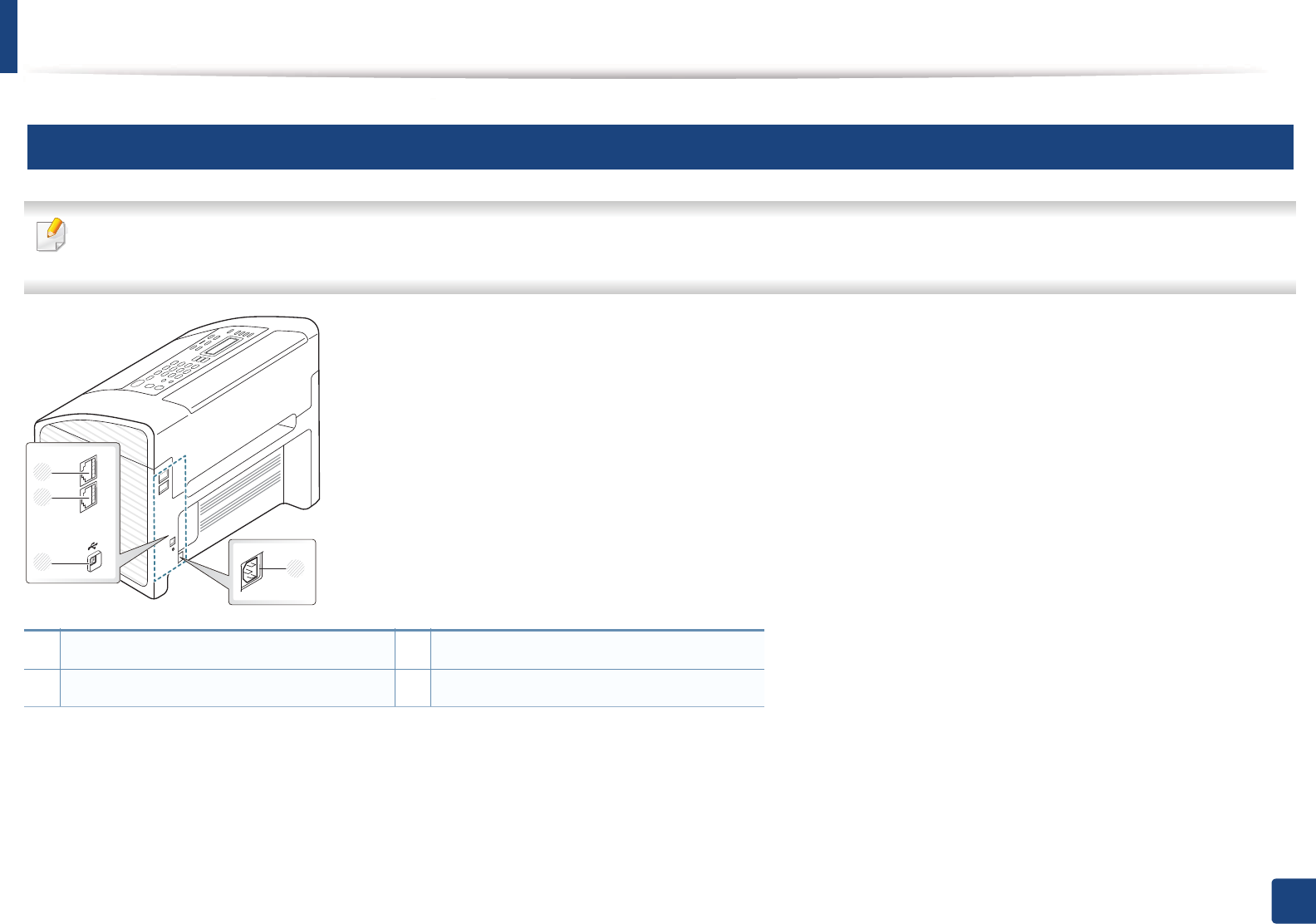
Machine overview
22
1. Introduction
11
Rear view
• This illustration may differ from your machine depending on your model.
• Some features and optional goods may not be available depending on model or country (see "Features by models" on page 7).
1Extension telephone socket (EXT.)3USB port
2Telephone line socket (LINE)4Power receptacle
1
2
34
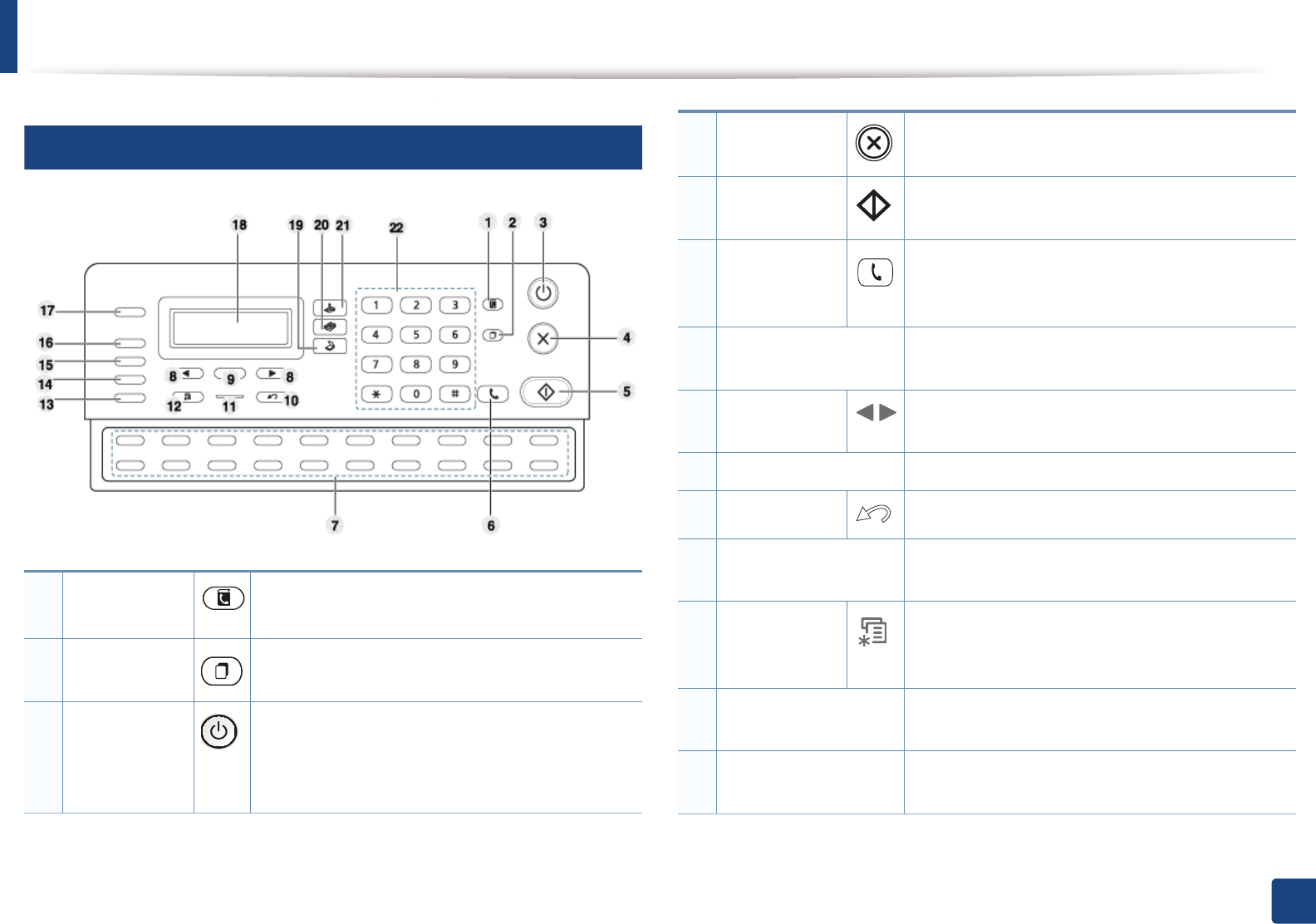
23
1. Introduction
Control panel overview
12
Control panel
1Address Book Allows you to store frequently used fax numbers or
search for stored fax numbers.
2Redial/Pause Redials the last number in ready mode, or inserts a
pause(-) into a fax number in edit mode.
3Power Turns the power on or off, or wakes up the machine
from the power save mode. If you need to turn the
machine off, press this button for more than three
seconds.
4Stop/Clear Stops an operations at any time.
5Start Starts a job.
6On Hook Dial When you press this button, you can hear a dial
tone. Then enter a fax number. It is similar to
making a call using speaker phone.
7One-touch dial Stores frequently-dialed fax number (see "One-
touch dialing" on page 136).
8Left/Right
Arrows
Scrolls through the options available in the
selected menu and increases or decreases values.
9OK Confirms the selection on the display screen.
10 Back Sends you back to the upper menu level.
11 Status LED Indicates the status of your machine (see
"Understanding the status LED" on page 85).
12 Menu Opens Menu mode and scrolls through the
available menus (see "Menu overview" on page
29).
13 Resolution Adjusts the resolution of the documents for the
current fax job (see "Resolution" on page 56).
14 Receive Mode Converts the fax receiving mode (see "Changing
the receive modes" on page 162).
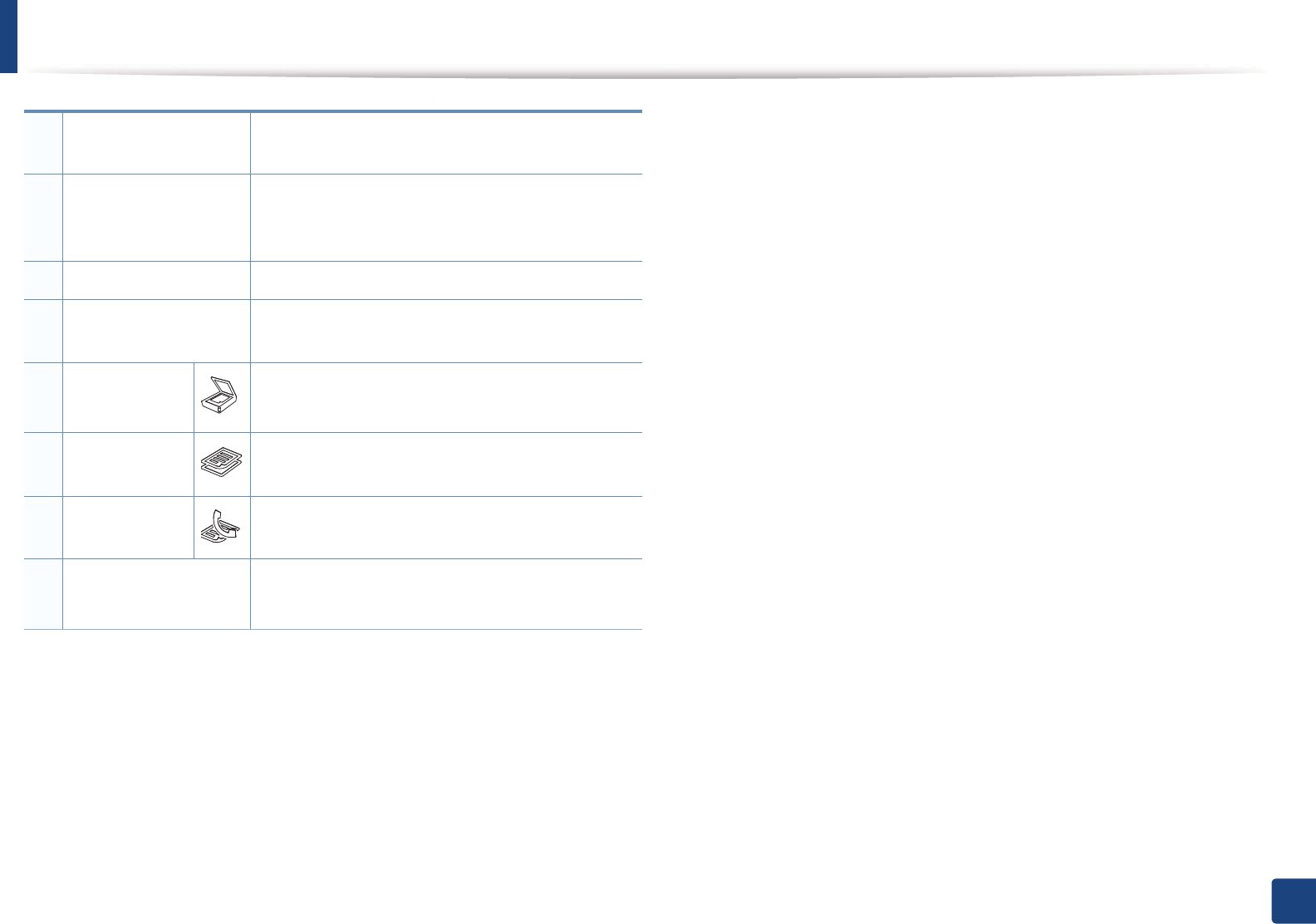
Control panel overview
24
1. Introduction
15 Multi Send Allows you to send a fax to (see "Sending a fax to
multiple destinations" on page 55).
16 Delay Send Allows you to send a fax at a later time when you
will not be present (see"Delaying a fax
transmission" on page 158).
17 Reduce/ Enlarge Makes a copy smaller or larger than the original.
18 Display screen Shows the current status and displays prompts
during an operation.
19 Scan Switches to Scan mode.
20 Copy Switches to Copy mode.
21 Fax Switches to Fax mode.
22 Numeric Keypad Dials a number or enters alphanumeric characters
(see "Keypad letters and numbers" on page 134).
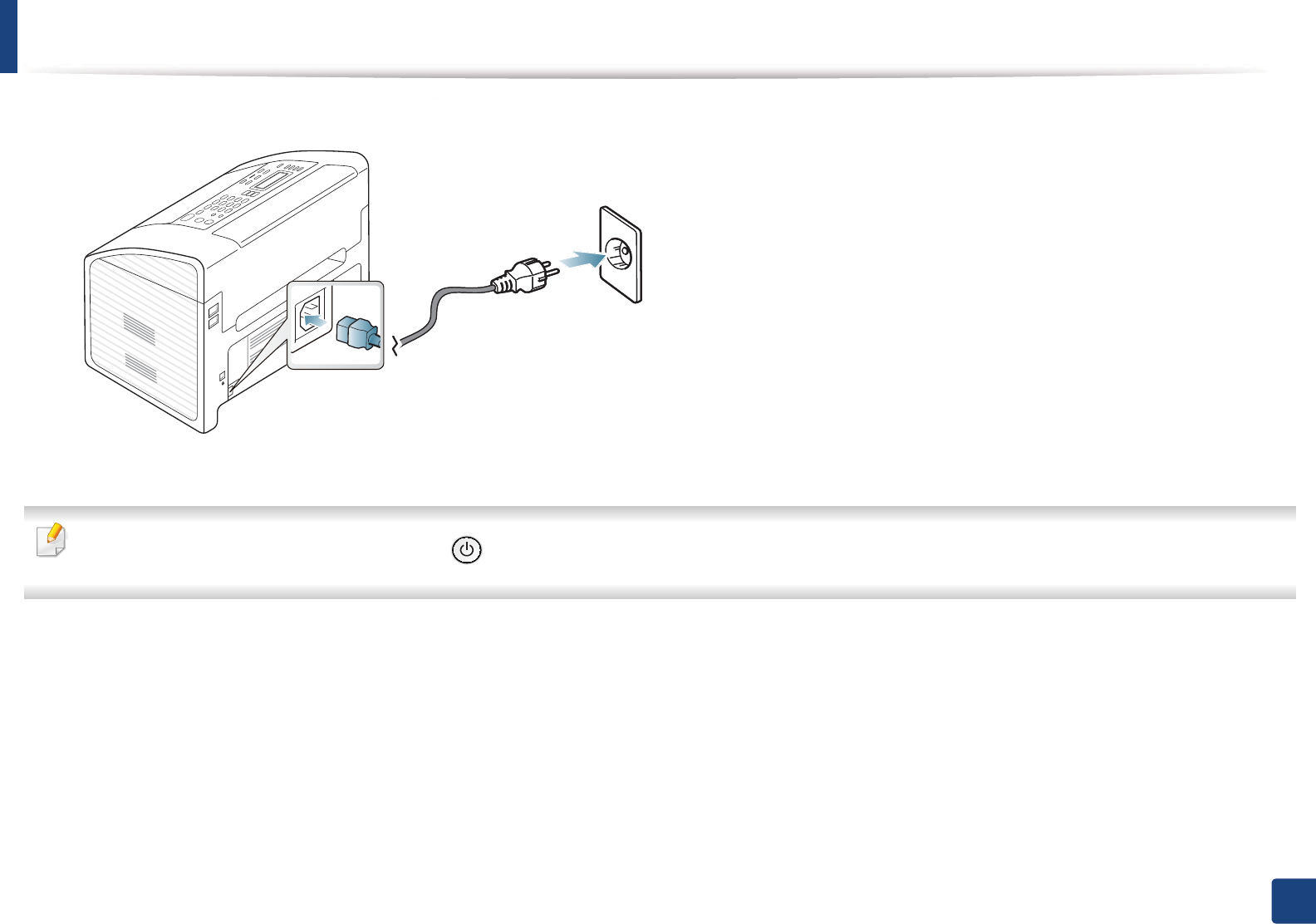
25
1. Introduction
Turning on the machine
1Connect the machine to the electricity supply first.
2 Power is turned on automatically.
If you want to turn the power off, press and hold (Power) button for about 3 seconds.
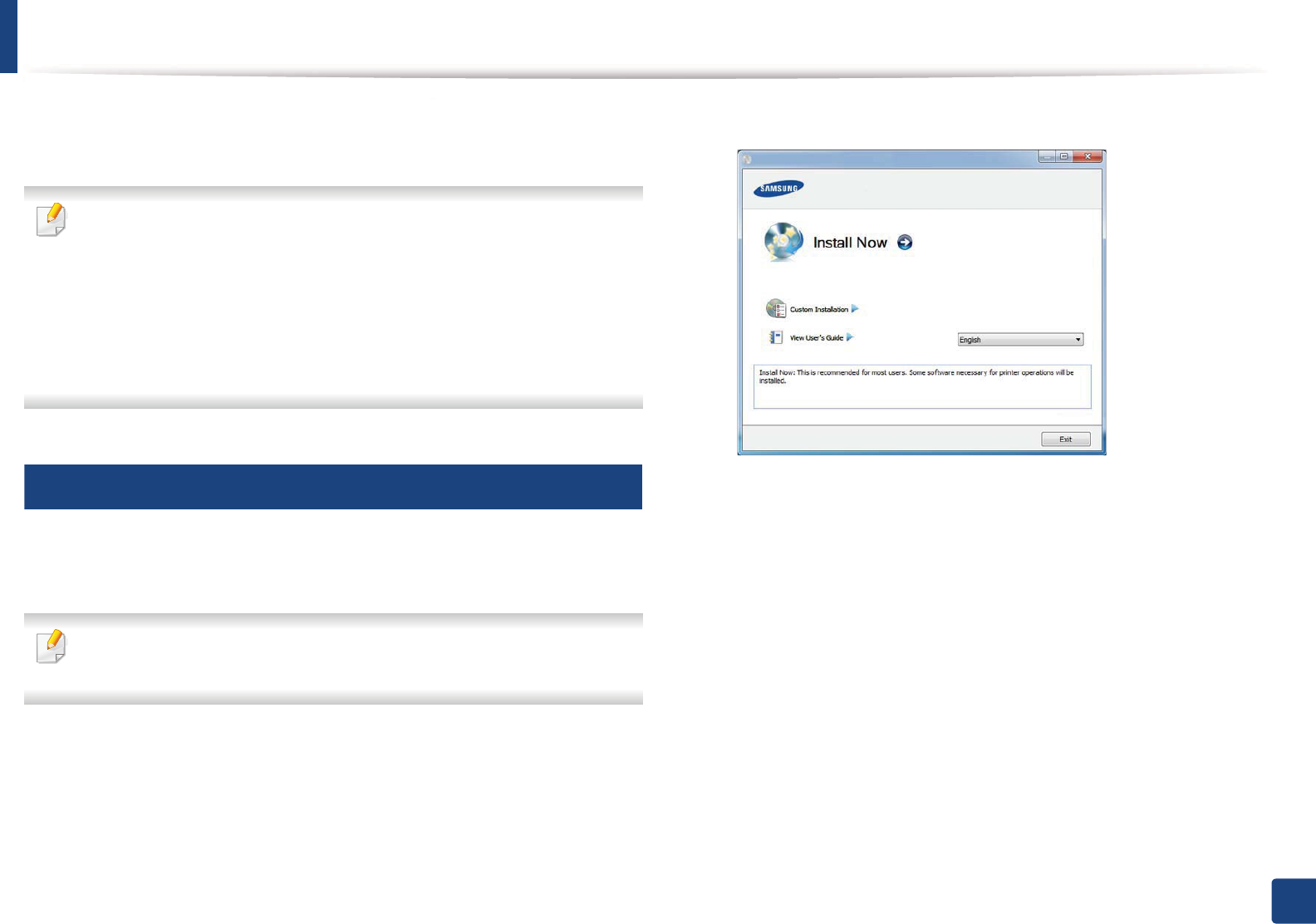
26
1. Introduction
Installing the driver locally
A locally connected machine is a machine directly attached to your computer
using the cable.
• If you are a Macintosh and Linux OS user, refer to the "Installation for
Macintosh" on page 114, "Installation for Linux" on page 116.
• The installation window in this User’s Guide may differ depending on the
machine and interface in use.
• Selecting Custom Installation allows you to choose which programs to
install.
• Only use a USB cable no longer than 3 meters (118 inches).
13
Windows
1Make sure that the machine is connected to your computer and
powered on.
If the “Found New Hardware Wizard” appears during the installation
procedure, click Cancel to close the window.
2 Insert the supplied software CD into your CD-ROM drive.
Click Start > All programs > Accessories > Run.
X:\Setup.exe replacing “X” with the letter, which represents your CD-
ROM drive and click OK.
3 Select Install Now.
4 Read the License Agreement, and select I accept the terms of the
License Agreement. Then, click Next.
5 Follow the instructions in the installation window.
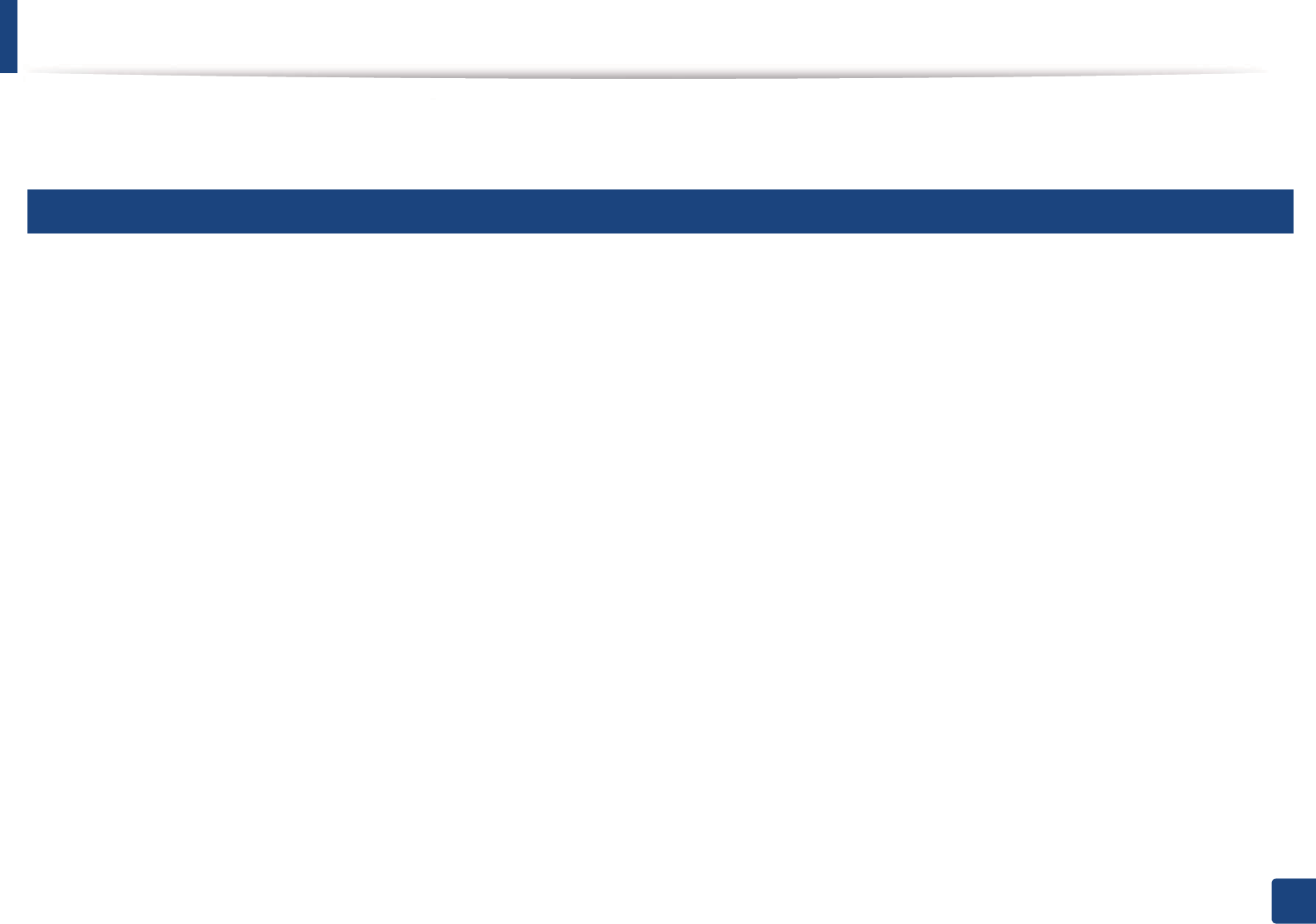
27
1. Introduction
Reinstalling the driver
If the printer driver does not work properly, follow the steps below to reinstall the driver.
14
Windows
1Make sure that the machine is connected to your computer and powered on.
2 From the Start menu, select Programs or All Programs > Samsung Printers > your printer driver name > Uninstall.
3 Follow the instructions in the installation window.
4 Insert the software CD into your CD-ROM drive and install the driver again (see "Installing the driver locally" on page 26).
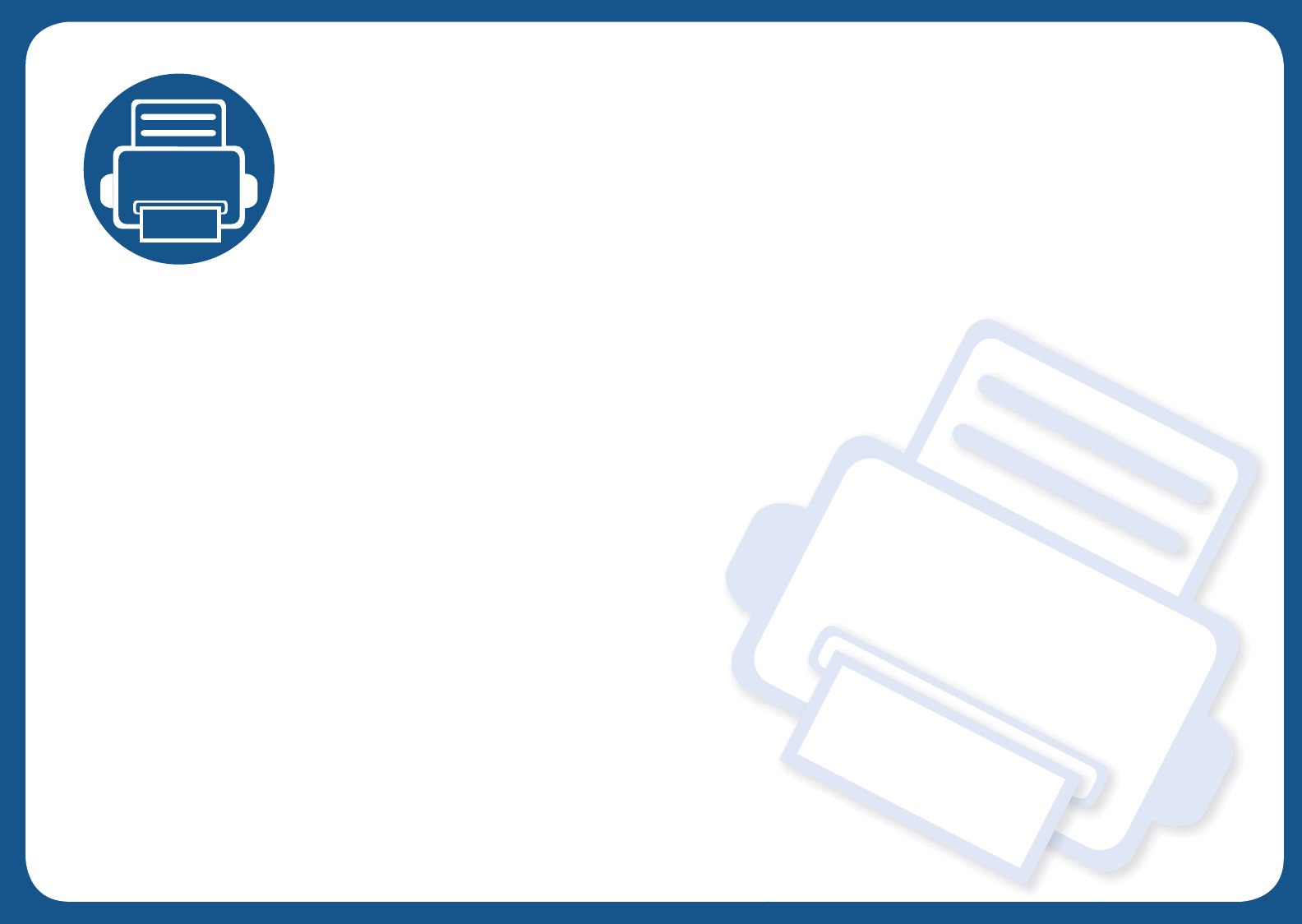
2. Menu Overview and
Basic Setup
This chapter provides information about the overall menu structure and the basic setup options.
• Menu overview 29
• Machine’s basic settings 34
• Media and tray 36
• Basic printing 46
• Basic copying 50
• Basic scanning 53
• Basic faxing 54
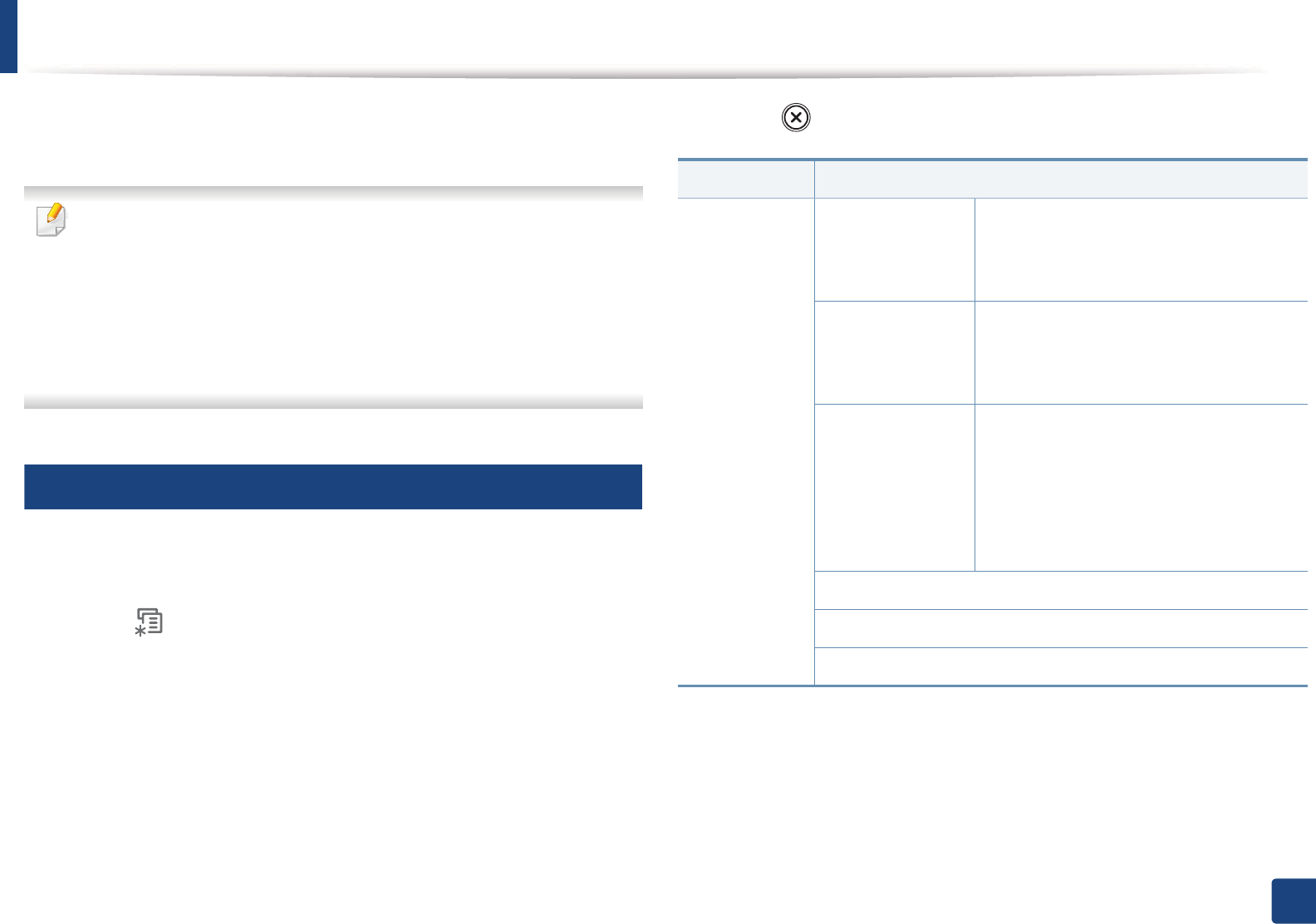
29
2. Menu Overview and Basic Setup
Menu overview
The control panel provides access to various menus to set up the machine or use
the machine’s functions.
• An asterisk (*) appears next to the currently selected menu.
• Some menus may not appear on the display depending on options or
models. If so, it is not applicable to your machine.
• Some menu names may differ from your machine depending on its
options or the models.
• The menus are described in the Advanced Guide (see "Useful Setting
Menus" on page 119).
1
Accessing the menu
1Select the Fax, Copy, or Scan button on the control panel depending on
the feature to be used.
2 Select (Menu) until the menu you want appears on the bottom line
of the display and press OK.
3 Press the left/right arrows until the needed menu item appears and press
OK.
4 If the setting item has sub menus, repeat step 3.
5 Press OK to save the selection.
6 Press (Stop/Clear) to return to the ready mode.
Items Options
Fax Feature Darkness Normal
Dark+1- Dark+5
Light+5- Light+1
Contrast Normal
Dark+1- Dark+5
Light+5- Light+1
Resolution Standard
Fine
Super Fine
Photo Fax
Color Fax
Scan Size
Multi Send
Delay Send

Menu overview
30
2. Menu Overview and Basic Setup
Fax Feature Priority Send
Forward Fax
PC
Secure Receive Off
On
Print
Add Page
Cancel Job
Fax Setup Sending Redial Times
Redial Term
Prefix Dial
ECM Mode
Send Report
Image TCR
Dial Mode a
Items Options
Fax Setup Receiving Receive Mode
Ring To Answer
Stamp RCV Name
RCV Start Code
Auto Reduction
Discard Size
Junk Fax Setup
DRPD Mode
Change Default Resolution
Darkness
Contrast
Scan Size
Auto Report On
Off
Copy Feature Scan Size
Reduce/Enlarge
Darkness Normal
Dark+1- Dark+5
Light+5- Light+1
Items Options

Menu overview
31
2. Menu Overview and Basic Setup
Copy Feature Contrast Normal
Dark+1- Dark+5
Light+5- Light+1
Original Type Text/Photo
Photo
Text
Layout Normal
2-Up
4-Up
Adjust Bkgd. Off
Auto
Enhance Lev.1
Enhance Lev.2
Erase Lev.1- Erase Lev.4
Items Options
Copy Setup Change Default Scan Size
Copies
Copy Collation
Reduce/Enlarge
Darkness
Contrast
Original Type
Adjust Bkgd.
Items Options

Menu overview
32
2. Menu Overview and Basic Setup
System Setup Machine Setup Machine ID
Fax Number
Date & Time
Clock Mode
Language
Power Save
Wakeup Event
System Timeout
Altitude Adj.
Auto Continueb
Paper Mismatch
Paper Substit.b
Toner Save
Paper Setup Paper Size
Paper Type
Margin
Items Options
System Setup Sound/Volume Key Sound
Alarm Sound
Speaker
Ringer
Report All Report
Configuration
Supplies Info.
Address Book
Fax Send
Fax Sent
Fax Received
Schedule Jobs
Junk Fax
Usage Counter
Fax Options
Maintenance CLR Empty Msgc
Supplies Life
Serial No.
TonerLow Alert
Adjust Shading
Items Options
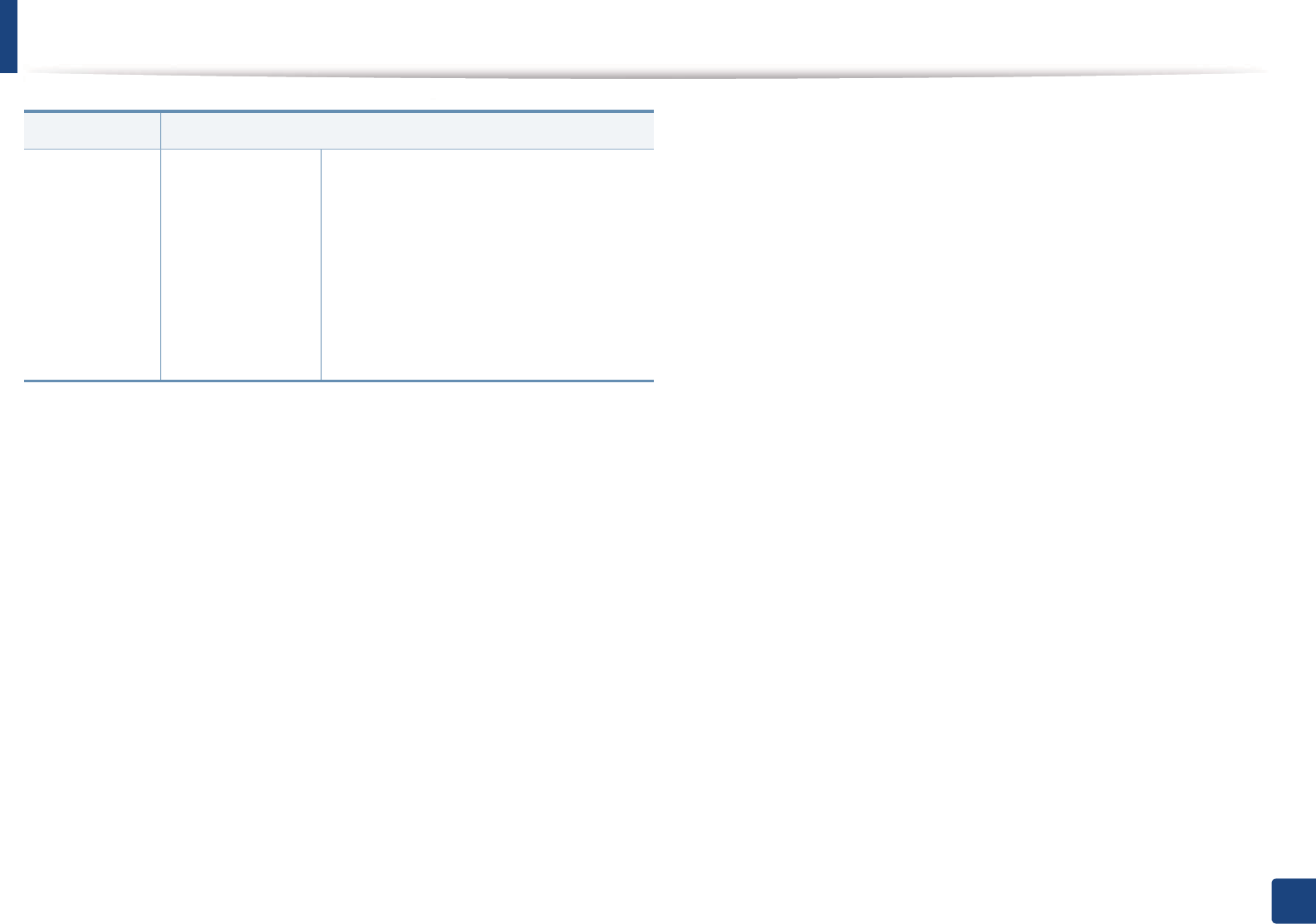
Menu overview
33
2. Menu Overview and Basic Setup
System Setup Clear Setting All Settings
Fax Setup
Copy Setup
System Setup
Address Book
Fax Sent
Fax Received
a. This setting may not be available depending on your country.
b. This option only appears if “paper mismatch” is enabled.
c. This option only appears when small amount of toner is left in the cartridge.
Items Options
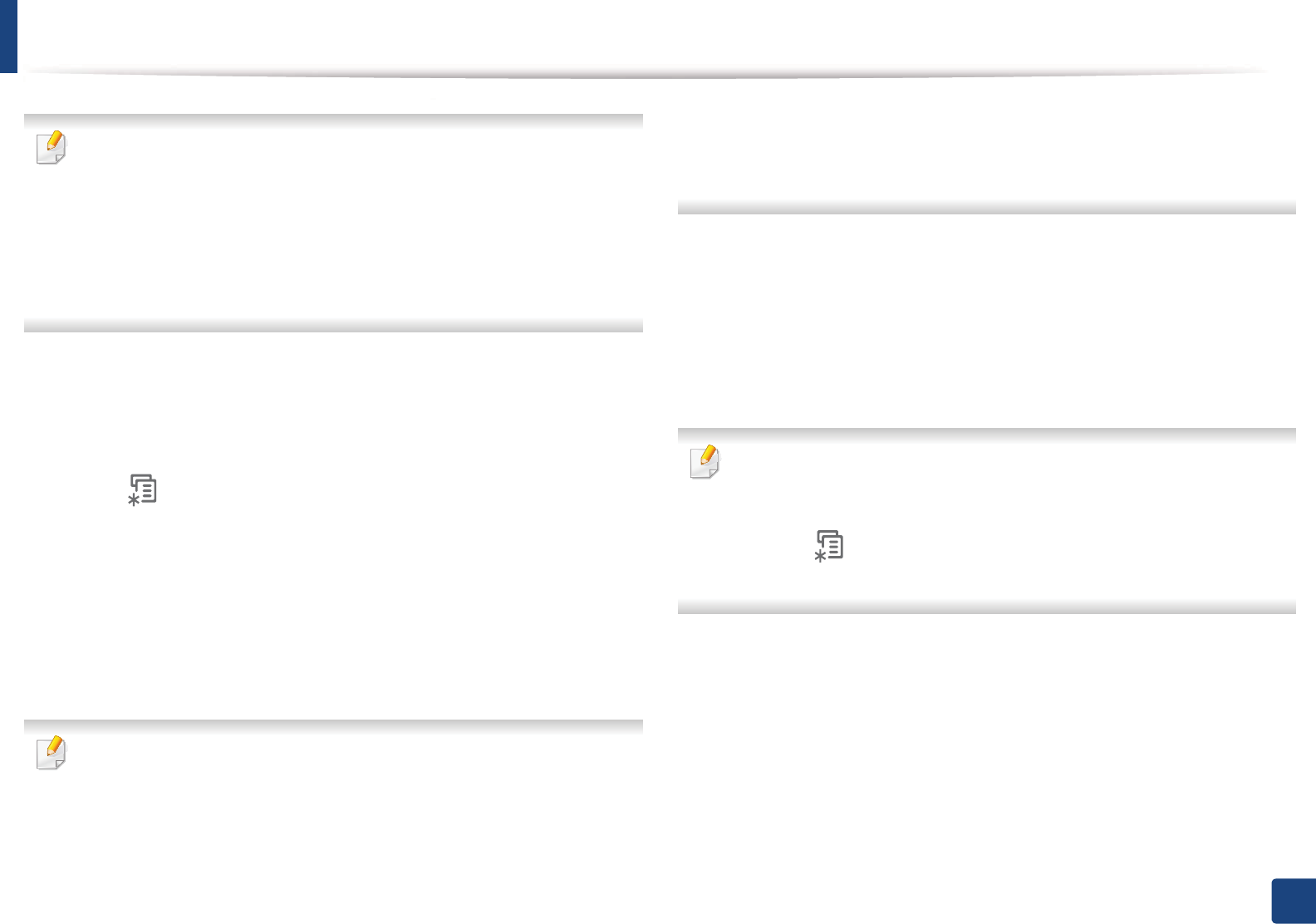
34
2. Menu Overview and Basic Setup
Machine’s basic settings
• It may be necessary to press OK to navigate to lower-level menus for
some models.
• You can set the machine’s settings by using the Device Settings in
6DPVXQJ(DV\3ULQWHU0DQDJHUprogram or Machine section in
Printer Settings Utility program.
- For Windows and Macintosh users, see "Device Settings" on page 172.
- For Linux users, see "Using Smart Panel" on page 175.
After installation is complete, you may want to set the machine's default
settings.
To change the machine’s default settings, follow these steps:
1Press (Menu) button on the control panel.
2 Press System Setup > Machine Setup.
3 Select the option you want, then press OK.
•Date & Time: When you set the time and date, they are used in delay
fax and delay print. They are printed on reports. If, however, they are
not correct, you need to change it for the correct time being.
Enter the correct time and date using arrows or numeric keypad (see
"Keypad letters and numbers" on page 134).
• Month = 01 to 12,
• Day = 01 to 31,
• Year = requires four digits,
• Hour = 01 to 12,
• Minute = 00 to 59,
•Clock Mode: You can set your machine to display the current time
using either a 12-hour or 24-hour format.
•Language: change the language that is displayed on the control
panel.
•Power Save: When you are not using the machine for a while, use
this feature to save power.
• To wake the machine from power save mode, press the power button,
start printing, or receive a fax.
• The machine can also be woken up by pressing any other button by
setting (Menu) > System Setup > Machine Setup > Wakeup Event
> Button Press > On.
•Altitude Adj.: Print quality is affected by atmospheric pressure,
which atmospheric pressure is determined by the height of the
machine above sea level (see "Altitude adjustment" on page 133).
•Toner Save: Toner save mode allows your machine to use less toner
on each page. Activating this mode extends the life of the toner
cartridge beyond what one would experience in the normal mode,
but it reduces print quality.
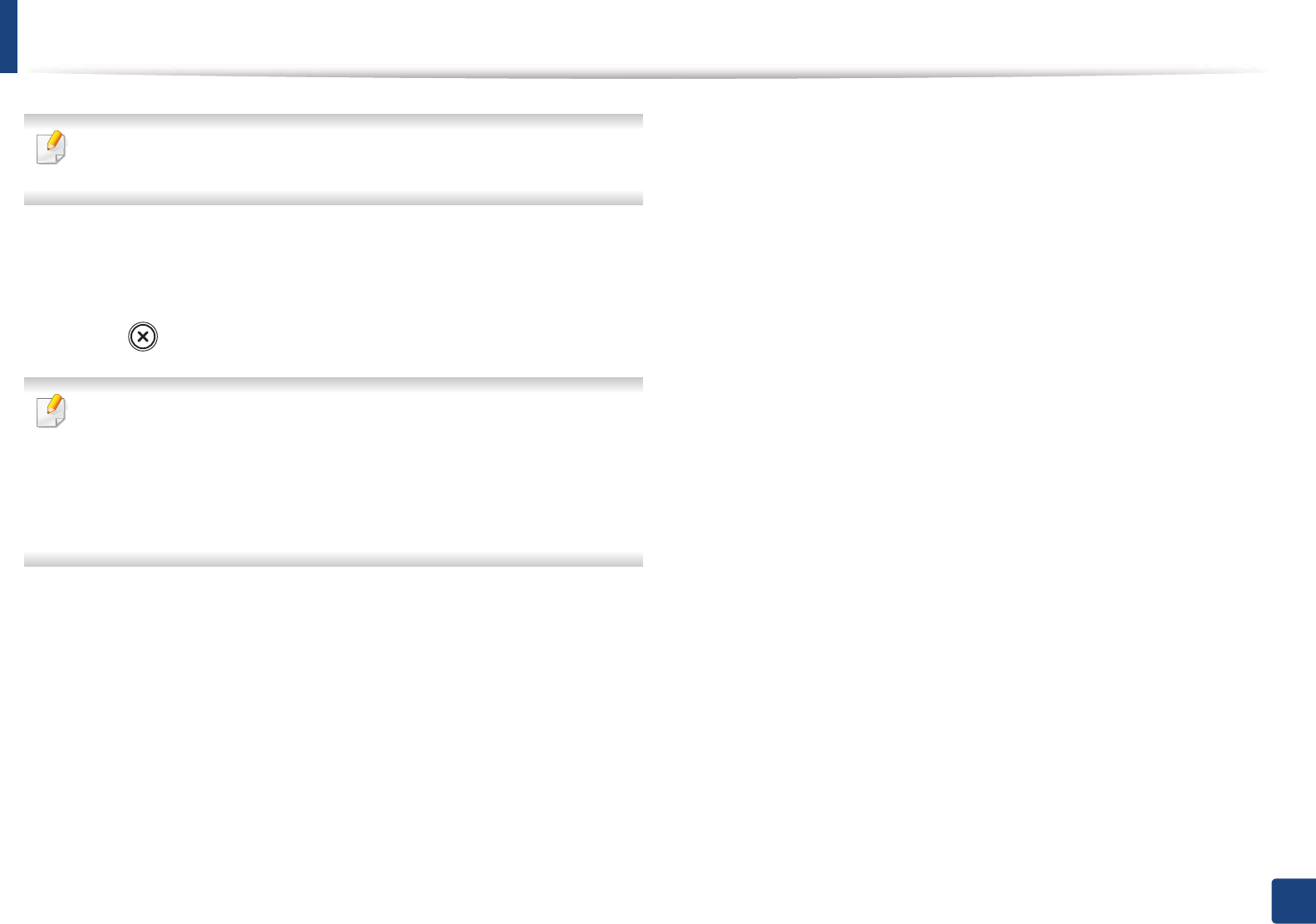
Machine’s basic settings
35
2. Menu Overview and Basic Setup
When PC-printing, you can also turn on or off toner save mode in the printer
properties.
4 Select the option you want, then press OK.
5 Press OK to save the selection.
6 Press (Stop/Clear) to return to ready mode.
Refer to below links to set other settings useful for using the machine.
• See “"Entering various characters" on page 134.
• See "Keypad letters and numbers" on page 134.
• See "Setting the paper size and type" on page 43.
• See "Setting up the address book" on page 135.
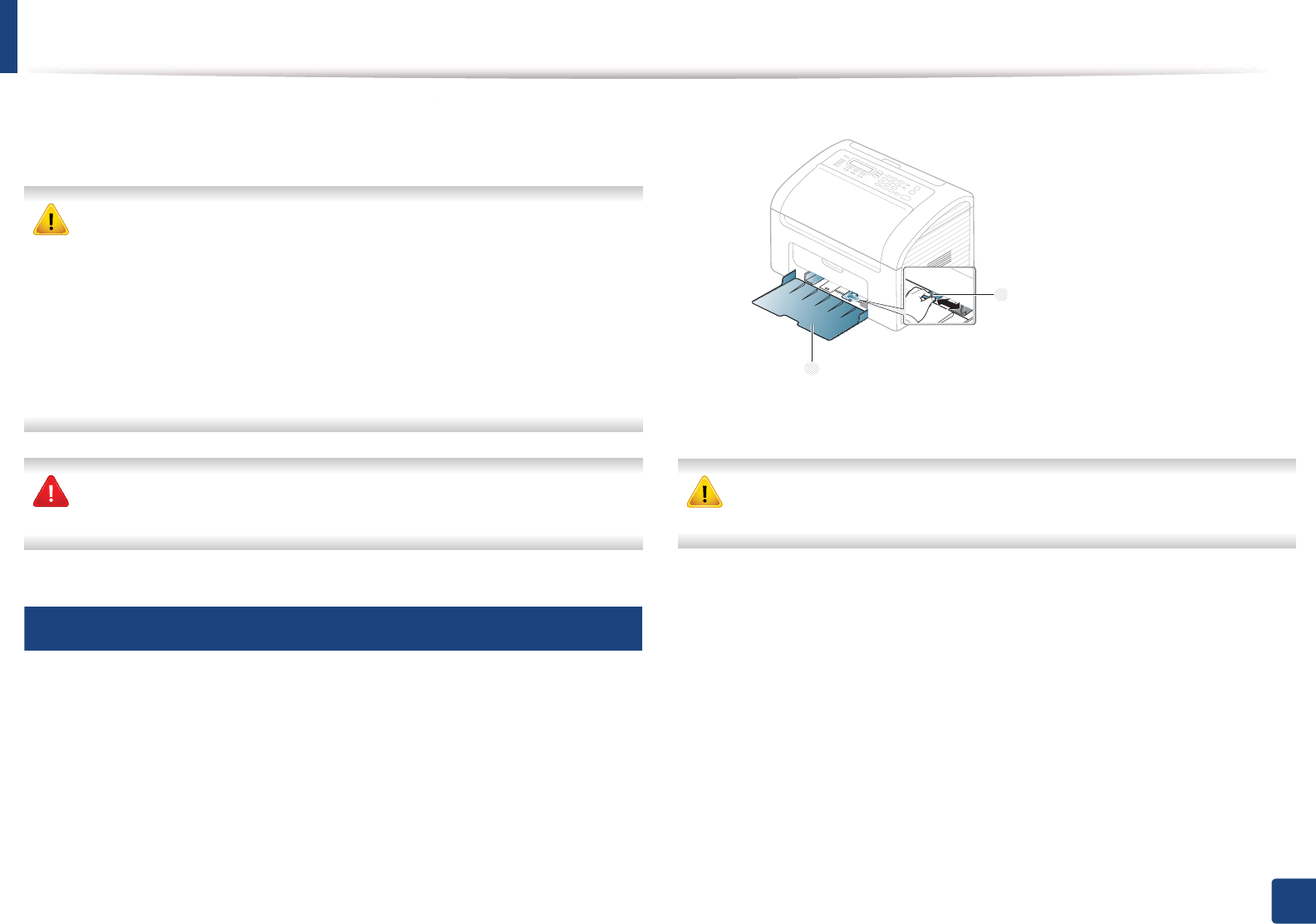
36
2. Menu Overview and Basic Setup
Media and tray
This chapter provides information on how to load print media into your
machine.
• Using print media that does not meet these specifications may cause
problems or require repairs. Such repairs are not covered by Samsung’s
warranty or service agreements.
• Make sure not to use the inkjet photo paper with this machine. It could
cause damage to the machine.
• Using inflammable print media can cause a fire.
• Use designated print mediaG(see "Print media specifications" on page
94).
The use of inflammable media or foreign materials left in the printer may
lead to overheating of the unit andS in rare cases may cause a fire.
2
Tray overview
To change the size, you need to adjust the paper guides.
If you do not adjust the guide, it may cause paper registration, image skew,
or jamming of the paper.
1 Paper width guide
2Tray
1
2
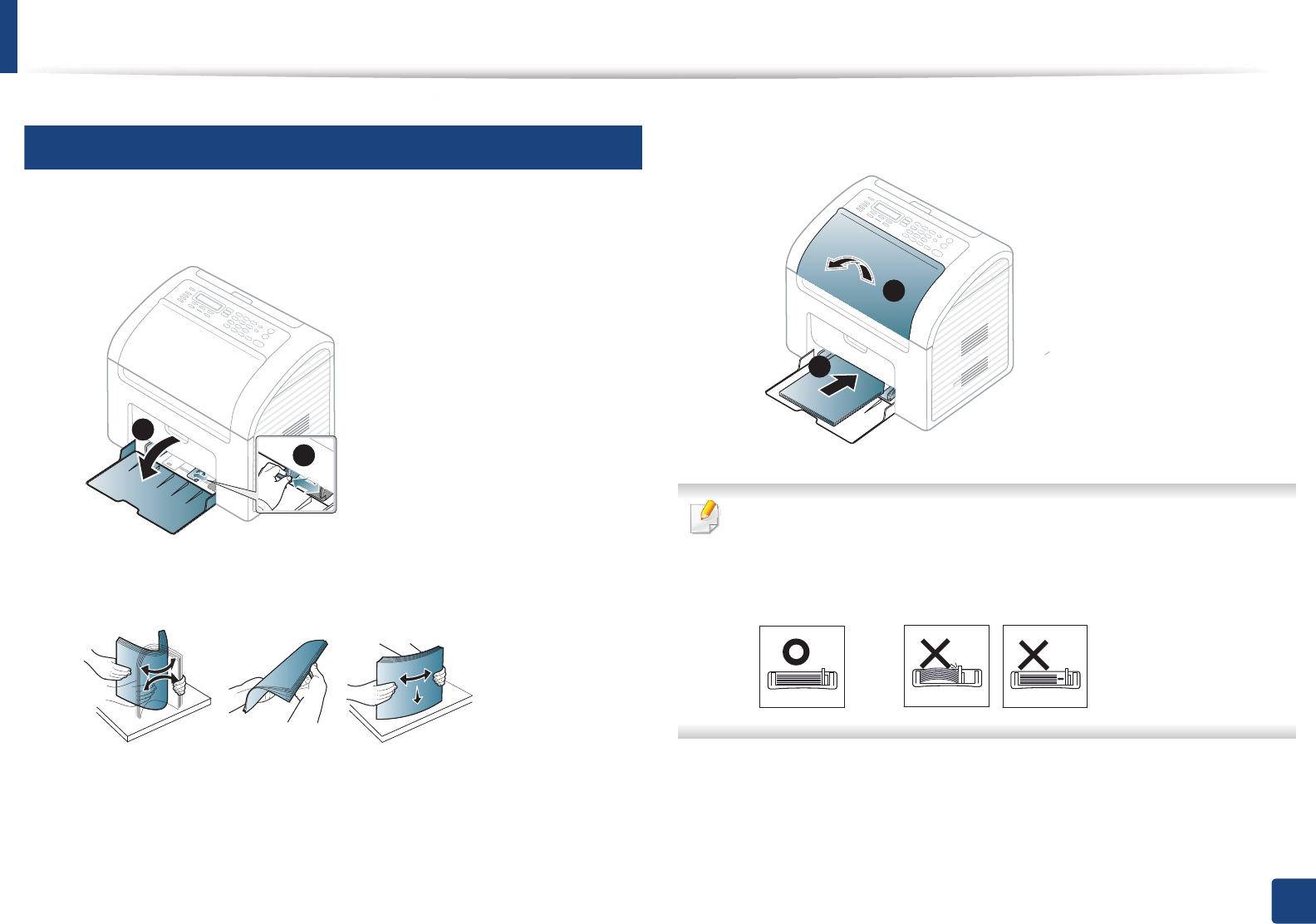
Media and tray
37
2. Menu Overview and Basic Setup
3
Loading paper in the tray
1Open the tray. Then, adjust the tray size to the media size you are loading
(see "Tray overview" on page 36.)
2 Flex or fan the edge of the paper stack to separate the pages before
loading papers.
3 Place the paper with the side you want to print facing up and open the
output tray.
• Do not push the paper width guide too far causing the media to warp.
• Do not use a paper with a leading-edge curl, it may cause a paper jam or
the paper can be wrinkled.
• If you do not adjust the paper width guide, it may cause paper jams.
1
2
1
2
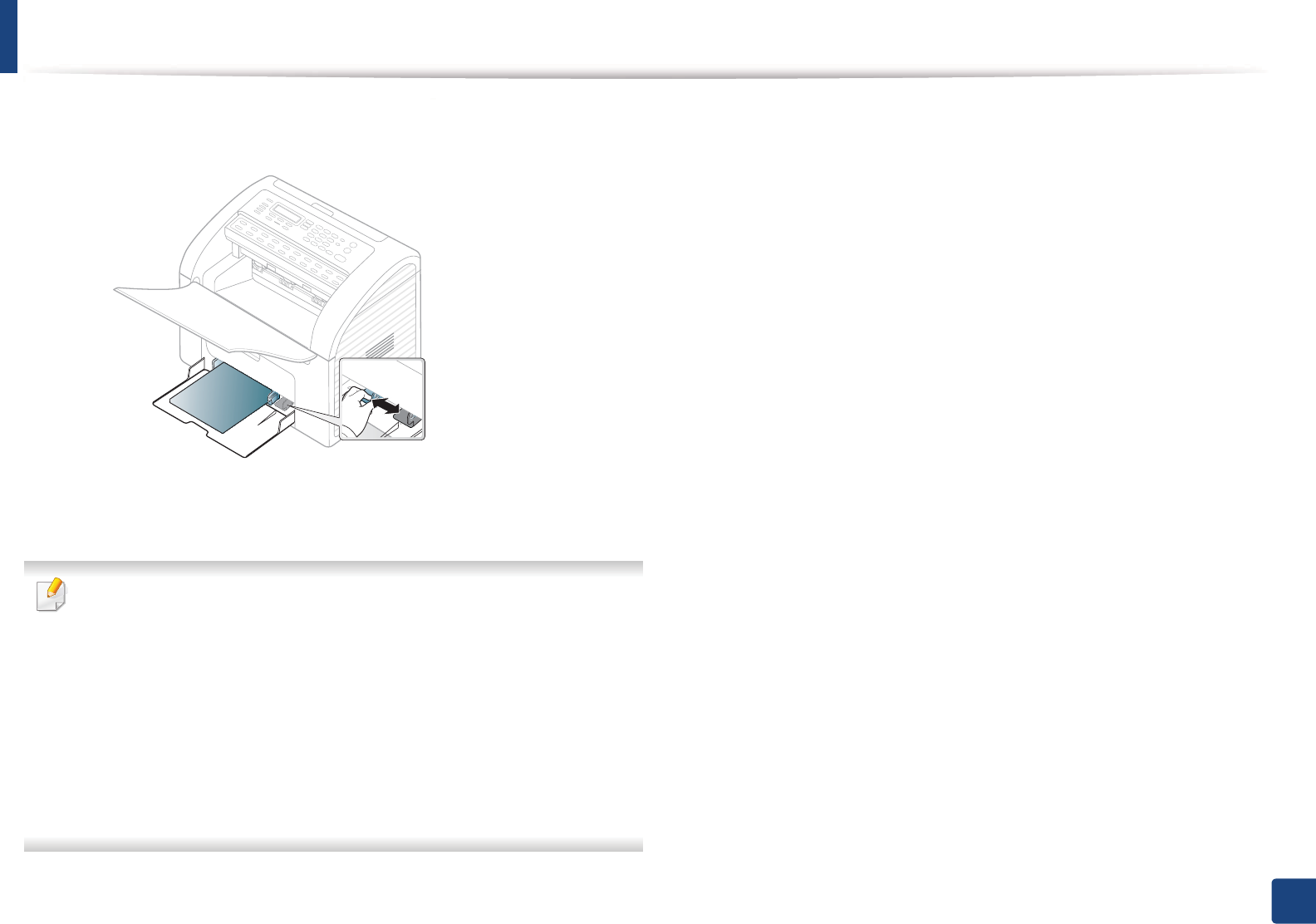
Media and tray
38
2. Menu Overview and Basic Setup
4 Squeeze the paper width guide and slide it to the edge of the paper stack
without causing it to bend.
5 When you print a document, set the paper type and size for the tray (see
"Setting the paper size and type" on page 43).
The settings made from the machine driver override the settings on the
control panel.
a To print in application, open an application and start the print menu.
b Open Printing Preferences (see "Opening printing preferences" on
page 48).
c Press the Paper tab in Printing Preferences, and select an appropriate
paper type.
For example, if you want to use a label, set the paper type to Label.
d Select Manual Feeder in paper source, then press OK.
e Start printing in application.
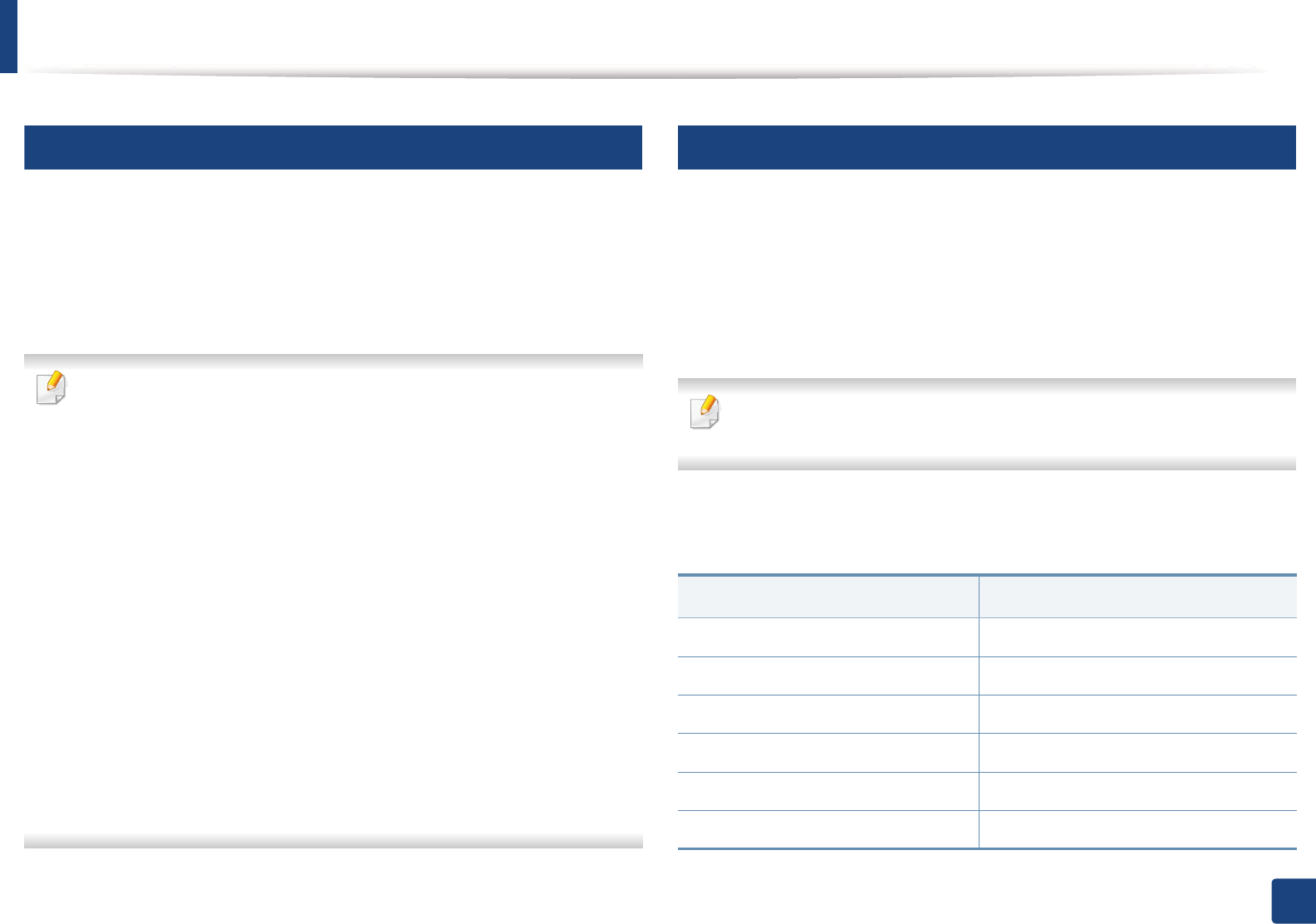
Media and tray
39
2. Menu Overview and Basic Setup
4
Manual feeding in the tray
The tray can hold special sizes and types of print material, such as postcards,
note cards, and envelopes (see "Print media specifications" on page 94).
To feed manually in the tray,
G
click the below:
See "Loading paper in the tray" on page 37.
Tips on using the manual feeding in tray
•If you select Paper > Source > Manual Feeder from your printer driver,
you need to press OK each time you print a page.
• To prevent paper jams, do not add paper while printing when there is still
paper in the manual feeder.
• Print media should be loaded face up with the top edge going into the
manual feeder first and be placed in the center of the tray.
• To ensure printing quality and to prevent paper jams, only load the
available paper (see "Print media specifications" on page 94).
• Flatten any curl on postcards, envelopes, and labels before loading them
into the manual feeder.
• When printing on special media, you must follow the loading guidelines
(see "Printing on special media" on page 39).
• When papers overlap when printing using the manual feeder, open tray
and remove the papers then try printing again.
• Load only one type, size and weight of print media at time in the in the
tray.
5
Printing on special media
The table below shows the special media usable in each tray.
The media is also shown in the Printing Preferences. To get the higest printing
quality, select the proper media type from the Printing preferences window >
Paper tab > Paper Type (see "Opening printing preferences" on page 48).
For example, if you want to print on labels, select Labels for Paper Type.
When using special media, we recommend you feed one sheet at a time (see
"Print media specifications" on page 94).
To see for paper weights for each sheet, refer to "Print media specifications" on
page 94.
Types Traya
Plain Ɣ
Thick Ɣ
Thin Ɣ
Bond Ɣ
Color Ɣ
CardStock Ɣ
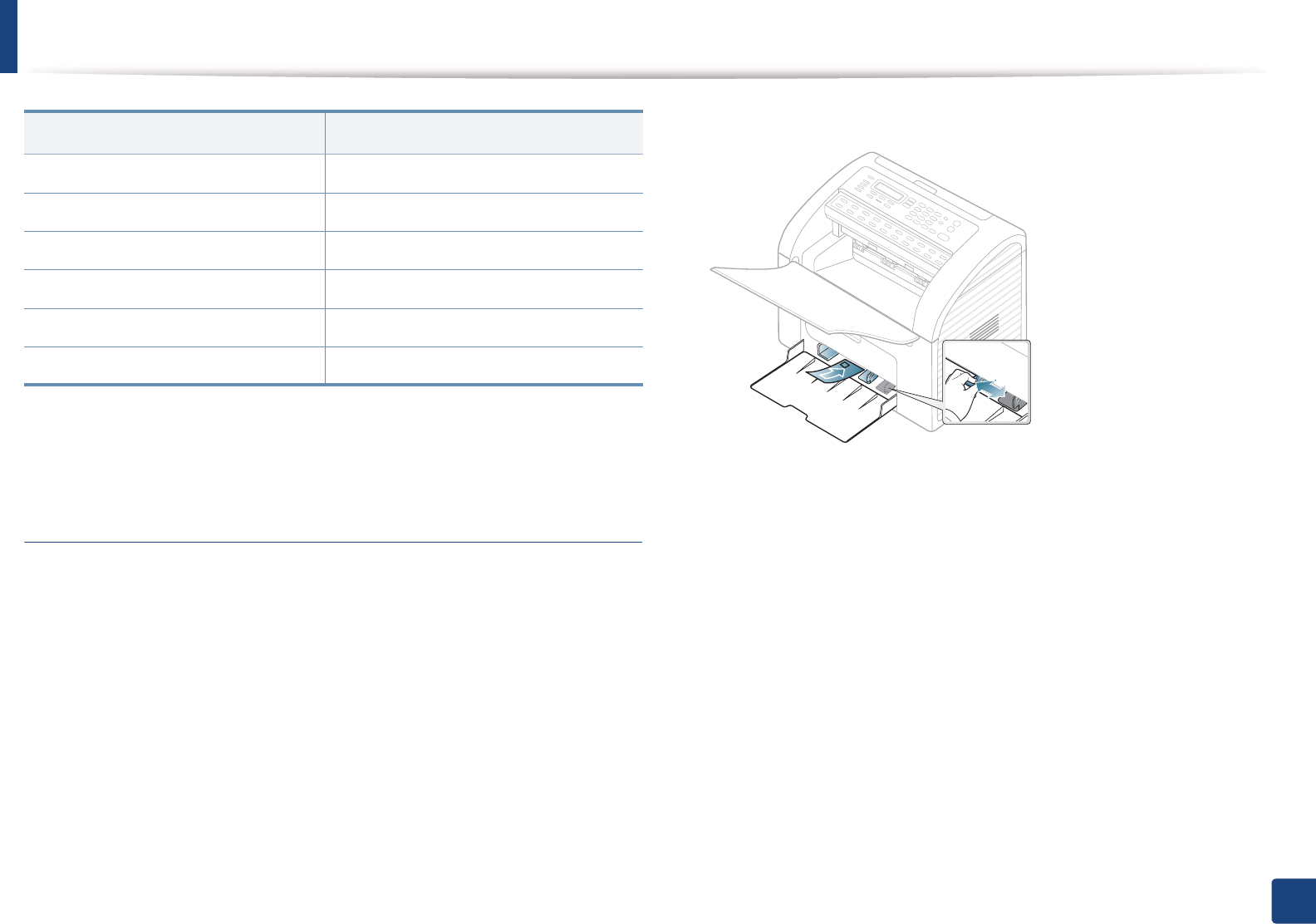
Media and tray
40
2. Menu Overview and Basic Setup
(Ɣ: Included, Blank: Not available)
Envelope
Printing successfully on envelopes depends upon the quality of the envelopes.
To print an envelope, place it as shown in the following figure.
• When selecting envelopes, consider the following factors:
-Weight: should not exceed 90 g/m2 otherwise; jams may occur.
-Construction: should lie flat with less than 6 mm curl and should not
contain air.
-Condition: should not be wrinkled, nicked, nor damaged.
-Temperature: should resist the heat and pressure of the machine
during operation.
• Use only well-constructed envelopes with sharp and well-creased folds.
• Do not use stamped envelopes.
• Do not use envelopes with clasps, snaps, windows, coated lining, self-
adhesive seals, or other synthetic materials.
• Do not use damaged or poorly made envelopes.
Labels Ɣ
Envelope Ɣ
Preprinted Ɣ
Cotton Ɣ
Recycled Ɣ
Archive Ɣ
a. The paper types available manual feeding in tray.
Types Traya
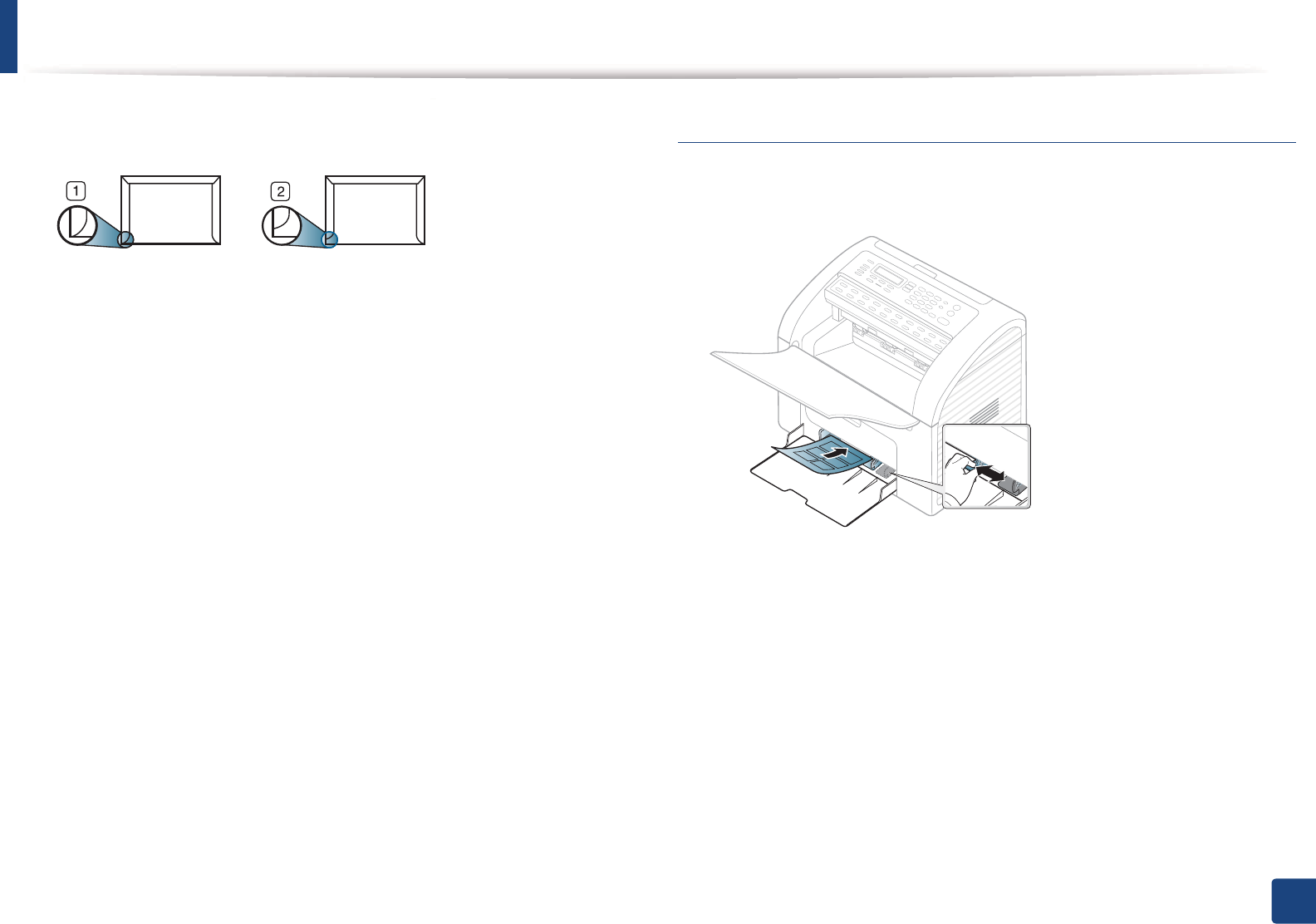
Media and tray
41
2. Menu Overview and Basic Setup
• Be sure the seam at both ends of the envelope extends all the way to the
corner of the envelope.
1 Acceptable
2 Unacceptable
• Envelopes with a peel-off adhesive strip or with more than one flap that
folds over to seal must use adhesives compatible with the machine’s fusing
temperature for 0.1 second about 170°C (338 °F). The extra flaps and strips
might cause wrinkling, creasing, or jams, and may even damage the fuser.
• For the best print quality, position margins no closer than 15 mm from the
edges of the envelope.
• Avoid printing over the area where the envelope’s seams meet.
Labels
To avoid damaging the machine, use only labels designed for use in laser
printers.
• When selecting labels, consider the following factors:
-Adhesives: Should be stable at your machine’s fusing temperatureG
(about 170°C (338°F)).
-Arrangement: Only use labels with no exposed backing between them.
Labels can peel off sheets that have spaces between the labels, causing
serious jams.
-Curl: Must lie flat with no more than 13 mm of curl in any direction.
-Condition: Do not use labels with wrinkles, bubbles, or other
indications of separation.
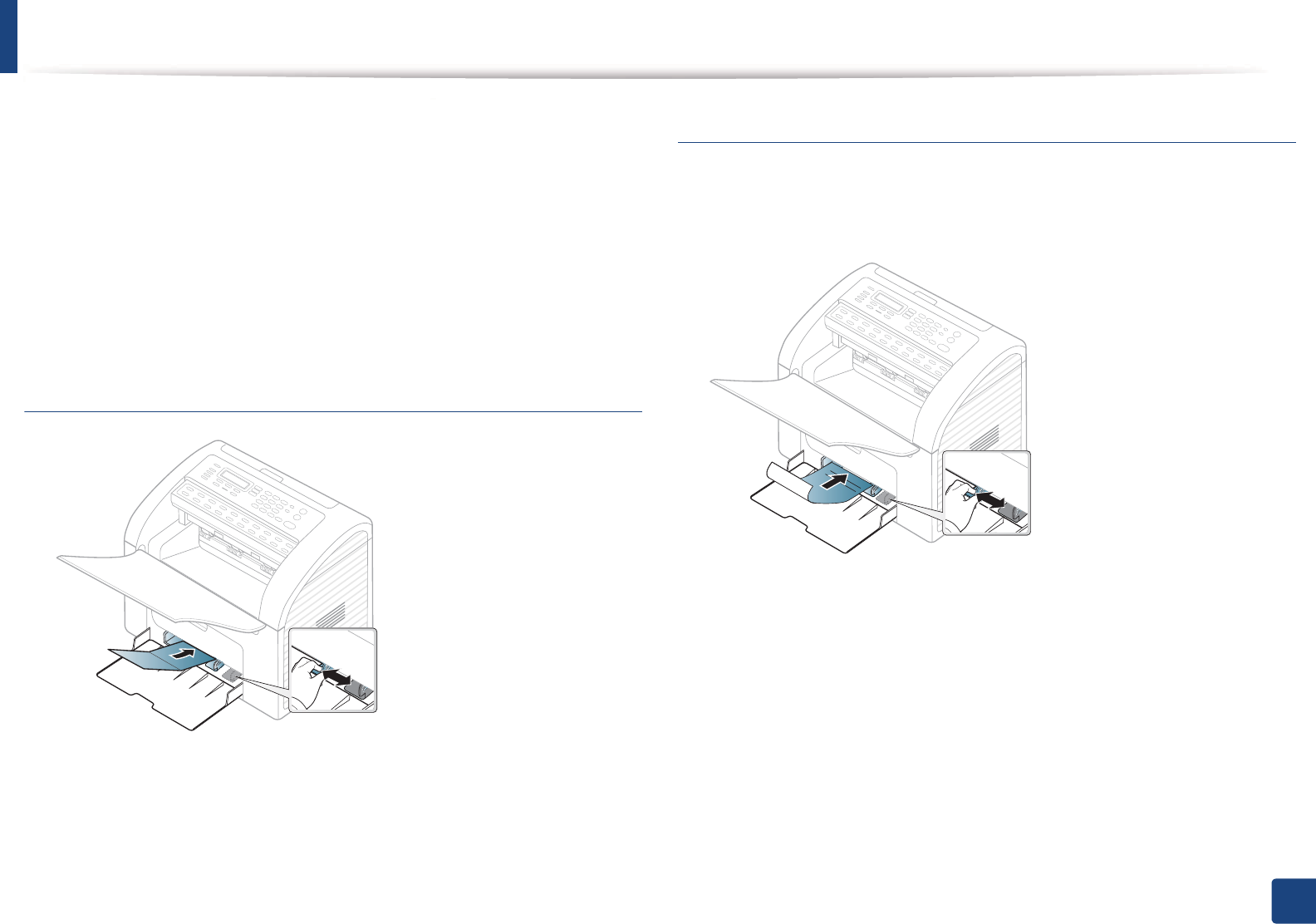
Media and tray
42
2. Menu Overview and Basic Setup
• Make sure that there is no exposed adhesive material between labels.
Exposed areas can cause labels to peel off during printing, which can cause
paper jams. Exposed adhesive can also cause damage to machine
components.
• Do not run a sheet of labels through the machine more than once. The
adhesive backing is designed for only a single pass through the machine.
• Do not use labels that are separating from the backing sheet or are wrinkled,
bubbled, or otherwise damaged.
Card stock/ Custom-sized paper
• In the software application, set the margins to at least 6.4 mm (0.25 inches)
away from the edges of the material.
Preprinted paper
When loading preprinted paper, the printed side should be facing up with an
uncurled edge at the front. If you experience problems with paper feeding, turn
the paper around. Note that print quality is not guaranteed.
• Must be printed with heat-resistant ink that will not melt, vaporize, or
release hazardous emissions when subjected to the machine’s fusing
temperature for 0.1 second (about 170°C (338°F)).
• Preprinted paper ink must be non-flammable and should not adversely
affect machine rollers.
• Before you load preprinted paper, verify that the ink on the paper is dry.
During the fusing process, wet ink can come off preprinted paper, reducing
print quality.

Media and tray
43
2. Menu Overview and Basic Setup
6
Setting the paper size and type
After loading paper in the paper tray, set the paper size and type using the
control panel buttons.
• It may be necessary to press OK to navigate to lower-level menus for
some models.
• You can set the machine’s settings by using the Device Settings in
6DPVXQJ(DV\3ULQWHU0DQDJHUprogram or Machine section in
Printer Settings Utility program.
- For Windows and Macintosh users, see "Device Settings" on page 172.
- For Linux users, see "Using Smart Panel" on page 175.
1Select (Menu) > System Setup > Paper Setup > Paper Size or
Paper Type on the control panel.
2 Select the tray and the option you want.
3 Press OK to save the selection.
4 Press (Stop/Clear) to return to ready mode.
• The settings set from the machine driver override the settings on the
control panel.
a To print from an application, open an application and start the print
menu.
b Open Printing Preferences (see "Opening printing preferences" on
page 48).
c Press the Paper tabGand select an appropriate paper.
• If you want to use special-sized paper such as billing paper, select the
Paper tab > Size > Edit... and set Custom
G
Paper Size Settings in the
Printing Preferences (see "Opening printing preferences" on page 48).
7
Using the output tray
The surface of the output tray may become hot if you print a large number
of pages at once. Make sure that you do not touch the surface, and do not
allow children near it.
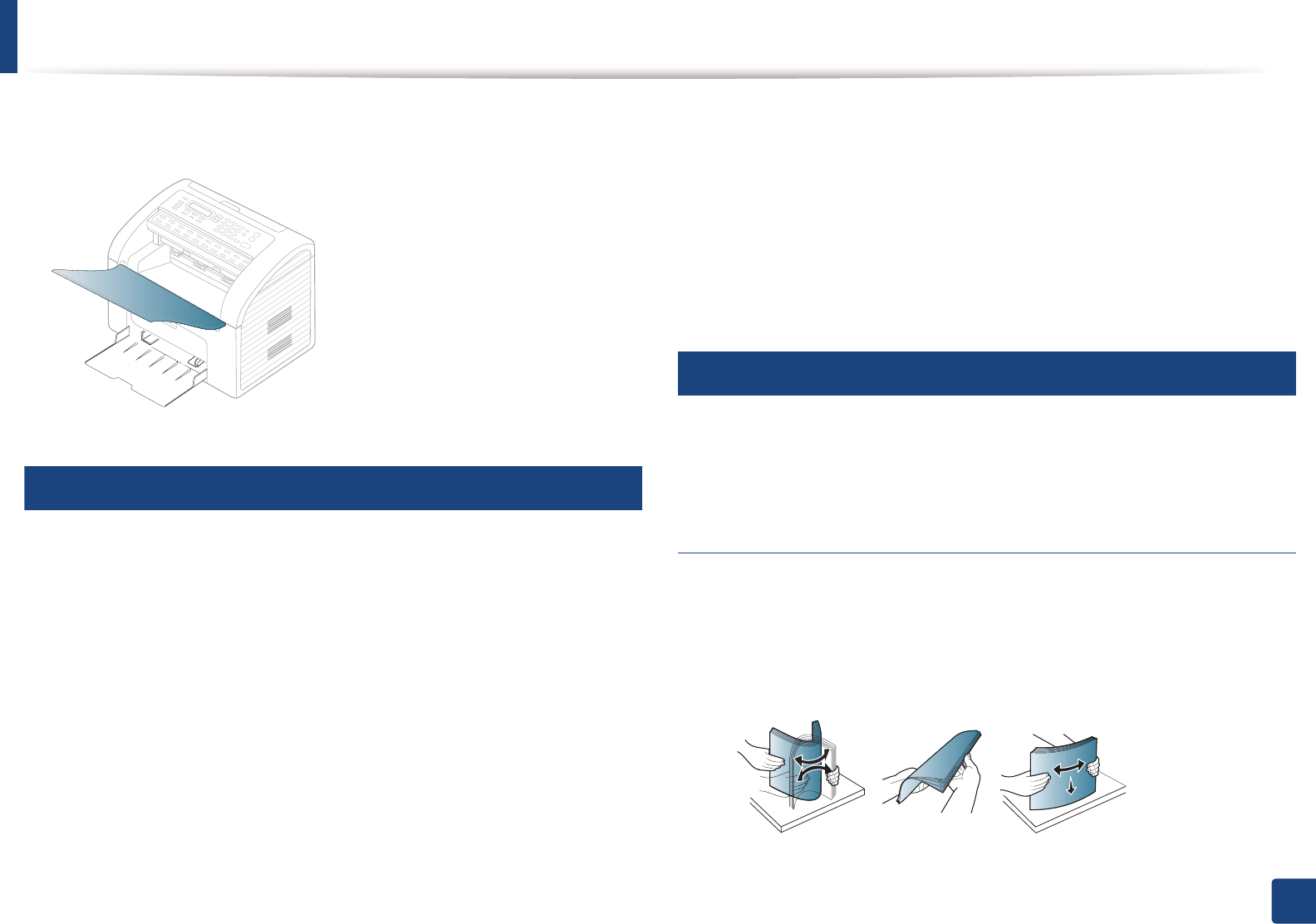
Media and tray
44
2. Menu Overview and Basic Setup
The printed pages stack on the output tray. The printer sends output to the
output tray by default.
8
Preparing originals
• Do not load paper smaller than 142 x 148 mm (5.6 x 5.8 inches) or larger than
216 x 356 mm (8.5 x 14 inches).
• Do not attempt to load the following s of paper, in order to prevent paper
jam, low print quality and machine damage.
- Carbon-paper or carbon-backed paper
- Coated paper
- Onion skin or thin paper
- Wrinkled or creased paper
- Curled or rolled paper
- Torn paper
• Remove all staples and paper clips before loading.
• Make sure any glue, ink, or correction fluid on the paper is completely dry
before loading.
• Do not load originals that include different sizes or weights of paper.
• Do not load booklets, pamphlets, transparencies, or documents with other
unusual characteristics.
9
Loading originals
You can use the document feeder to load an original for copying, scanning, and
sending a fax.
In the document feeder
Using the document feeder, you can load up to 20 sheets of paper (80 g/m2, 20
lbs bond) for one job.
1Flex or fan the edge of the paper stack to separate the pages before
loading originals.
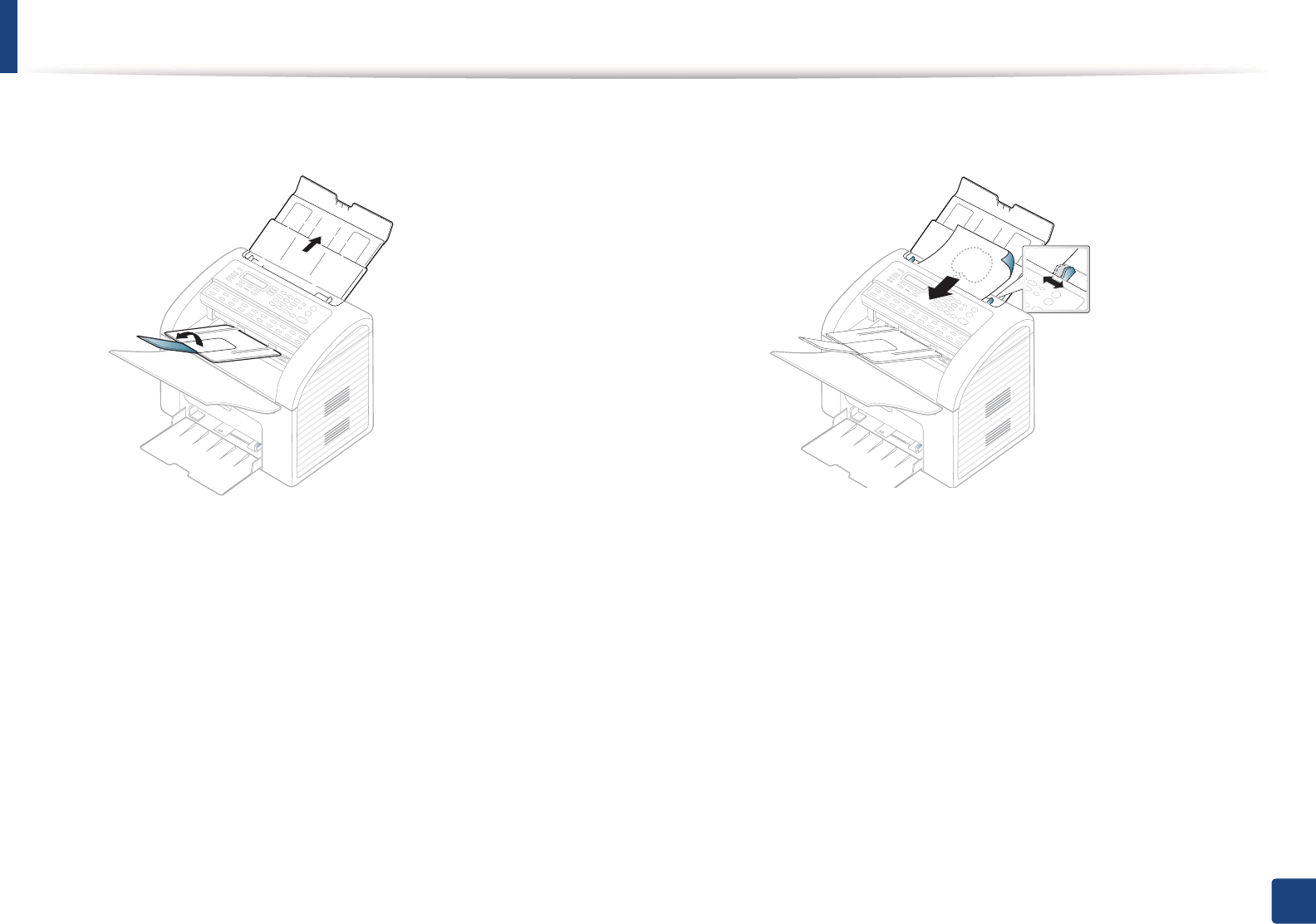
Media and tray
45
2. Menu Overview and Basic Setup
2 Pull the document feeder input tray or document feeder output tray all
the way out. Fold out the extender, if necessary. 3 Load the original face down into the document feeder input tray. Adjust
the document feeder width guides to the paper size.
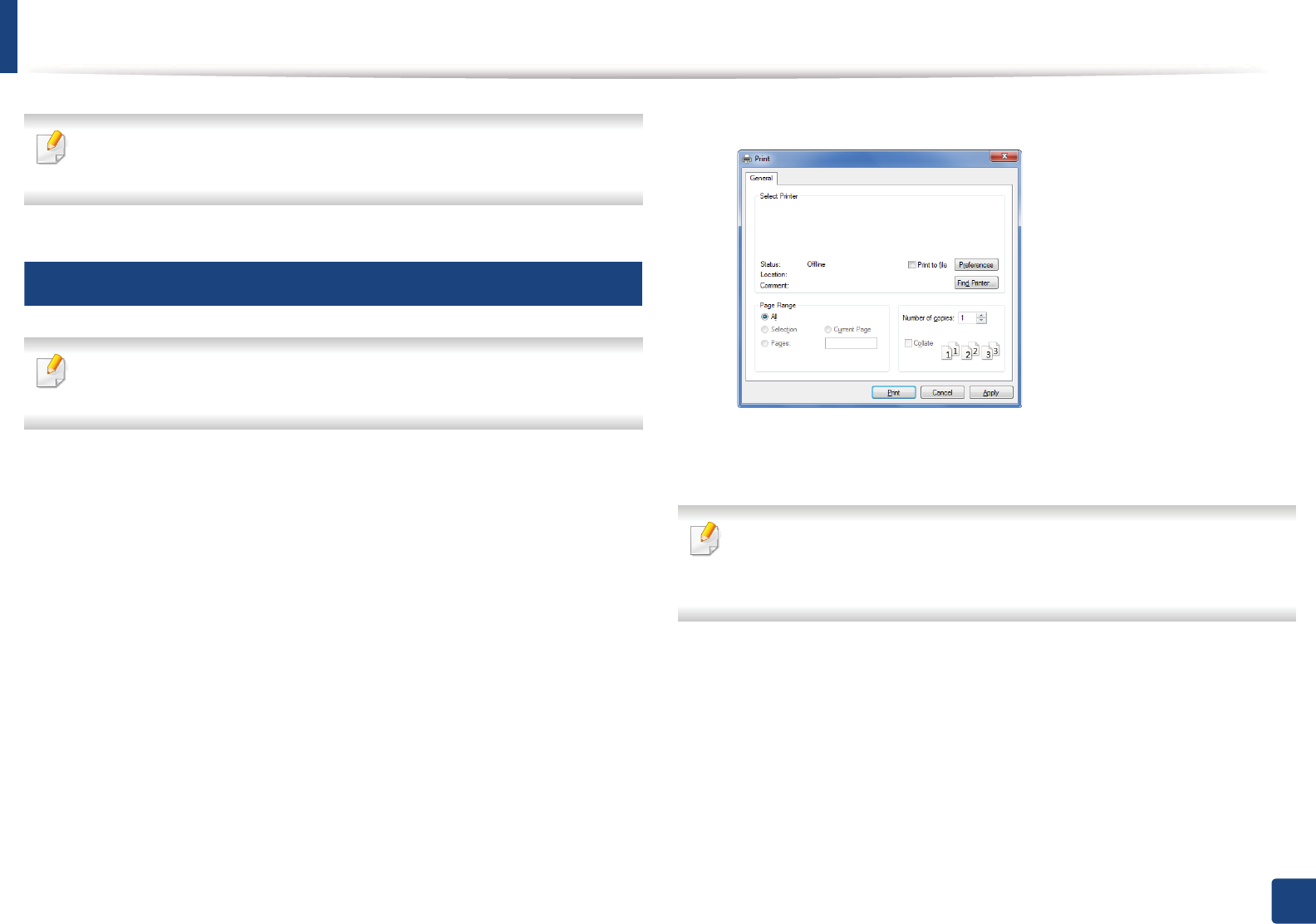
46
2. Menu Overview and Basic Setup
Basic printing
For special printing features, refer to the Advanced Guide (see "Using
advanced print features" on page 140).
10
Printing
If you are a Macintosh and Linux OS user, refer to the Advanced Guide.(see
"Macintosh printing" on page 147, "Linux printing" on page 148)
The following Printing Preferences window is for Notepad in Windows 7.
1Open the document you want to print.
2 Select Print from the File menu.
3 Select your machine from the Select Printer list.
4 The basic print settings including the number of copies and print range
are selected within the Print window.
To take advantage of the advanced printing features, click Properties or
Preferences from the Print window (see "Opening printing preferences" on
page 48).
5 To start the print job, click OK or Print in the Print window.

Basic printing
47
2. Menu Overview and Basic Setup
11
Canceling a print job
If the print job is waiting in the print queue or print spooler, cancel the job as
follows:
• You can access this window by simply double-clicking the machine icon
( ) in the Windows task bar.
• You can also cancel the current job by pressing (Stop/Clear) on the
control panel.

Basic printing
48
2. Menu Overview and Basic Setup
12
Opening printing preferences
• The Printing Preferences window that appears in this user’s guide may
differ depending on the machine in use.
• When you select an option in Printing Preferences, you may see a
warning mark or . An mark means you can select that certain
option but it is not recommended, and an mark means you cannot
select that option due to the machine’s setting or environment.
1Open the document you want to print.
2 Select Print from the file menu. The Print window appears.
3 Select your machine from the Select Printer.
4 Click Properties or Preferences.
You can check the machine’s current status pressing the Printer Status
button (see"Using Samsung Printer Status" on page 173).
Using a favorite setting
The Presets option, which is visible on each preferences tab except for the
Samsung tab, allows you to save the current preferences for future use.
To save a Presets item, follow these steps:
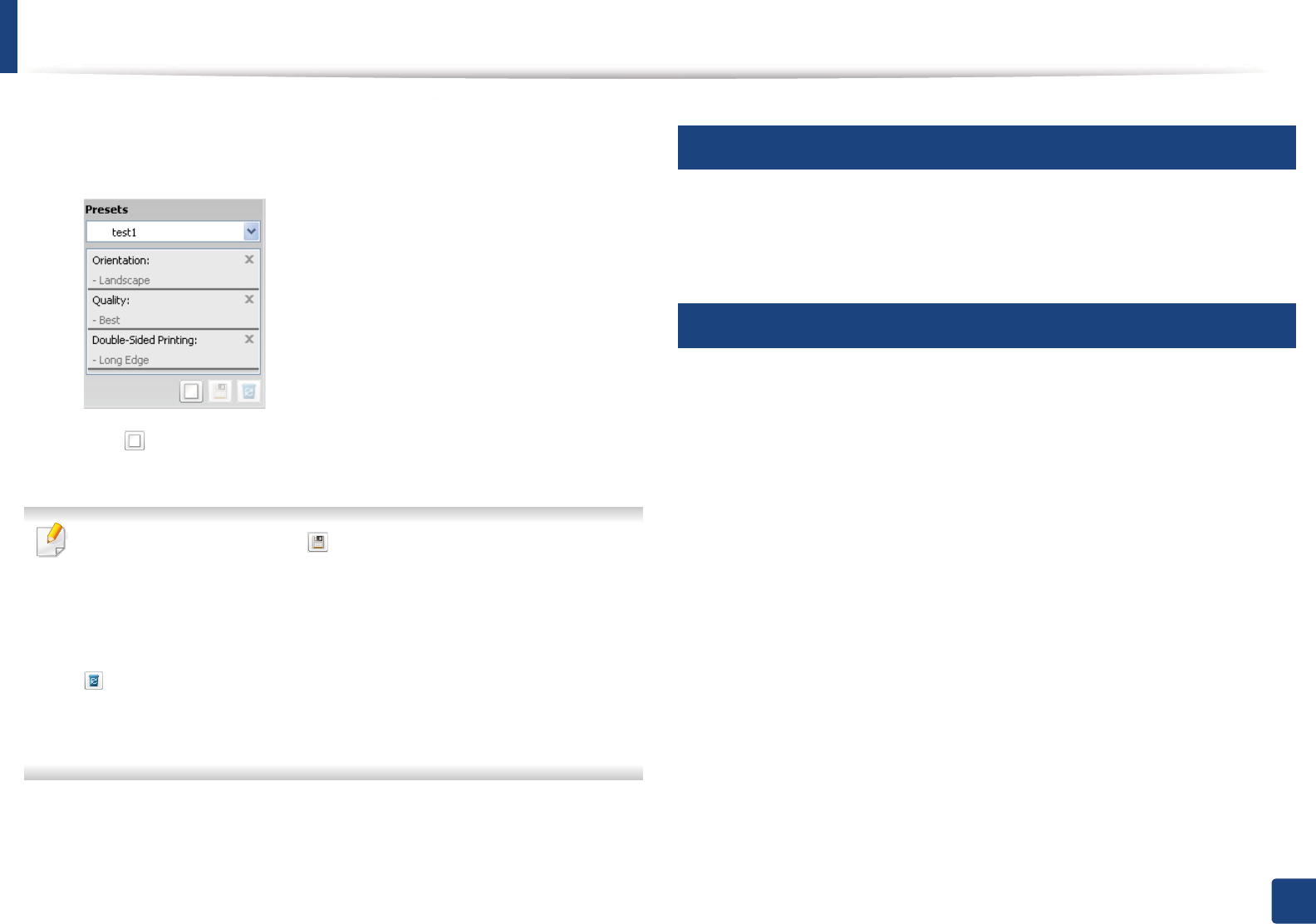
Basic printing
49
2. Menu Overview and Basic Setup
1Change the settings as needed on each tab.
2 Enter a name for the item in the Presets input box.
3 Click (Add). When you save Presets, all current driver settings are
saved.
Select more options and click (Update), settings will be added to the
Presets you made. To use a saved setting, select it from the Presets drop-
down list. The machine is now set to print according to the settings you
have selected.
To delete saved settings, select it from the Presets drop-down list and click
(Delete).
You can also restore the printer driver’s default settings by selecting
Default Preset from the Presets drop-down list.
13
Using help
Click the option you want to know on the Printing Preferences window and
press F1 on your keyboard.
14
Eco printing
The Eco function cuts toner consumption and paper usage. The Eco function
allows you to save print resources and lead you to eco-friendly printing.
To Eco printing,
G
click the below:
See "Easy Eco Driver" on page 169.
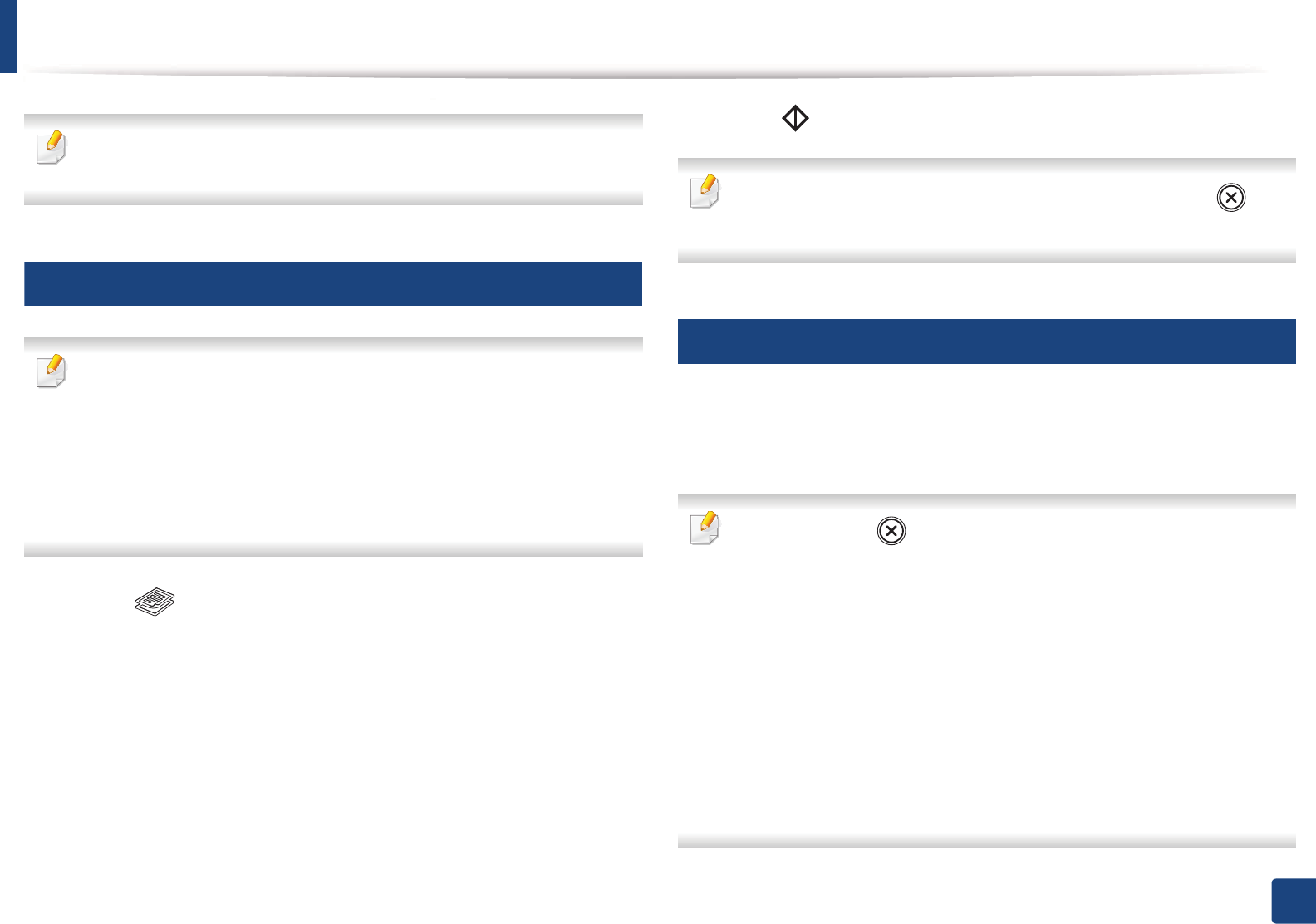
50
2. Menu Overview and Basic Setup
Basic copying
For special printing features, refer to the Advanced Guide (see"Copy menu"
on page 124).
15
Basic copy
• It may be necessary to press OK to navigate to lower-level menus for
some models.
• You can set the machine’s settings by using the Device Settings in
6DPVXQJ(DV\3ULQWHU0DQDJHUprogram or Machine section in
Printer Settings Utility program.
- For Windows and Macintosh users, see "Device Settings" on page 172.
- For Linux users, see "Using Smart Panel" on page 175.
1Select (copy) on the control panel.
2 Load originals face down into the document feeder (see "Loading
originals" on page 44).
3 If you want to customize the copy settings including Reduce/Enlarge,
Darkness, Contrast, Original Type, and more by using the control
panel buttons (see "Changing the settings for each copy" on page 50).
4 Enter the number of copies using the arrow or number keypad, if
necessary.
5 Press (Start).
If you need to cancel the copying job during the operation, press (Stop/
Clear) and the copying will stop.
16
Changing the settings for each copy
Your machine provides default settings for copying so that you can quickly and
easily make a copy. However, if you want to change the options for each copy,
use the copy function buttons on the control panel.
• If you press the (Stop/Clear) button twice while setting the copy
options, all of the options you have set for the current copy job will be
canceled and returned to their default status. Or, they will automatically
return to their default status after the machine completes the copy in
progressU
• You can customize the copy settings such as darkness, original type, and
more by using the Device Settings in the Samsung Easy Printer Manager
program or the Machine section of the Printer Settings Utility program.
- For Windows and Macintosh users, see "Device Settings" on page 172.
- For Linux users, see "Using Smart Panel" on page 175.
• It may be necessary to press OK to navigate to lower-level menus for
some models.
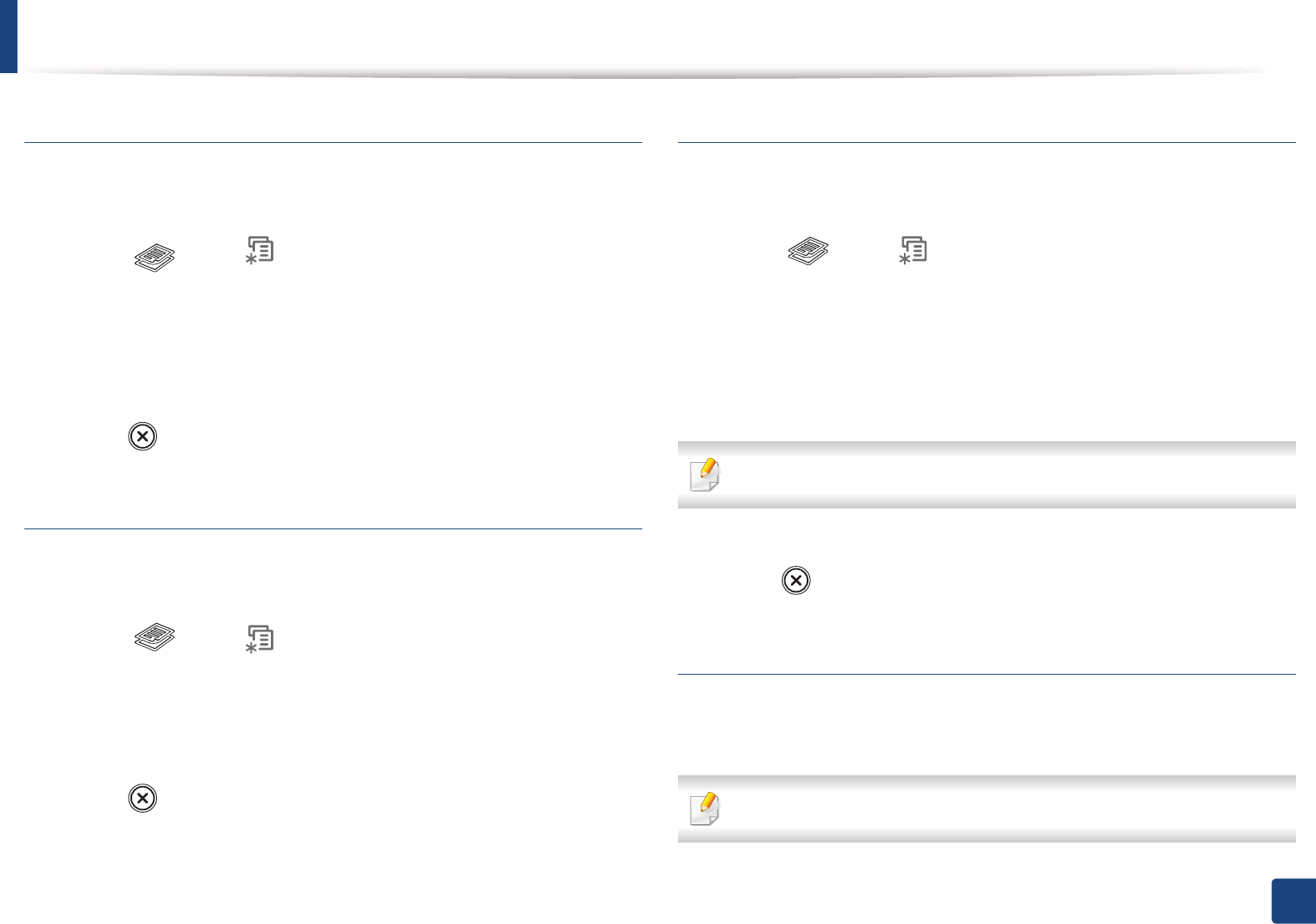
Basic copying
51
2. Menu Overview and Basic Setup
Darkness
If you have an original containing faint marking and dark images, you can adjust
the brightness to make a copy that is easier to read.
1Select (copy) > (Menu) > Copy Feature > Darkness on the
control panel.
2 Select the option you want and press OK.
For example, the Light+5 being the lightest, and the Dark+5 being the
darkest.
3 Press (Stop/Clear) to return to ready mode.
Contrast
The Contrast menu lets you increase or decrease the difference between the
bright and dark areas of an image.
1Select (copy) > (Menu) > Copy Feature > Contrast on the
control panel.
2 Select the option you want and press OK.
Select Dark to heighten the contrast and select Light to reduce it.
3 Press (Stop/Clear) to return to ready mode.
Original Type
The original setting is used to improve the copy quality by selecting the
document for the current copy job.
1Select (copy) > (Menu) > Copy Feature > Original Type on
the control panel.
2 Select the option you want and press OK.
•Text: Use for originals containing mostly text.
•Text/Photo: Use for originals with mixed text and photographs.
If texts in the printout is blurry, select Text to get the clear texts.
•Photo: Use when the originals are photographs.
3 Press (Stop/Clear) to return to ready mode.
Reduced or enlarged copy
You can reduce or enlarge the size of a copied image from 25% to 400% from the
document feeder.
You can use Reduce/Enlarge button directly on the control panel.
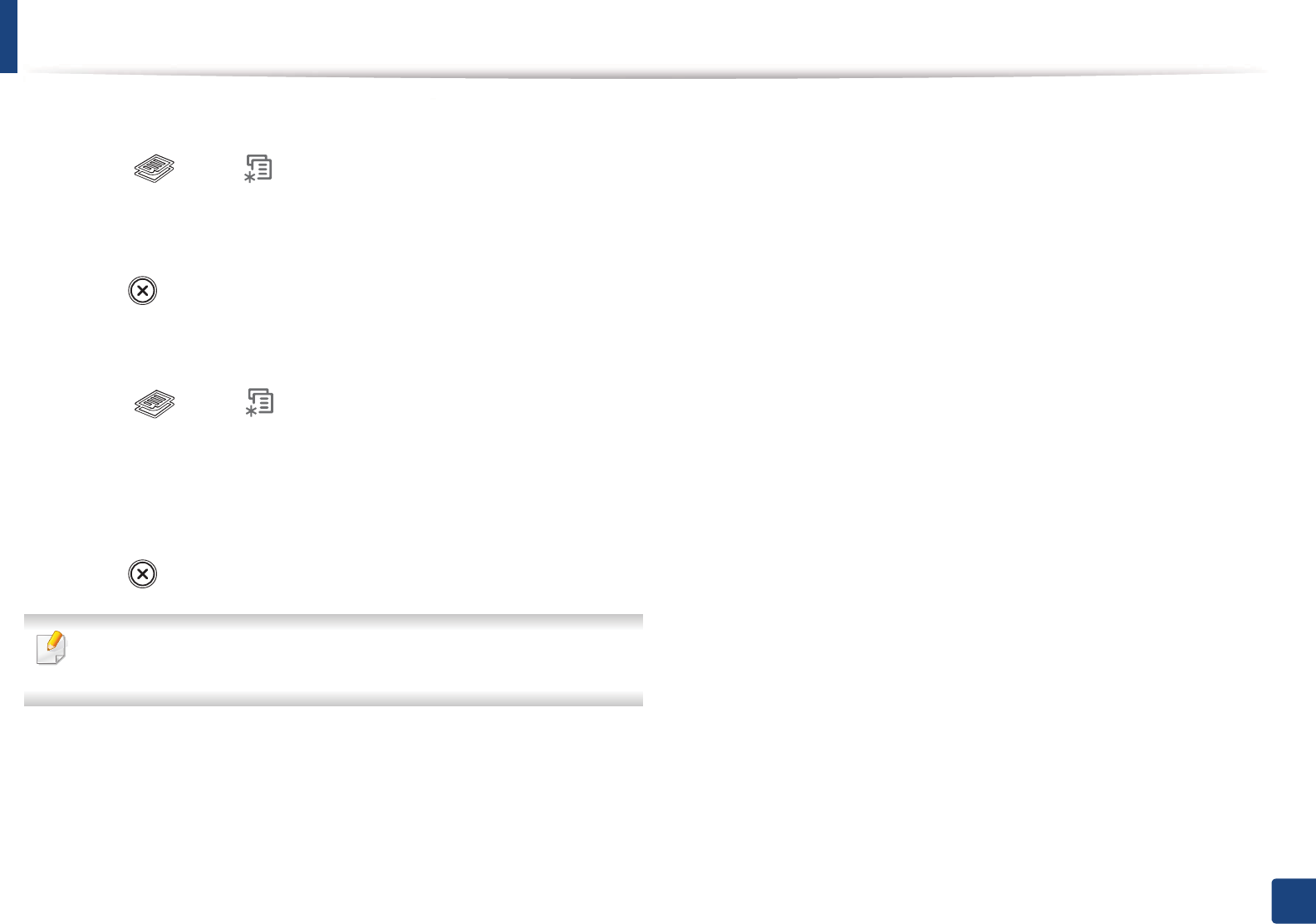
Basic copying
52
2. Menu Overview and Basic Setup
To select from the predefined copy sizes
1Select (copy) > (Menu) > Copy Feature > Reduce/Enlarge on
the control panel.
2 Select the option you want and press OK.
3 Press (Stop/Clear) to return to ready mode.
To scale the copy by directly entering the scale rate
1Select (copy) > (Menu) > Copy Feature > Reduce/Enlarge >
Custom on the control panel.
2 Enter the copy size you want using the numeric keypad.
3 Press OK to save the selection.
4 Press (Stop/Clear) to return to ready mode.
When you make a reduced copy, black lines may appear at the bottom of
your copy.
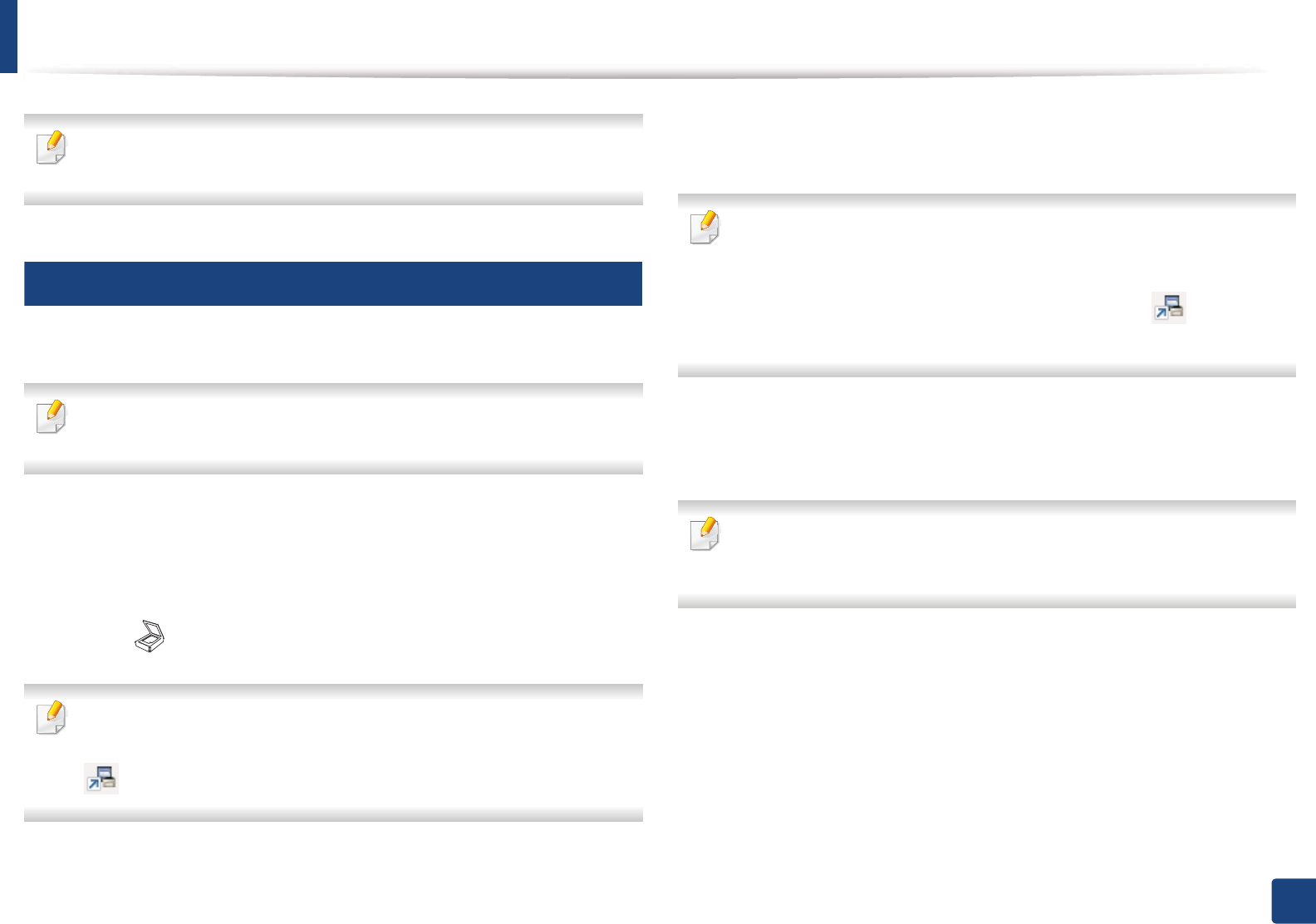
53
2. Menu Overview and Basic Setup
Basic scanning
For special scanning features, refer to the Advanced Guide (see"Scan
features" on page 151).
17
Basic Scanning
This is the normal and usual procedure for scanning originals.
It may be necessary to press OK to navigate to lower-level menus for some
models.
This is a basic scanning method for USB-connected machine.
1Load originals face down into the document feeder (see "Loading
originals" on page 44).
2 Select (scan) > Scan to PC on the control panel.
If you see Not Available message, check the port connectionSGor select
Enable Scan from Device Panel in 6DPVXQJ(DV\3ULQWHU0DQDJHU!
Switch to advanced mode!Scan to 2% Settings.
3 Select the Scan Destination you want and press OK.
Default setting is My Documents.
• You can create and save the frequently used settings as a profile list. Also
you can add and delete the profile and save each profile to a different
path.
•To change the 6DPVXQJ(DV\3ULQWHU0DQDJHU! Switch to
advanced mode!Scan to 2% Settings.
4 Select the option you want and press OK.
5 Scanning begins.
• Scanned image is saved in computer’s C:\Users\users name\My
Documents. The saved folder may differ, depending on your operating
system or the application you are using.
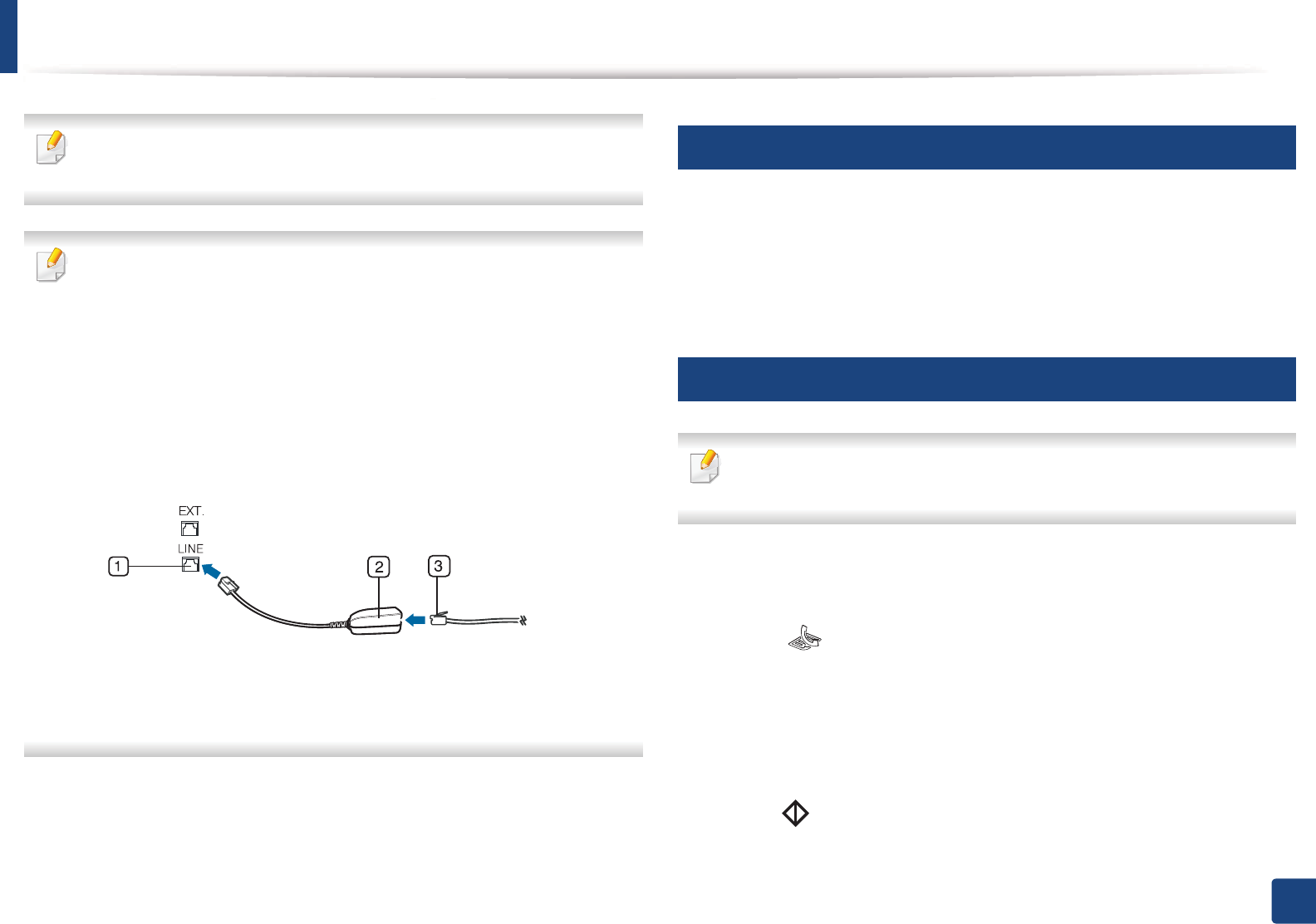
54
2. Menu Overview and Basic Setup
Basic faxing
For special faxing features, refer to the Advanced Guide (see "Fax features"
on page 157).
• You cannot use this machine as a fax via the internet phone. For more
information ask your internet service provider.
• We recommend using traditional analog phone services (PSTN: Public
Switched Telephone Network) when connecting telephone lines to use
a fax machine. If you use other Internet services (DSL, ISDN, VolP), you can
improve the connection quality by using the Micro-filter. The Micro-filter
eliminates unnecessary noise signals and improves connection quality or
Internet quality. Since the DSL Micro-filter is not provided with the
machine, contact your Internet service provider for use on DSL Micro-
filter.
1Line port
2Micro filter
3DSL modem / Telephone line
(see "Rear view" on page 22).
18
Preparing to fax
Before you send or receive a fax, you need to connect the supplied line cord to
your telephone wall jack. Refer to the Quick Installation Guide how to make a
connection. The method of making a telephone connection is different from
one country to another.
19
Sending a fax
It may be necessary to press OK to navigate to lower-level menus for some
models.
1Load originals face down into the document feeder (see "Loading
originals" on page 44).
2 Select (fax) on the control panel.
3 Adjust the resolution and the darkness to suit your fax needs (see
"Adjusting the document settings" on page 56).
4 Enter the destination fax number.
5 Press (Start) on the control panel. The machine starts to scan and
send the fax to the destinations.
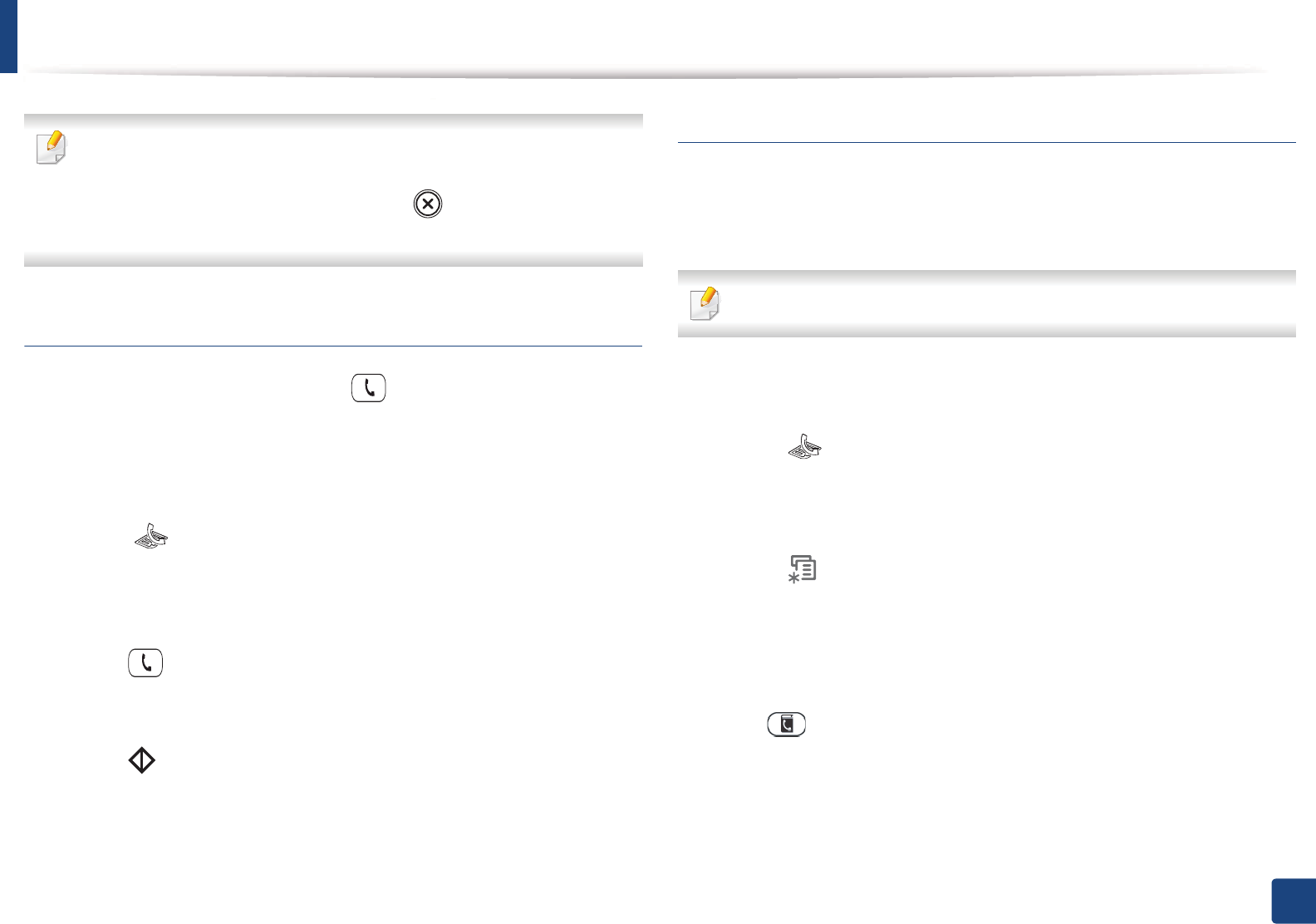
Basic faxing
55
2. Menu Overview and Basic Setup
• If you want to send a fax directly from your computer, use Samsung
Network PC Fax (see "Sending a fax in the computer" on page 158).
• When you want to cancel a fax job, press (Stop/Clear) before the
machine starts transmission.
Sending a fax manually
Perform the following to send a fax using (On Hook Dial) on the control
panel or using the handset (see "Features by models" on page 7).
1Load originals face down into the document feeder(see "Loading
originals" on page 44).
2 Select (fax) on the control panel.
3 Adjust the resolution and the darkness to suit your fax needs (see
"Adjusting the document settings" on page 56).
4 Press (On Hook Dial) on the control panel or lift the handset.
5 Enter a fax number using the number keypad on the control panel.
6 Press (Start) on the control panel when you hear a high-pitched fax
signal from the remote fax machine.
Sending a fax to multiple destinations
You can use the multiple send feature, which allows you to send a fax to multiple
locations. Originals are automatically stored in memory and sent to a remote
station. After transmission, the originals are automatically erased from memory.
You cannot send color faxes with this feature.
1Load originals face down into the document feeder (see "Loading
originals" on page 44).
2 Select (fax) on the control panel.
3 Adjust the resolution and the darkness to suit your fax needs (see
"Adjusting the document settings" on page 56).
4 Select (Menu) > Fax Feature > Multi Send on the control panel.
You also can use Multi Send button directly on the control panel.
5 Enter the number of the first receiving fax machine and press OK.
You can press speed dial numbers or select a group dial number using
the (Address Book) button (see "Using speed dial numbers" on
page 135Gor see "One-touch dialing" on page 136).
6 Enter the second fax number and press OK.
The display asks you to enter another fax number to send the document.
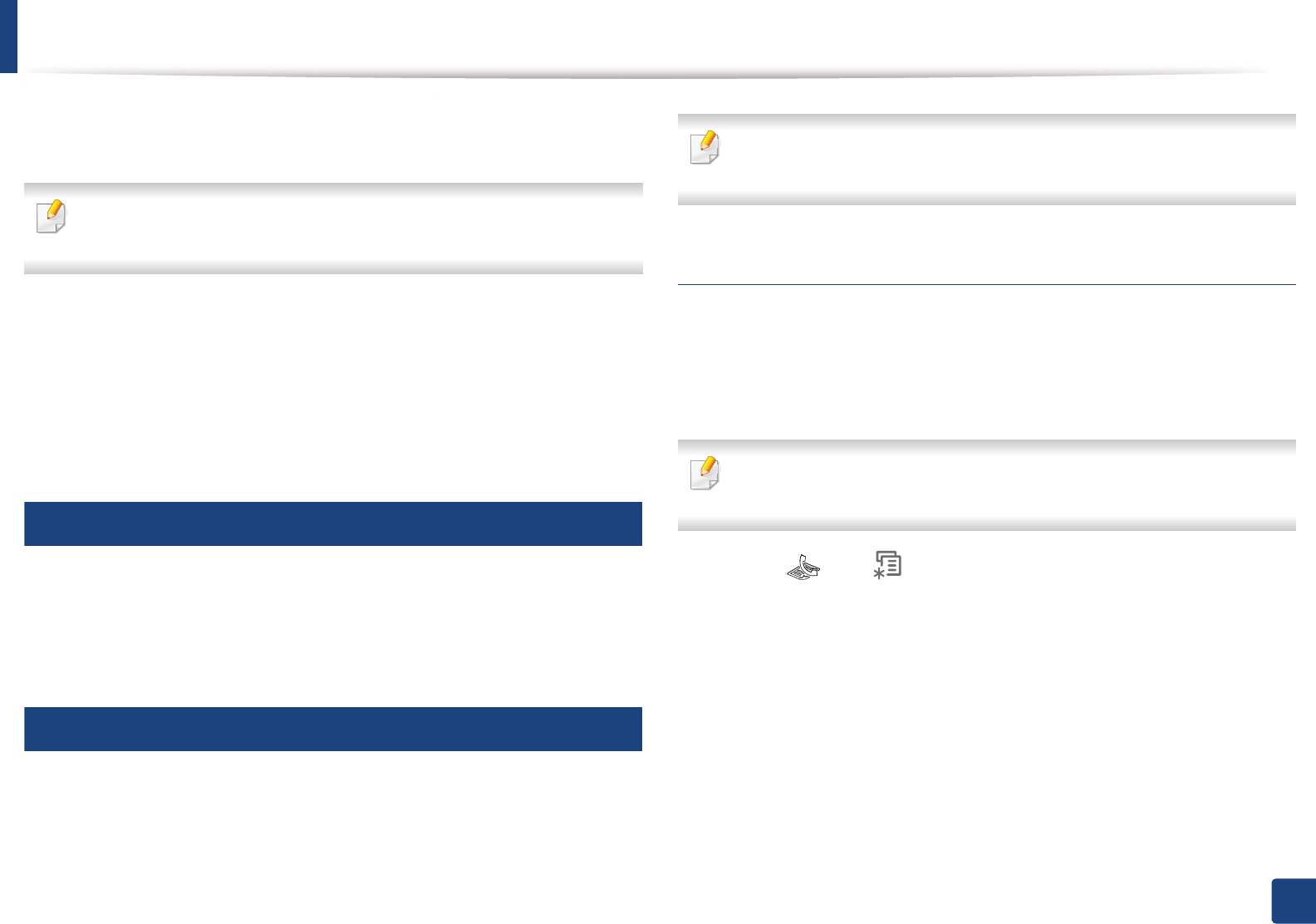
Basic faxing
56
2. Menu Overview and Basic Setup
7 To enter more fax numbers, press OK when Yes appears and repeat
steps 5 and 6. You can add up to 10 destinations.
Once you have entered a group dial number, you cannot enter another
group dial number.
8 When you have finished entering fax numbers, select No at the Another
No.? prompt and press OK.
The machine begins sending the fax to the numbers you entered in the
order in which you entered them.
send report is printed after sending faxes.
20
Receiving a fax
Your machine is preset Fax mode at the factory. When you receive a fax, the
machine answers the call on a specified number of rings and automatically
receives the fax.
21
Adjusting the document settings
Before starting a fax, change the following settings according to your original’s
status to get the best quality.
It may be necessary to press OK to navigate to lower-level menus for some
models.
Resolution
The default document settings produce good results when using typical text-
based originals. However, if you send originals that are of poor quality, or
contain photographs, you can adjust the resolution to produce a higher quality
fax.
The resolution setting is applied to the current fax job. To change the
default setting (see "Fax menu" on page 121).
1Select (fax) > (Menu) > Fax Feature > Resolution on the control
panel.
2 Select the option you want and press OK.
•Standard: Originals with normal sized characters.
•Fine: Originals containing small characters or thin lines or originals
printed using a dot-matrix printer.
•Super Fine: Originals containing extremely fine detail. Super Fine
mode is enabled only if the machine with which you are
communicating also supports the Super Fine resolution.
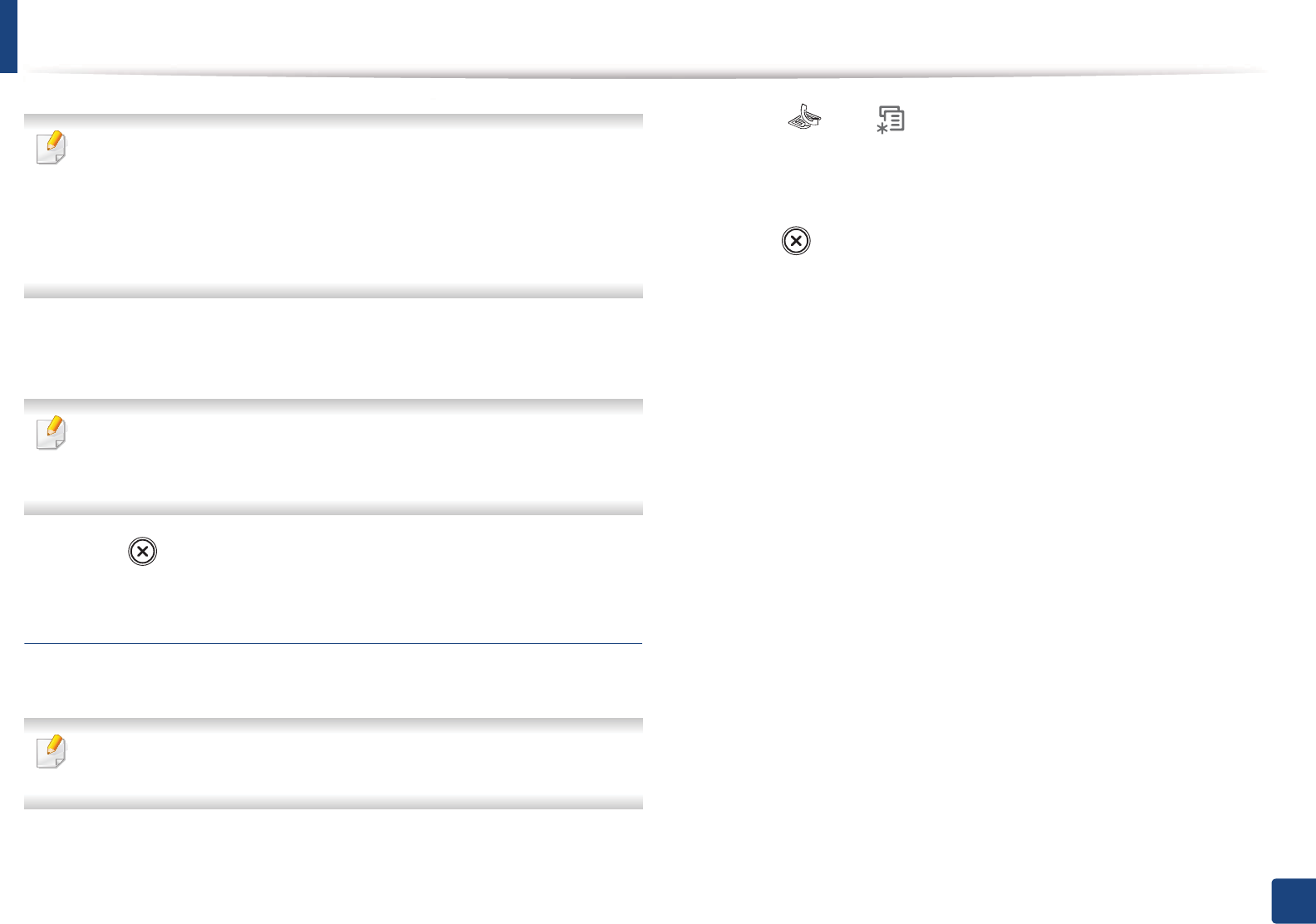
Basic faxing
57
2. Menu Overview and Basic Setup
• For memory transmission, Super Fine mode is not available. The
resolution setting is automatically changed to Fine.
• When your machine is set to Super Fine resolution and the fax machine
with which you are communicating does not support Super Fine
resolution, the machine transmits using the highest resolution mode
supported by the other fax machine.
•Photo Fax: Originals containing shades of gray or photographs.
•Color Fax: Original with colors.
• Memory transmission is not available in this mode.
• You can only send a color fax if the machine you are communicating with
supports color fax reception and you send the fax manually.
3 Press (Stop/Clear) to return to ready mode.
Darkness
You can select the degree of darkness of the original document.
The darkness setting is applied to the current fax job. To change the default
setting (see "Fax menu" on page 121).
1Select (fax) > (Menu) > Fax Feature > Darkness on the control
panel.
2 Select a darkness level you want.
3 Press (Stop/Clear) to return to ready mode.
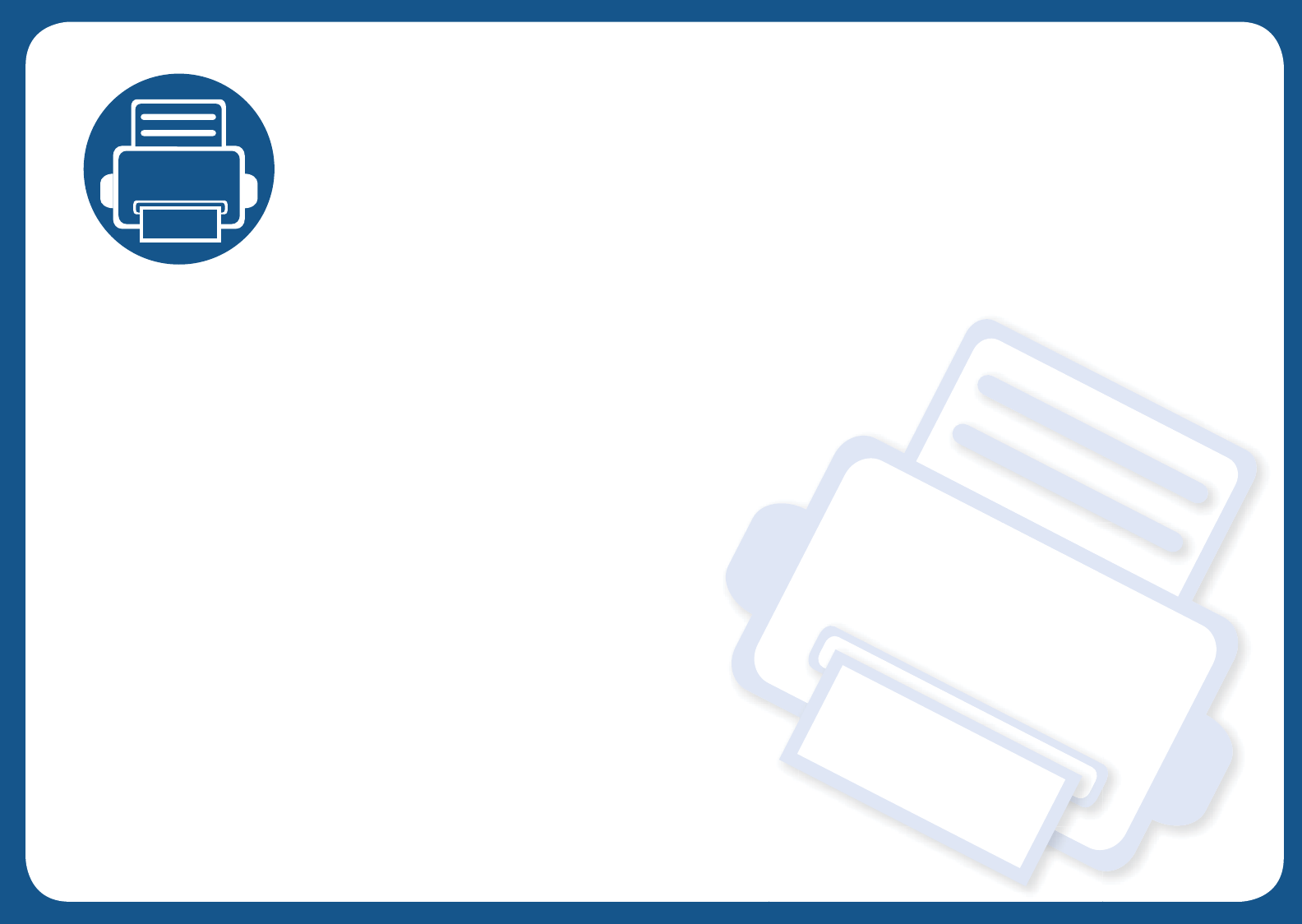
3. Maintenance
This chapter provides information about purchasing supplies, accessories and maintenance parts available for your
machine.
• Ordering supplies and accessories 59
• Available supplies 60
• Available maintenance parts 61
• Storing the toner cartridge 62
• Redistributing toner 64
• Replacing the toner cartridge 66
• Monitoring the supplies life 68
• Setting the toner low alert 69
• Cleaning the machine 70
• Tips for moving & storing your machine 77
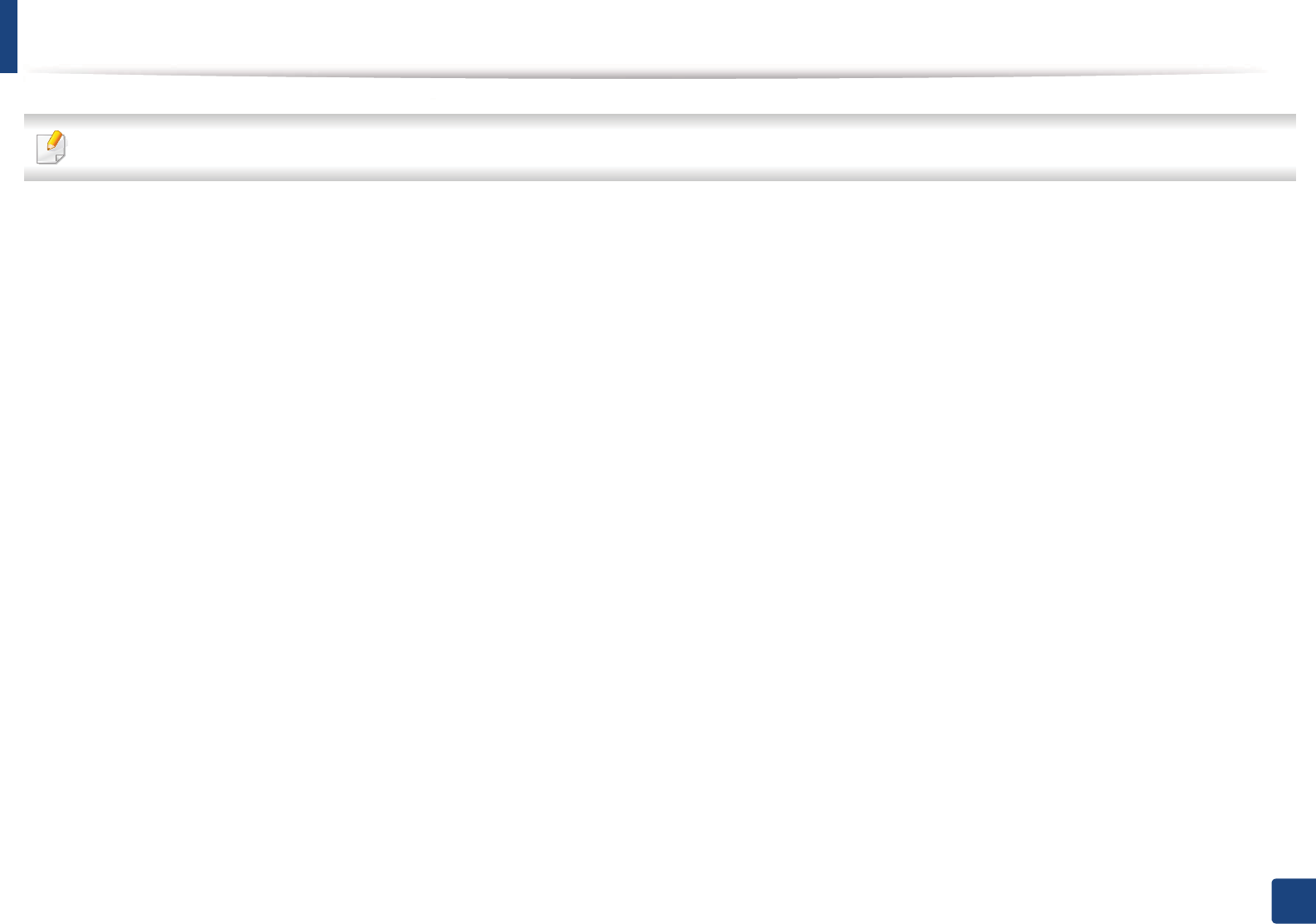
59
3. Maintenance
Ordering supplies and accessories
Available accessories may differ from country to country. Contact your sales representatives to obtain the list of available supplies, and maintenance parts.
To order Samsung-authorized supplies, accessories, and maintenance parts, contact your local Samsung dealer or the retailer where you purchased your machine.
You can also visit www.samsung.com/supplies, and then select your country/region to obtain the contact information for service.
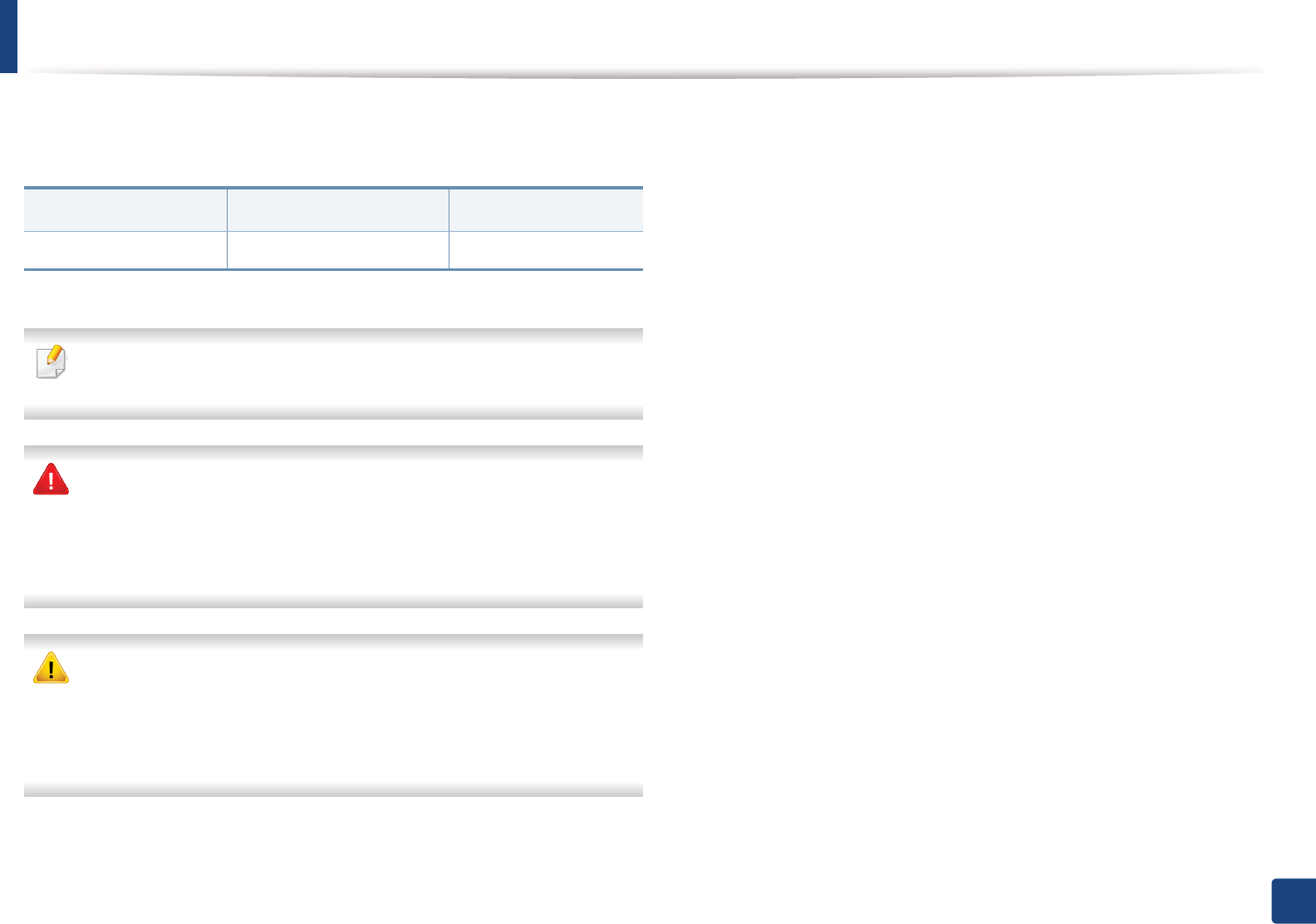
60
3. Maintenance
Available supplies
When supplies reach the end of their life spans, you can order the followings of
supplies for your machine:
Depending on the options, percentage of image area and job mode used,
the toner cartridge’s lifespan may differ.
When purchasing new toner cartridges or other supplies, these must be
purchased in the same country as the machine you are using. Otherwise,
new toner cartridges or other supplies will be incompatible with your
machine due to different configurations of toner cartridges and other
supplies according to the specific country conditions.
Samsung does not recommend using non-genuine Samsung toner
cartridge such as refilled or remanufactured toner. Samsung cannot
guarantee non-genuine Samsung toner cartridge's quality. Service or repair
required as a result of using non-genuine Samsung toner cartridges will not
be covered under the machine’s warranty.
Type Average yielda
a. Declared yield value in accordance with ISO/IEC 19752.
Part name
Toner cartridge Approx. 1,500 pages MLT-D101S

61
3. Maintenance
Available maintenance parts
To purchase maintenance parts, contact the source where you bought the machine. Replacing maintenance parts can be performed only by an authorized service
provider, dealer, or the retailer where you bought the machine. The warranty does not cover the replacement of any maintenance parts once it has reached its
“Average yield”.
Maintenance parts are replaced at specific intervals to avoid print quality and paper feed problems resulting from worn parts, see table below. The purpose of which
is to maintain your machine in top working condition. The maintenance parts below should be replaced when the life span of each item has been met.
Parts Average yielda
a. It will be affected by the operating system used, computing performance, application software, connecting method, media, media size and job complexity.
Transfer Roller Approx. 30,000 pages
Fuser Approx. 30,000 pages
Feed Roller Approx. 30,000 pages
Pick-up Roller Approx. 30,000 pages
ADF Roller Approx. 20,000 pages
ADF Rubber Pad Approx. 20,000 pages
White Roller Approx. 30,000 pages

62
3. Maintenance
Storing the toner cartridge
Toner cartridges contain components that are sensitive to light, temperature
and humidity. Samsung suggests users follow these recommendations to
ensure optimal performance, highest quality, and longest life from your new
Samsung toner cartridge.
Store this cartridge in the same environment in which the printer will be used.
This should be in controlled temperature and humidity conditions. The toner
cartridge should remain in its original and unopened package until installation
if original packaging is not available, cover the top opening of the cartridge with
paper and store in a dark cabinet.
Opening the cartridge package prior to use dramatically shortens its useful shelf
and operating life. Do not store on the floor. If the toner cartridge is removed
from the printer, follow the instructions below to store the toner cartridge
properly.
• Store the cartridge inside the protective bag from the original package.
• Store lying flat (not standing on end) with the same side facing up as if it
were installed in the machine.
• Do not store consumables in any of the following conditions:
- Temperature greater than 40°C (104°F).
- Humidity range less than 20% or greater than 80%.
- An environment with extreme changes in humidity or temperature.
- Direct sunlight or room light.
- Dusty places.
- A car for a long period of time.
- An environment where corrosive gases are present.
- An environment with salty air.
1
Handling instructions
• Do not touch the surface of the photoconductive drum in the cartridge.
• Do not expose the cartridge to unnecessary vibrations or shock.
• Never manually rotate the drum, especially in the reverse direction; this can
cause internal damage and toner spillage.
2
Toner cartridge usage
Samsung Electronics does not recommend or approve the use of non-Samsung
brand toner cartridges in your printer including generic, store brand, refilled, or
remanufactured toner cartridges.
Samsung’s printer warranty does not cover damage to the machine caused
by the use of a refilled, remanufactured, or non-Samsung brand toner
cartridges.

Storing the toner cartridge
63
3. Maintenance
3
Estimated cartridge life
Estimated cartridge life (the life of the toner cartridge yield) depends on the
amount of toner that print jobs require. The actual print yield may vary
depending on the print density of the pages you print on, operating
environment, percentage of image area, printing interval, media type and/or
media size. For example, if you print a lot of graphics, the consumption of the
toner is higher and you may need to change the cartridge more often.
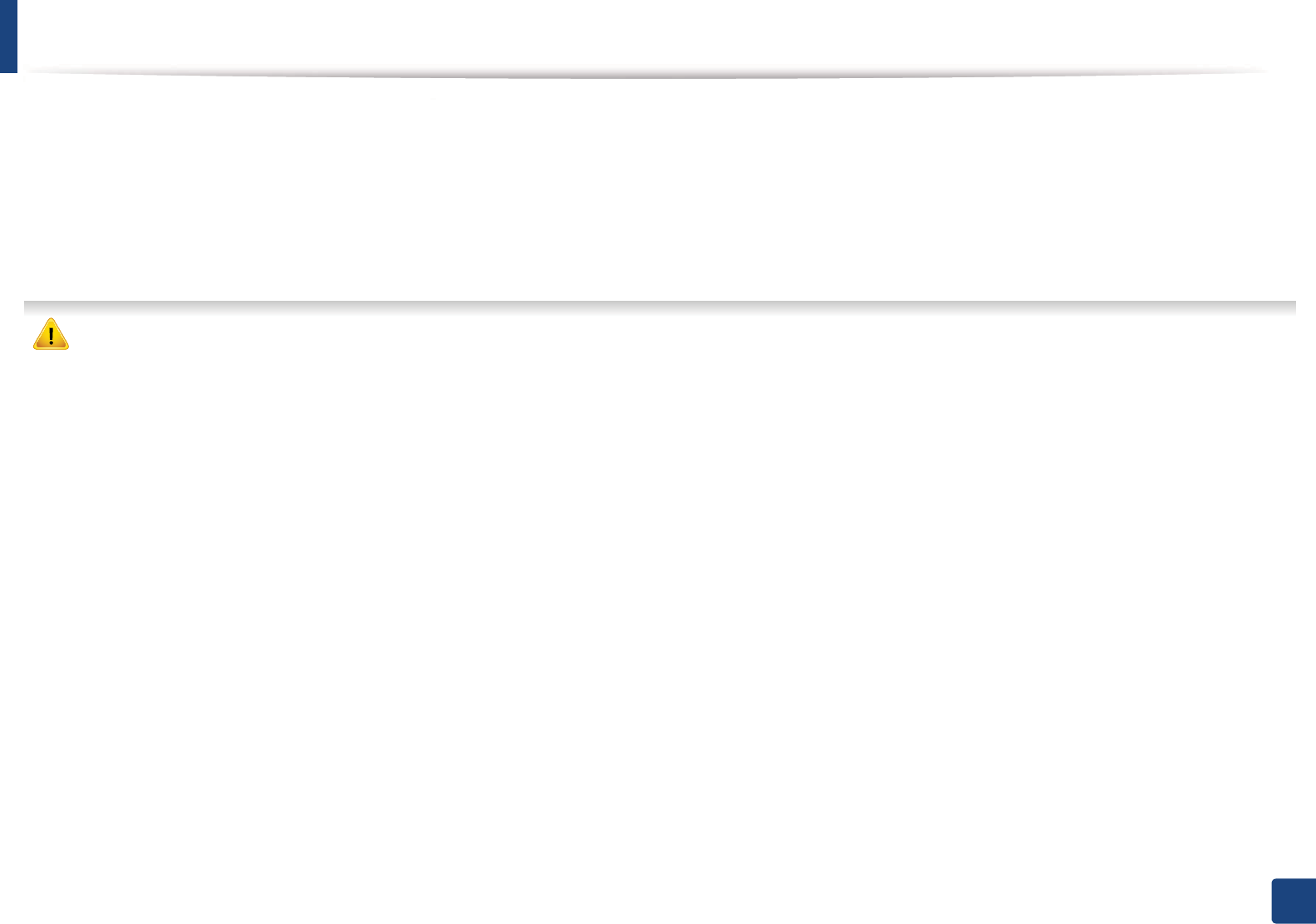
64
3. Maintenance
Redistributing toner
When the toner cartridge is near the end of its life:
• White streaks or light printing occurs and/or density variation side to side.
• The Status LED blinks red.
If this happens, you can temporarily improve print quality by redistributing the remaining toner in the cartridge. In some cases, white streaks or light printing will still
occur even after you have redistributed the toner.
• Before opening the top cover, close the output support first.
• To prevent damage to the toner cartridge, do not expose it to light for more than a few minutes. Cover it with a piece of paper, if necessary.
• Do not touch the green side of the toner cartridge. Use the handle on the cartridge to avoid touching this area.
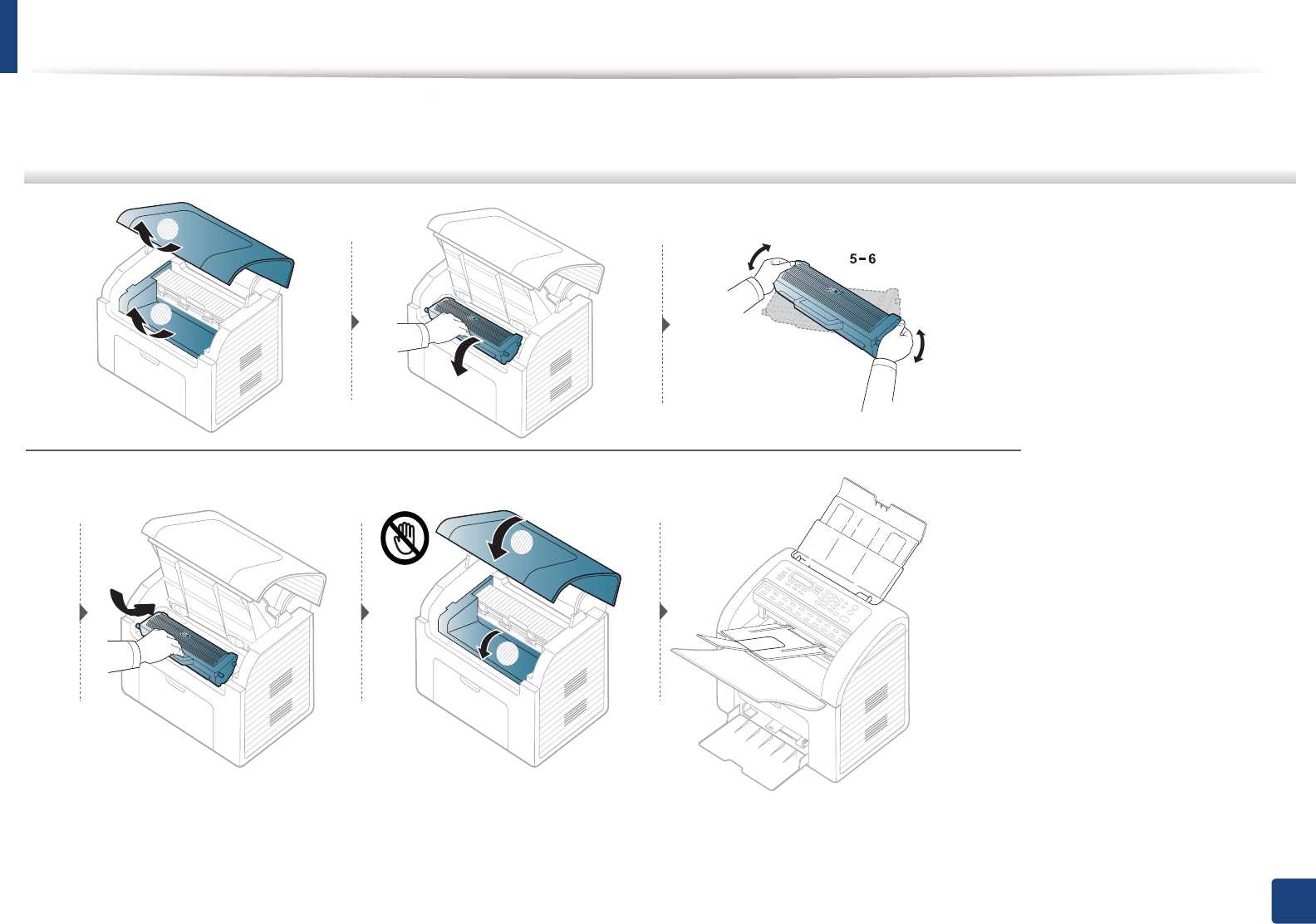
Redistributing toner
65
3. Maintenance
• Do not use sharp objects such as a knife or scissors to open the toner cartridge package. They might scratch the drum of the cartridge.
• If toner gets on your clothing, wipe it off with a dry cloth and wash clothing in cold water. Hot water sets toner into fabric.
2
1
1
2
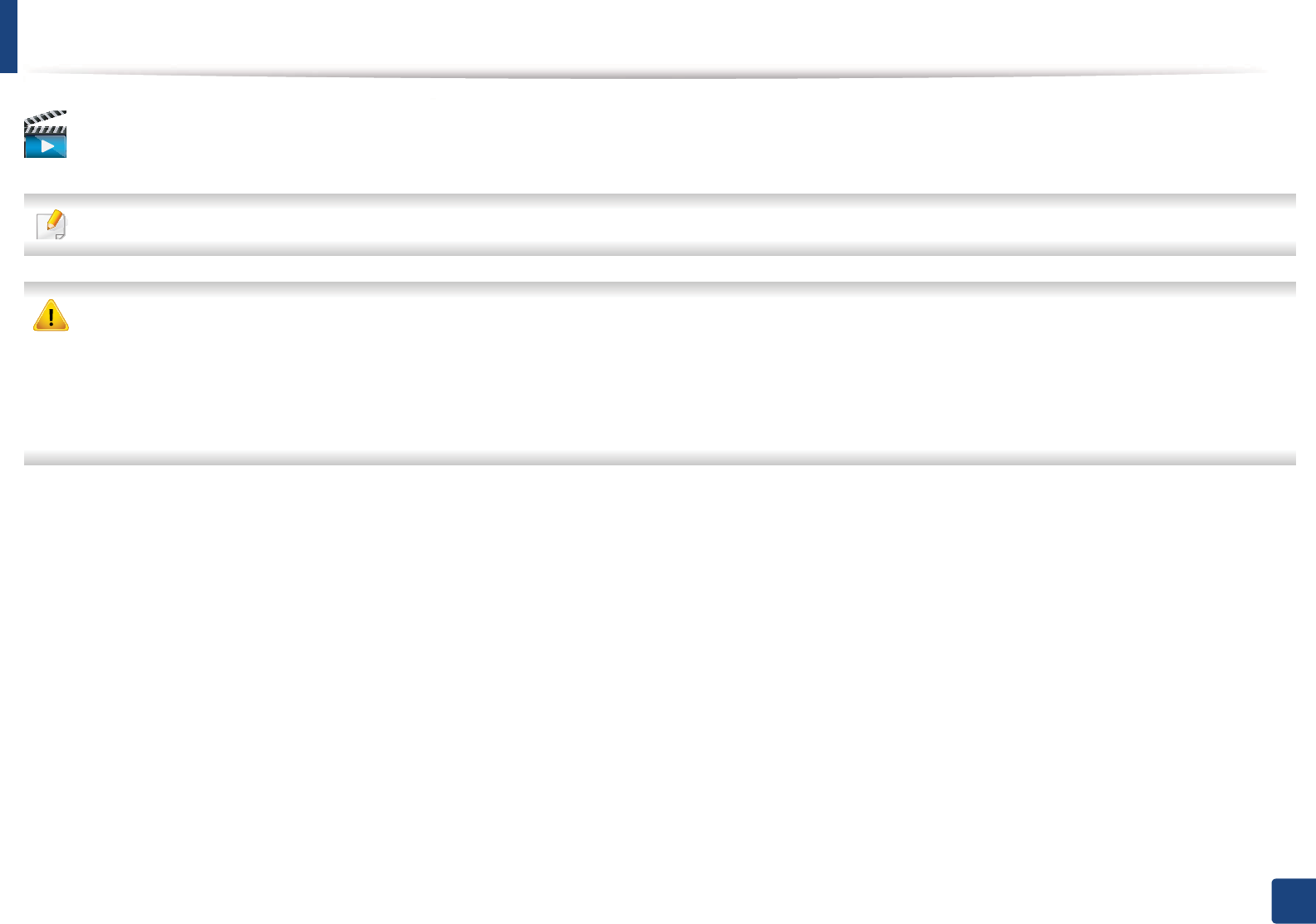
66
3. Maintenance
Replacing the toner cartridge
Click this link to open an animation about replacing a toner cartridge.
• Shake the toner cartridge thoroughly, it will increase the initial print quality.
• Before opening the top cover, close the output support first.
• To prevent damage to the toner cartridge, do not expose it to light for more than a few minutes. Cover it with a piece of paper, if necessary.
• Do not touch the green side of the toner cartridge. Use the handle on the cartridge to avoid touching this area.
• Do not use sharp objects such as a knife or scissors to open the toner cartridge package. They might scratch the drum of the cartridge.
• If toner gets on your clothing, wipe it off with a dry cloth and wash clothing in cold water. Hot water sets toner into fabric.
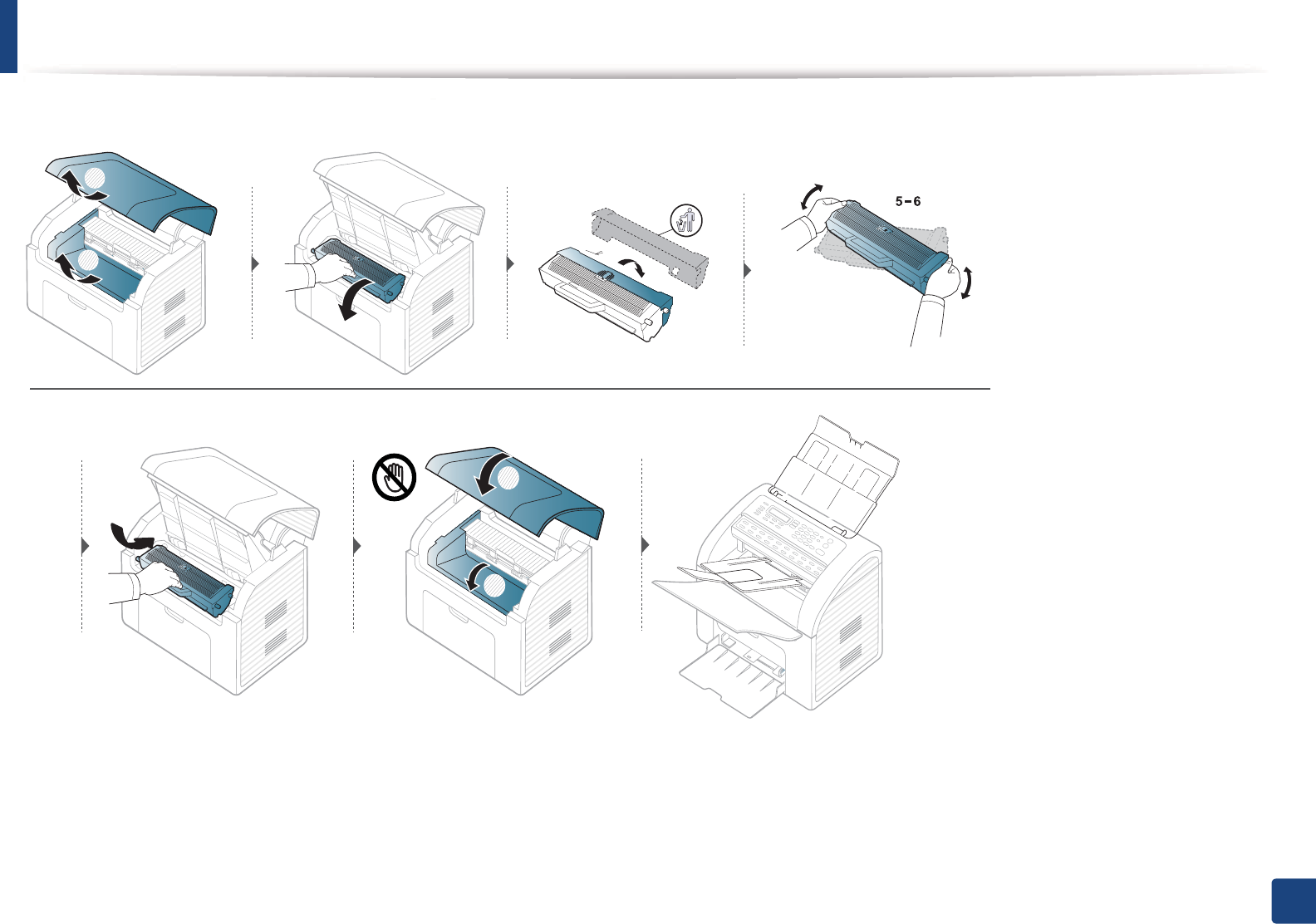
Replacing the toner cartridge
67
3. Maintenance
When a toner cartridge has reached the end of life, the machine will stop printing.
2
1
1
2
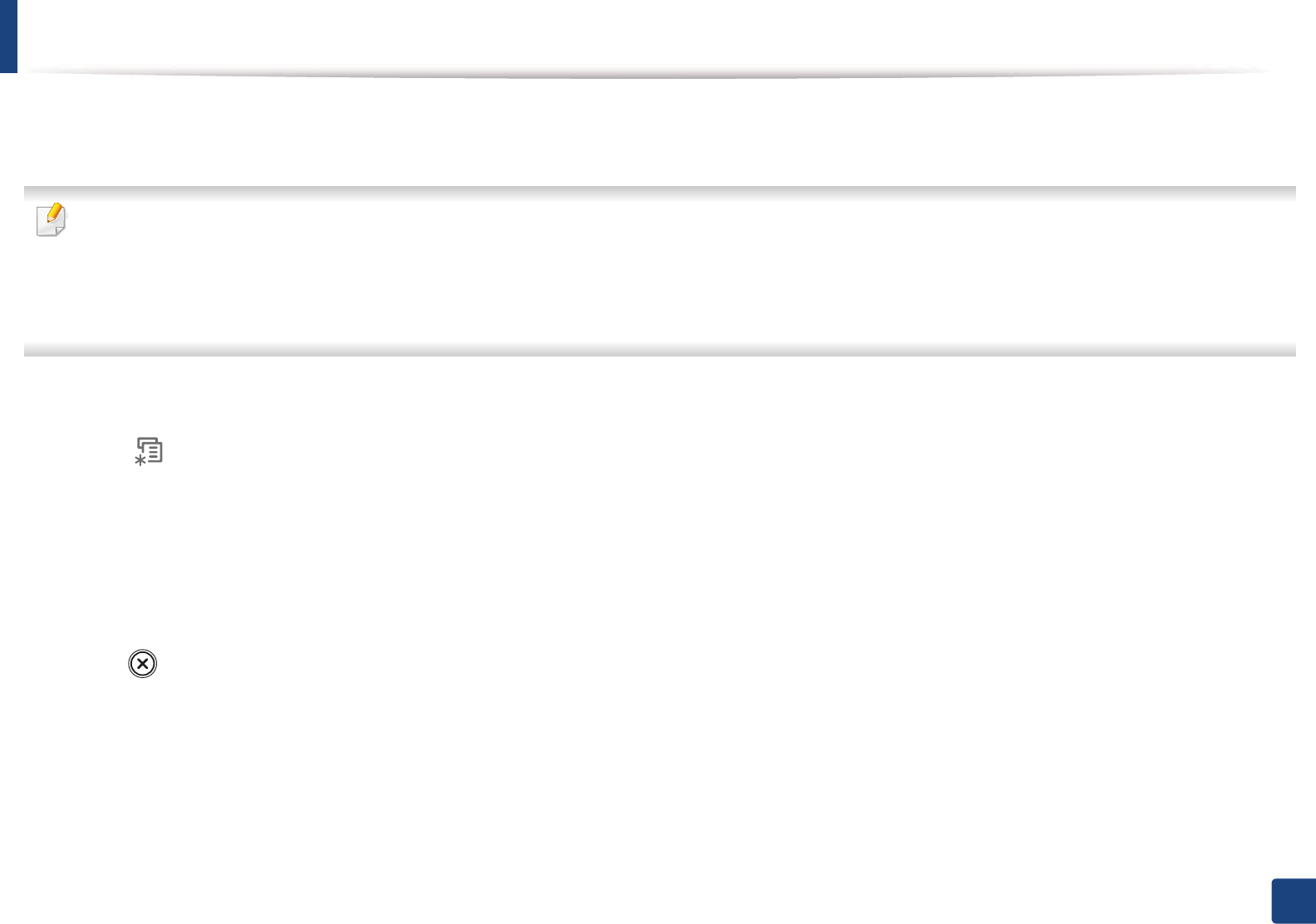
68
3. Maintenance
Monitoring the supplies life
If you experience frequent paper jams or printing problems, check the number of pages the machine has printed or scanned. Replace the corresponding parts, if
necessary.
• It may be necessary to press OK to navigate to lower-level menus for some models.
• You can customize the copy settings such as darkness, original type, and more by using the Device Settings in the Samsung Easy Printer Manager program or
the Machine section of the Printer Settings Utility program.
- For Windows and Macintosh users, see "Device Settings" on page 172.
- For Linux users, see "Using Smart Panel" on page 175.
1Select (Menu) > System Setup > Maintenance > Supplies Life on the control panel.
2 Select the option you want and press OK.
•Supplies Info.: Prints the supply information page.
•Total: Displays the total number of pages printed.
•Scan: Displays the number of pages printed by using the document feeder.
3 Press (Stop/Clear) to return to ready mode.
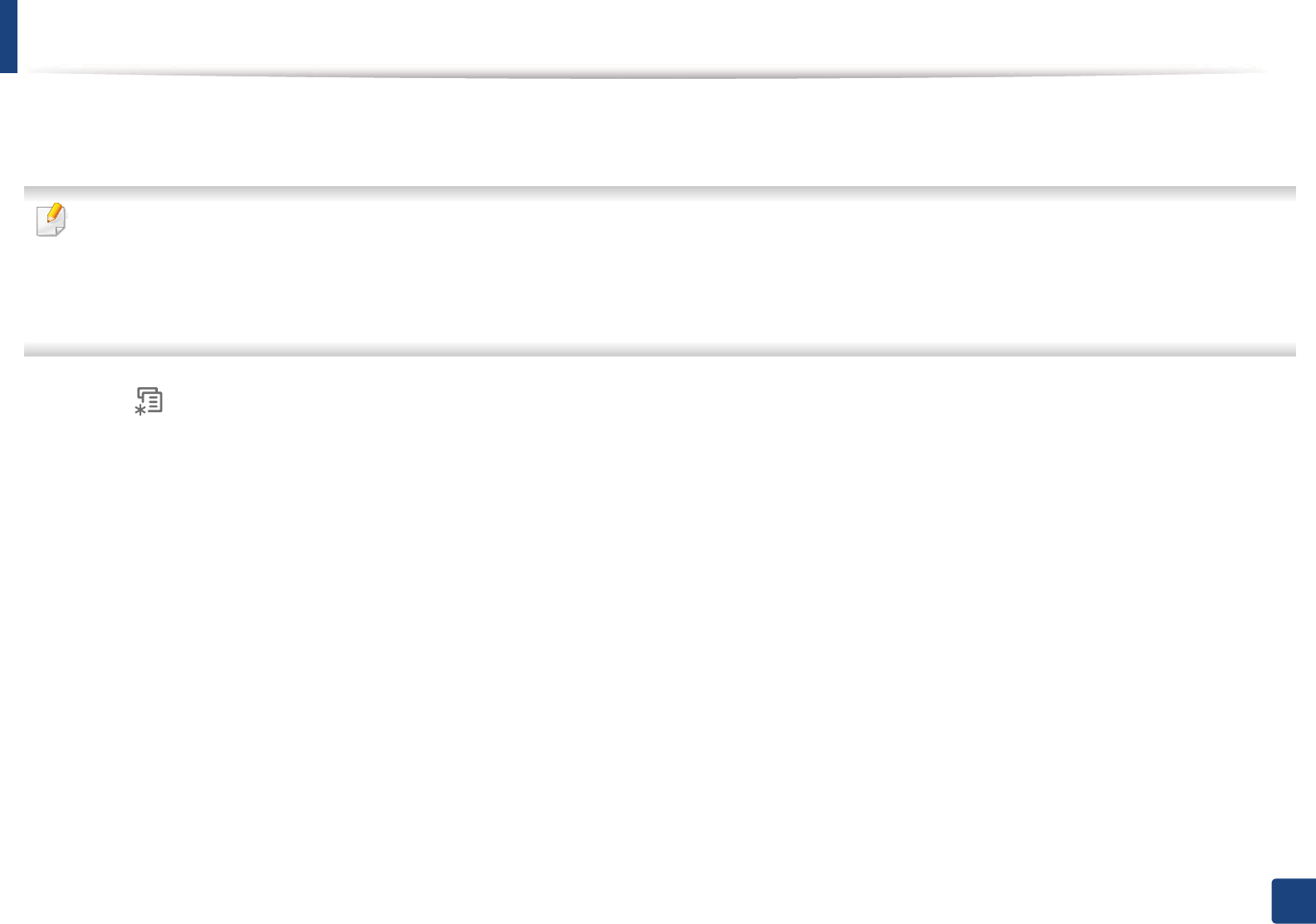
69
3. Maintenance
Setting the toner low alert
If the amount of toner in the cartridge is low, a message or LED informing the user to change the toner cartridge appears. You can set the option for whether or not
this message or LED appears.
• It may be necessary to press OK to navigate to lower-level menus for some models.
• You can customize the copy settings such as darkness, original type, and more by using the Device Settings in the Samsung Easy Printer Manager program or
the Machine section of the Printer Settings Utility program.
- For Windows and Macintosh users, see "Device Settings" on page 172.
- For Linux users, see "Using Smart Panel" on page 175.
1Select (Menu) > System Setup > Maintenance > TonerLow Alert on the control panel.
2 Select the option you want.
3 Press OK to save the selection.

70
3. Maintenance
Cleaning the machine
If printing quality problems occur or if you use your machine in a dusty environment, you need to clean your machine regularly to keep it in the best printing
condition and use your machine longer.
• Cleaning the cabinet of the machine with cleaning materials containing large amounts of alcohol, solvents, or other strong substances can discolor or distort the
cabinet.
• If your machine or the surrounding area is contaminated with toner, we recommend you use a cloth or tissue dampened with water to clean it. If you use a vacuum
cleaner, toner blows in the air and might be harmful to you.
4
Cleaning the outside
Clean the machine cabinet with a soft, lint-free cloth. Dampen the cloth slightly with water, but be careful not to let any water drip onto or into the machine.
5
Cleaning the inside
During the printing process, paper, toner, and dust particles can accumulate inside the machine. This buildup can cause print quality problems, such as toner specks
or smearing. Cleaning the inside of the machine clears and reduces these problems.
• To prevent damage to the toner cartridge, do not expose it to light for more than a few minutes. Cover it with a piece of paper, if necessary.
• Do not touch the green surface underside of the toner cartridge. Use the handle on the cartridge to avoid touching this area.
• Use a dry lint free cloth when cleaning the inside of the machine, be careful not to damage the transfer roller or any other inside parts. Do not use solvents such
as benzene or thinner. Printing quality problems can occur and cause damage to the machine.
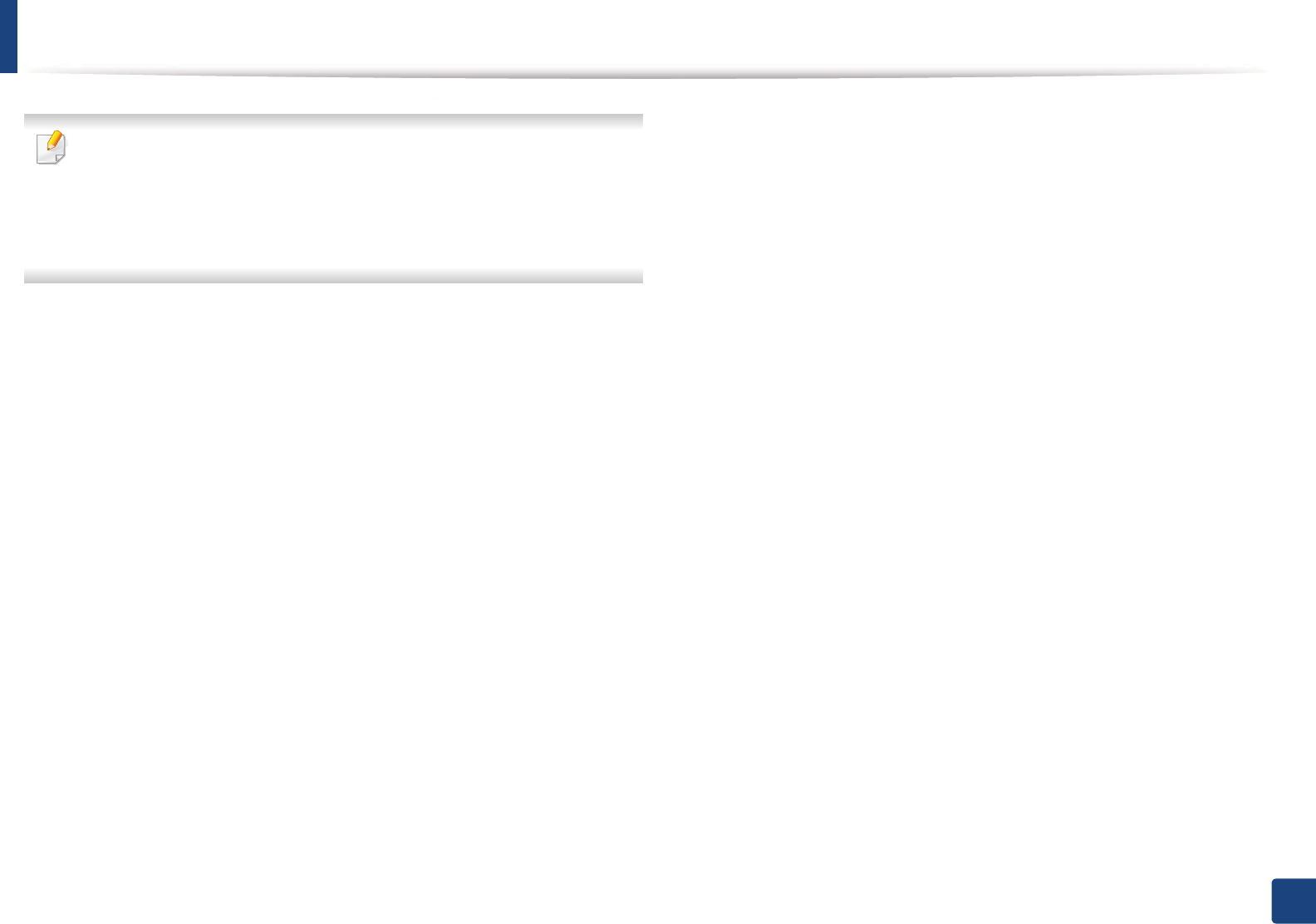
Cleaning the machine
71
3. Maintenance
• Use a dry lint-free cloth to clean the machine.
• Before opening the top cover, close the output support first.
• Turn the machine off and unplug the power cord. Wait for the machine
to cool down. If your machine has a power switch, turn the power switch
off before cleaning the machine.
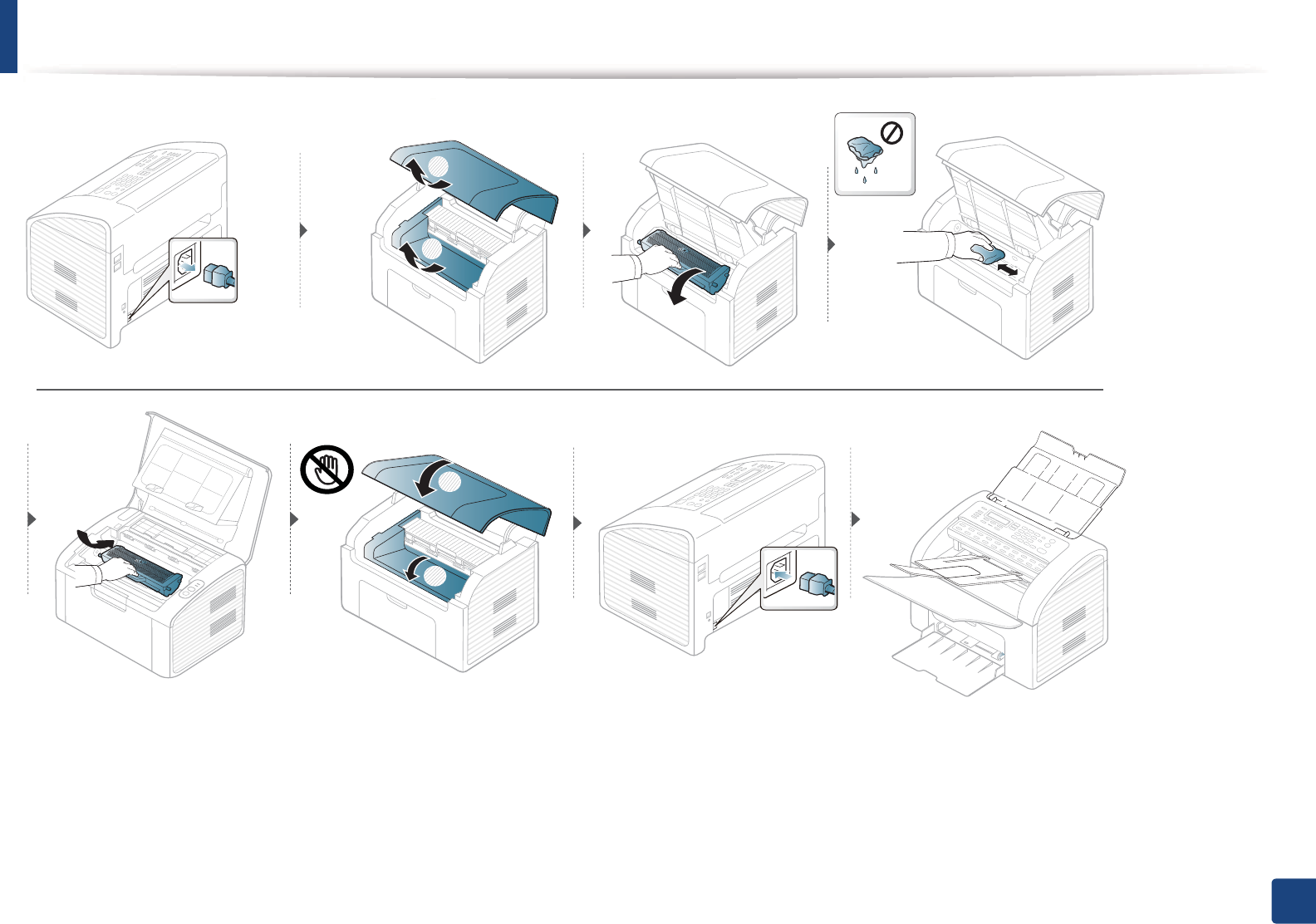
Cleaning the machine
72
3. Maintenance
2
1
1
2
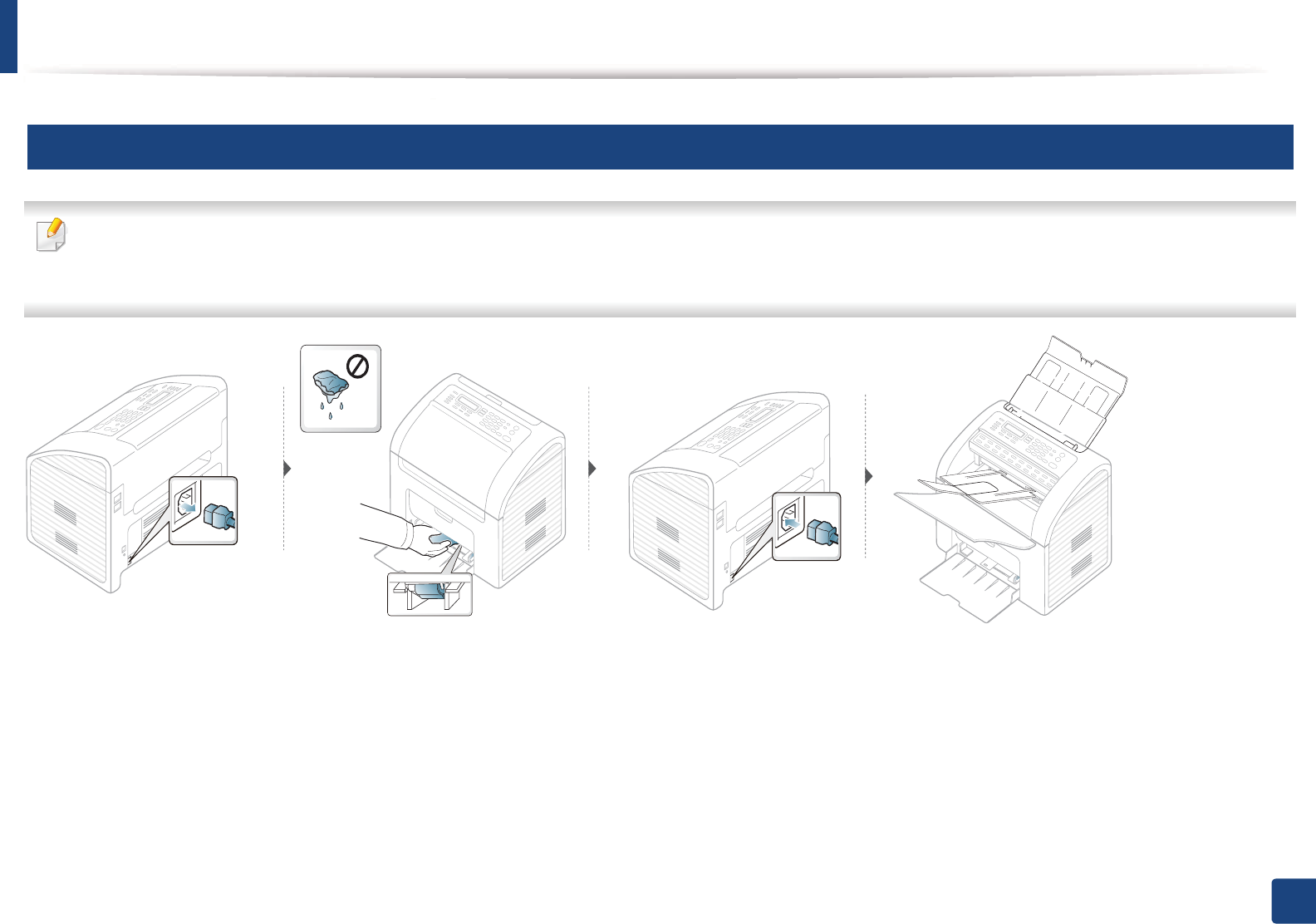
Cleaning the machine
73
3. Maintenance
6
Cleaning the pickup roller
• Use a dry lint-free cloth to clean the machine.
• Turn the machine off and unplug the power cord. Wait for the machine to cool down. If your machine has a power switch, turn the power switch off before
cleaning the machine.

Cleaning the machine
74
3. Maintenance
7
Cleaning the scan unit
Keeping the scan unit clean helps ensure the best possible copies. We suggest that you clean the scan unit at the start of each day and during the day as needed.
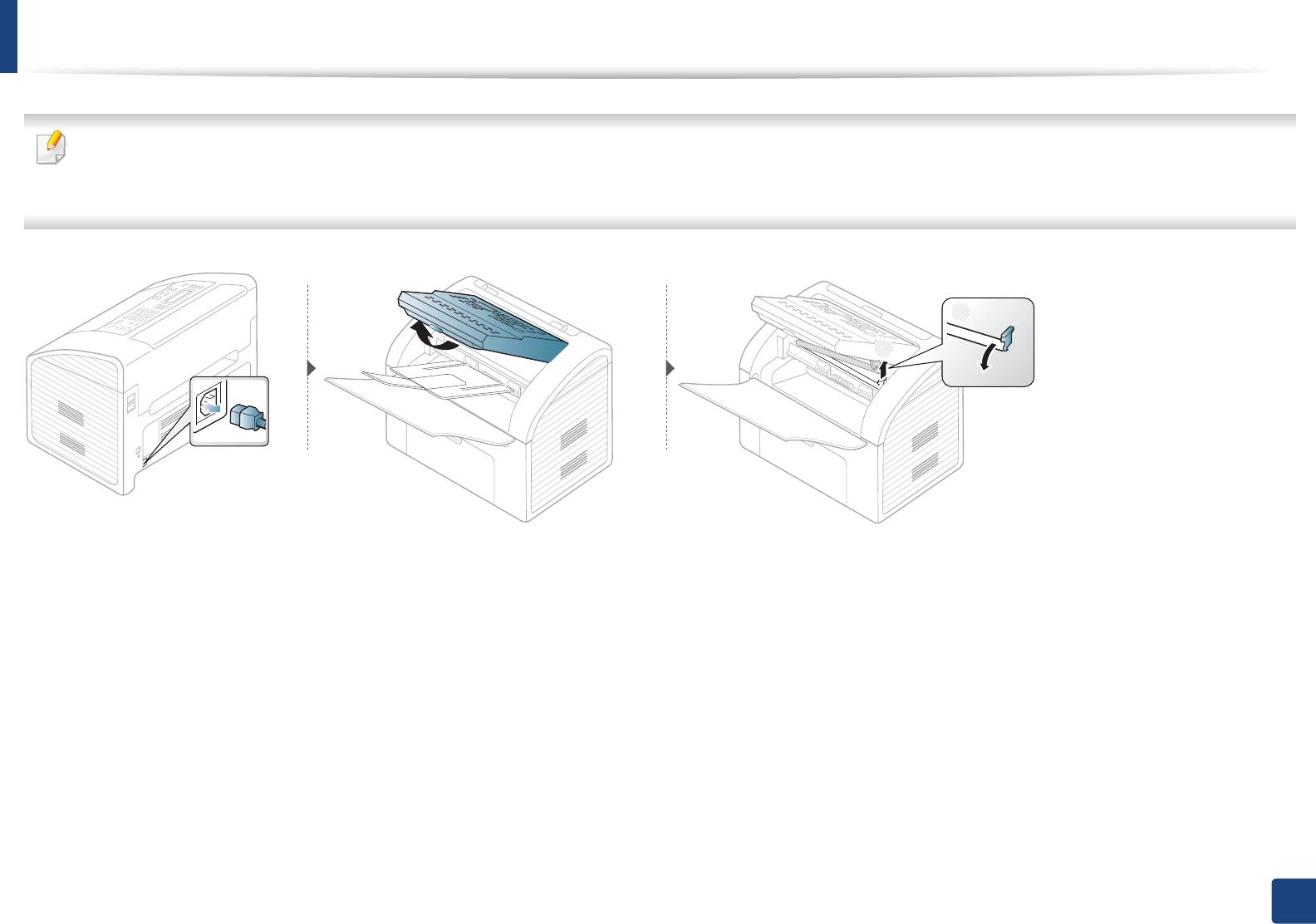
Cleaning the machine
75
3. Maintenance
• Turn the machine off and unplug the power cord. Wait for the machine to cool down. If your machine has a power switch, turn the power switch off before
cleaning the machine.
• If the document feeder output tray is inserted, remove the document feeder output tray.
2
1
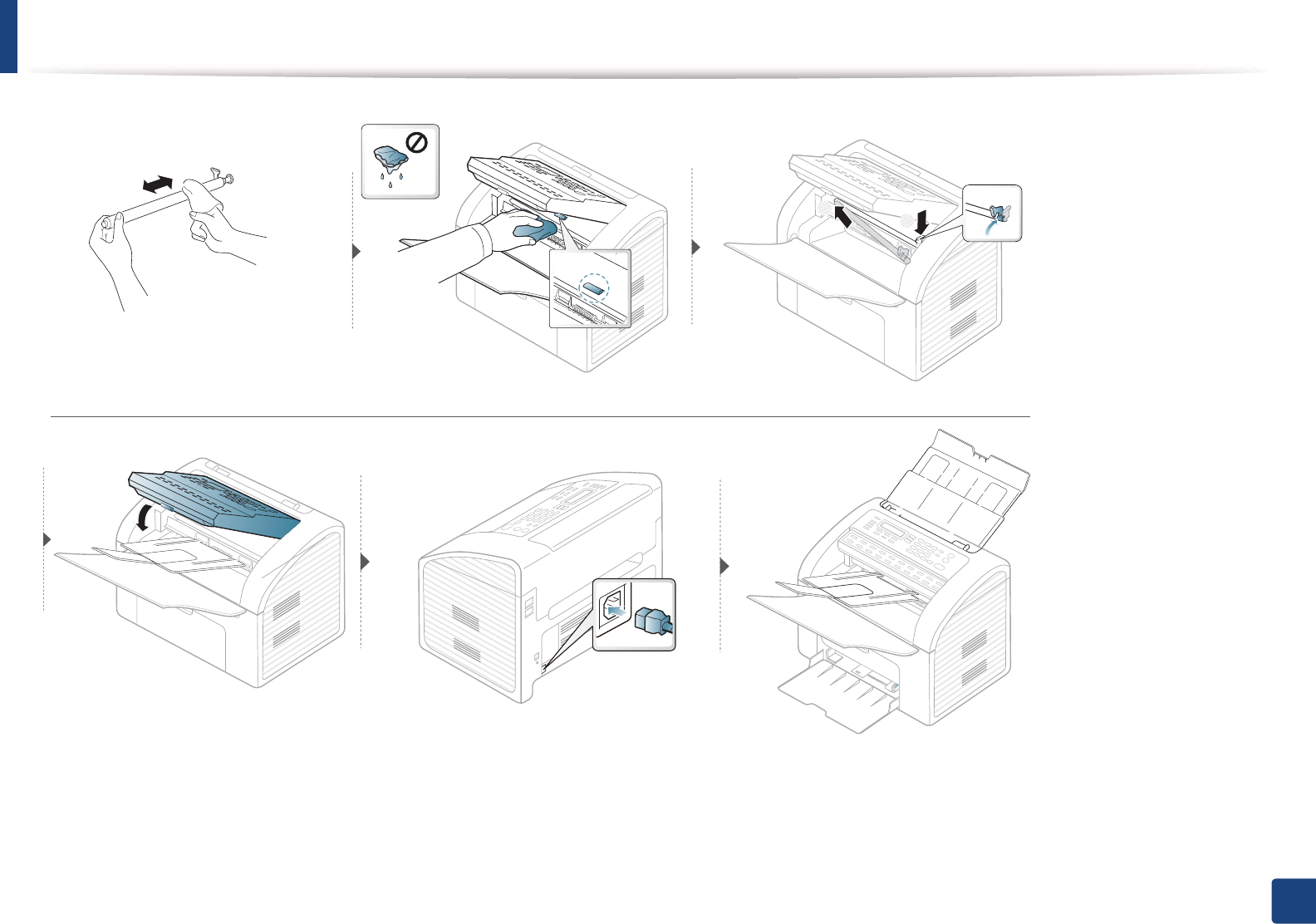
Cleaning the machine
76
3. Maintenance
1
2

77
3. Maintenance
Tips for moving & storing your machine
• When moving the machine, do not tilt or turn it upside down. Otherwise, the
inside of the machine may be contaminated by toner, which can cause
damage to the machine or reduce print quality.
• When moving the machine, make sure at least two people are holding the
machine securely.
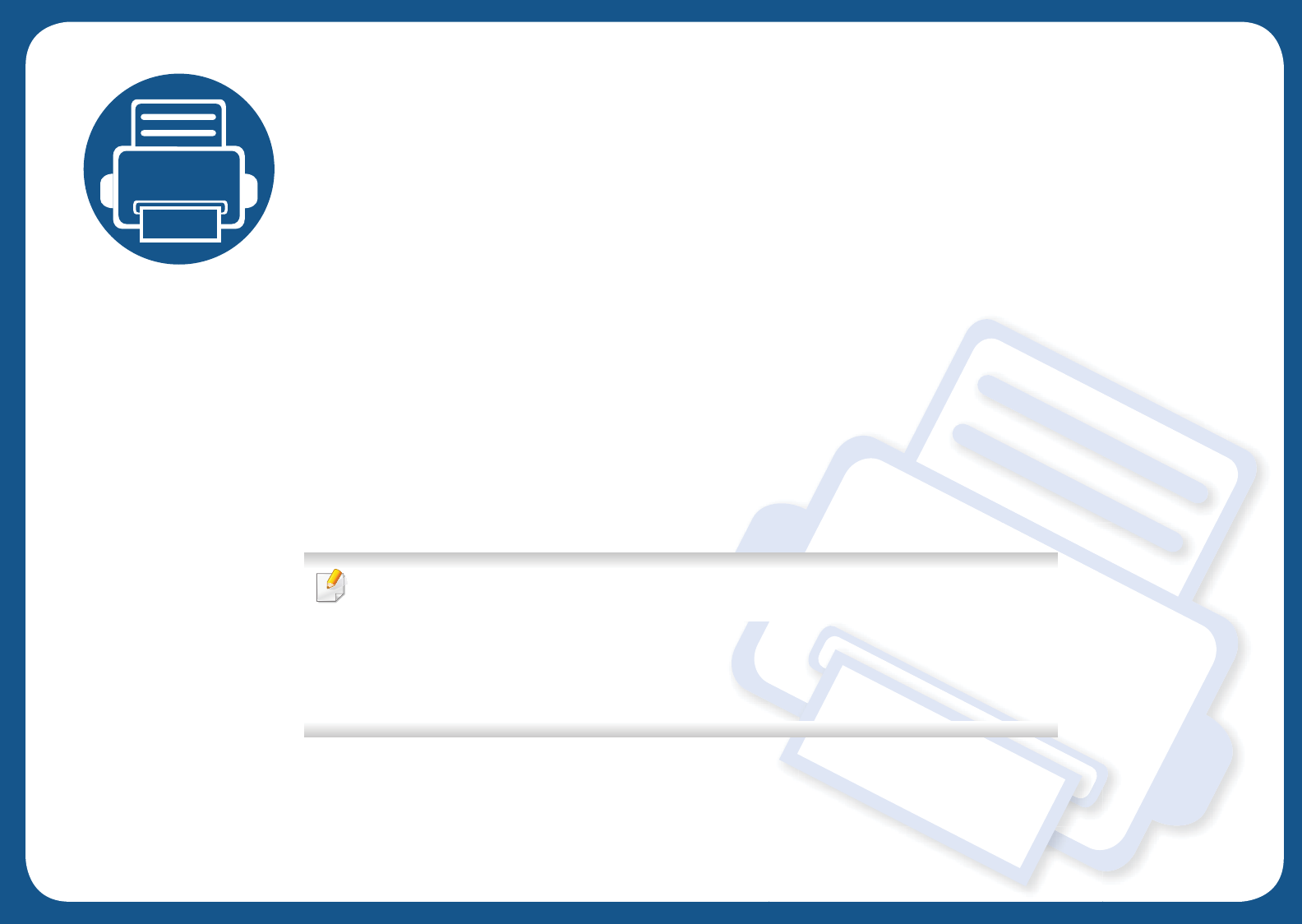
4. Troubleshooting
This chapter gives helpful information for what to do if you encounter an error.
• Tips for avoiding paper jams 79
• Clearing original document jams 80
• Clearing paper jams 82
• Understanding the status LED 85
• Understanding display messages 87
This chapter gives helpful information for what to do if you encounter an error. If your machine
has a display screen, check the message on the display screen first to solve the error.
If you cannot find a solution to your problem in this chapter, refer to the Troubleshooting
chapter in the Advanced User's Guide (see "Troubleshooting" on page 180).
If you cannot find a solution in the User's Guide or the problem persists, call for service.

79
4. Troubleshooting
Tips for avoiding paper jams
By selecting the correct media s, most paper jams can be avoided. To avoid paper jams, refer to the following guidelines:
• Ensure that the adjustable guides are positioned correctly (see "Tray overview" on page 36).
• Do not remove paper from the tray while your machine is printing.
• Flex, fan, and straighten paper before loading.
• Do not use creased, damp, or highly curled paper.
• Do not mix papers in a tray.
• Use only recommended print media (see "Print media specifications" on page 94).
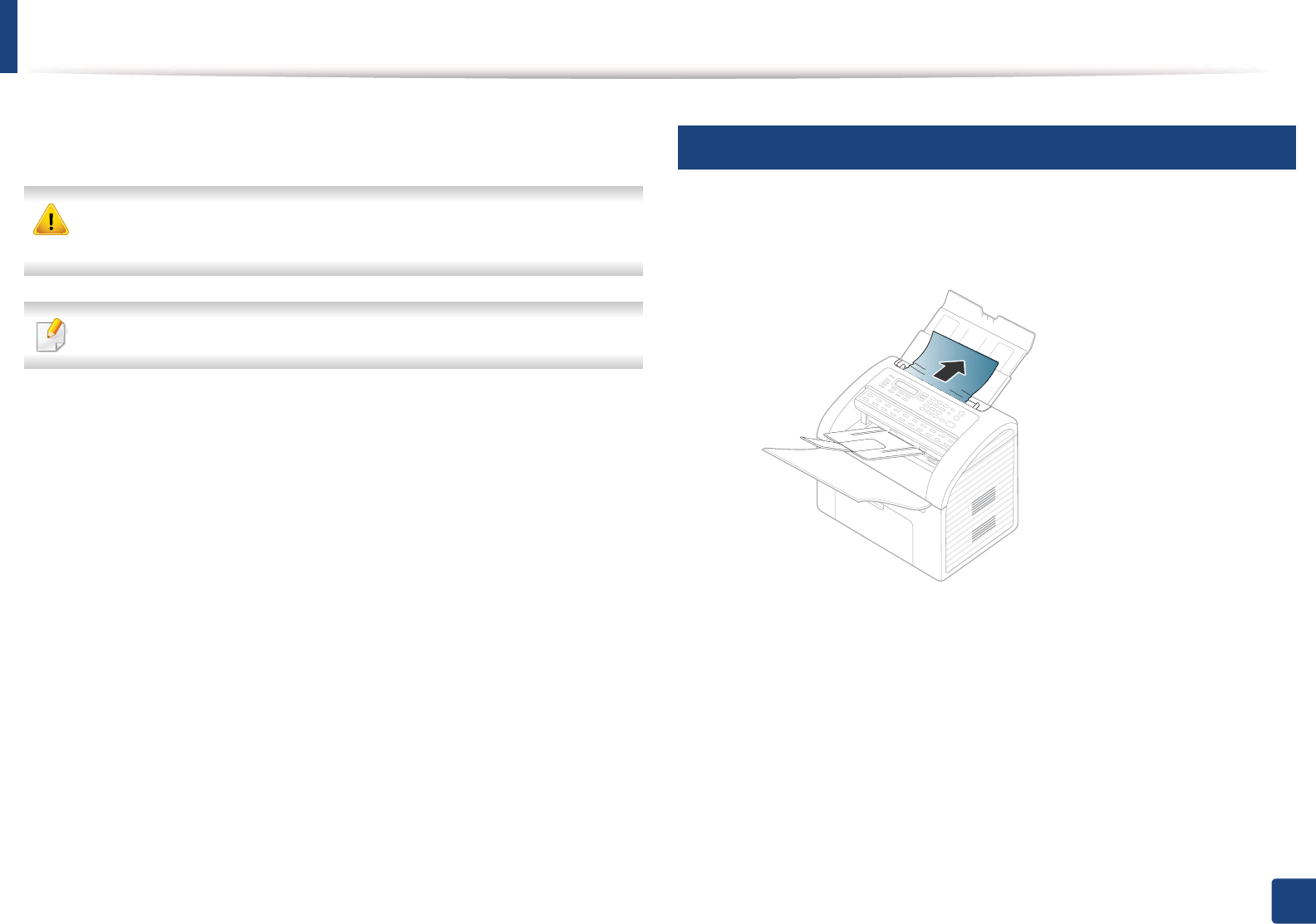
80
4. Troubleshooting
Clearing original document jams
When an original document jams in the document feeder, a warning message
appears on the display.
To avoid tearing the document, remove the jammed document slowly and
carefully.
To prevent document jams, do not use thick, thin or mixed documents.
1
Input Misfeed
1Remove any remaining pages from the document feeder.
2 Pull the jammed document gently out of the document feeder.
3 Load the documents back into the document feeder.
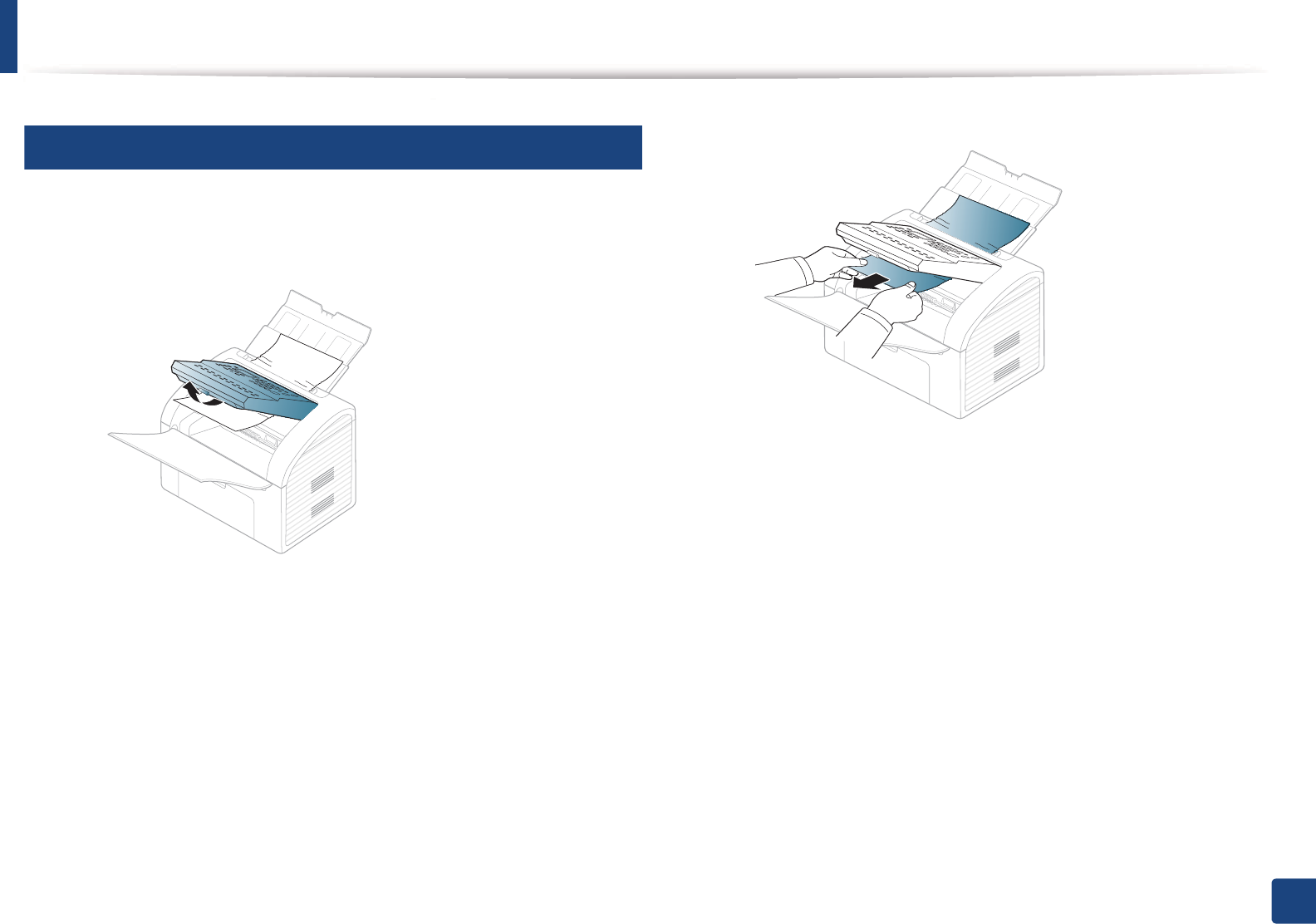
Clearing original document jams
81
4. Troubleshooting
2
Exit Misfeed
1Remove any remaining pages from the document feeder.
2 Open the control panel by gripping it on the bottom edge and pulling it.
3 Pull the document gently out of the document feeder.
4 Close the control panel. Then load the documents back into the
document feeder.
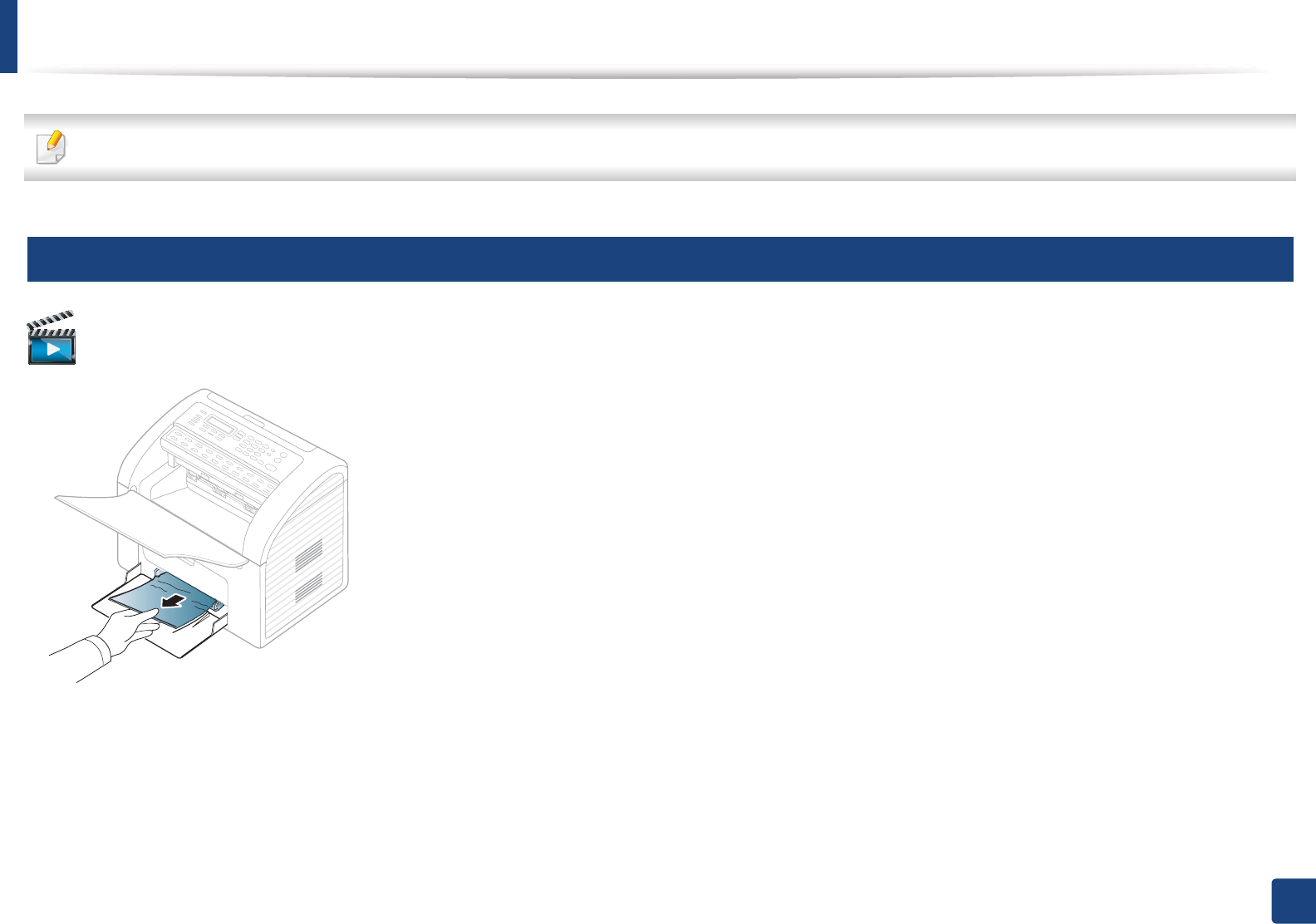
82
4. Troubleshooting
Clearing paper jams
To avoid tearing the paper, pull the jammed paper out slowly and gently.
3
In tray
Click this link to open an animation about clearing a jam.
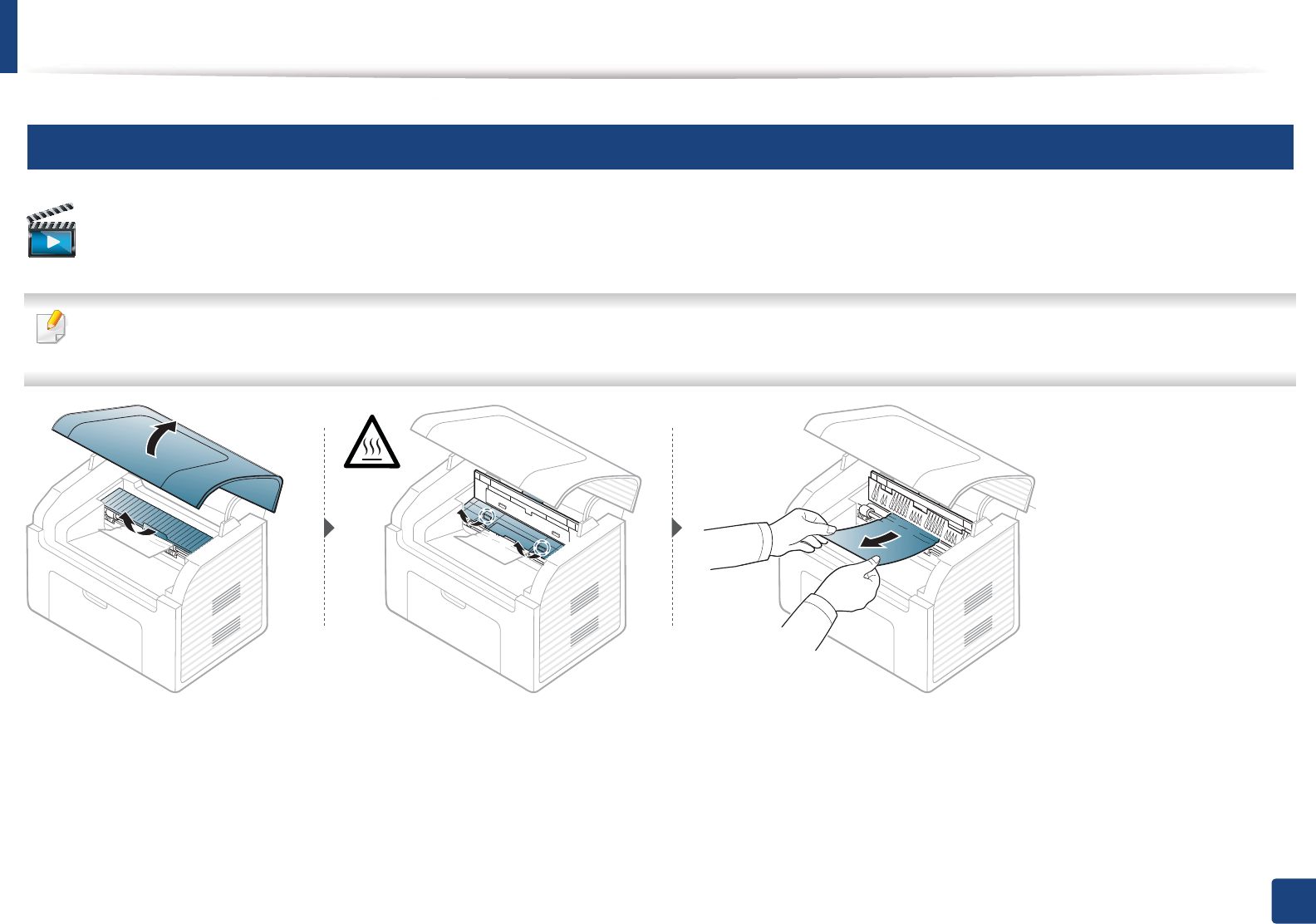
Clearing paper jams
83
4. Troubleshooting
4
Inside the machine
Click this link to open an animation about clearing a jam.
• The fuser area is hot. Take care when removing paper from the machine.
• Before opening the top cover, close the output tray first.
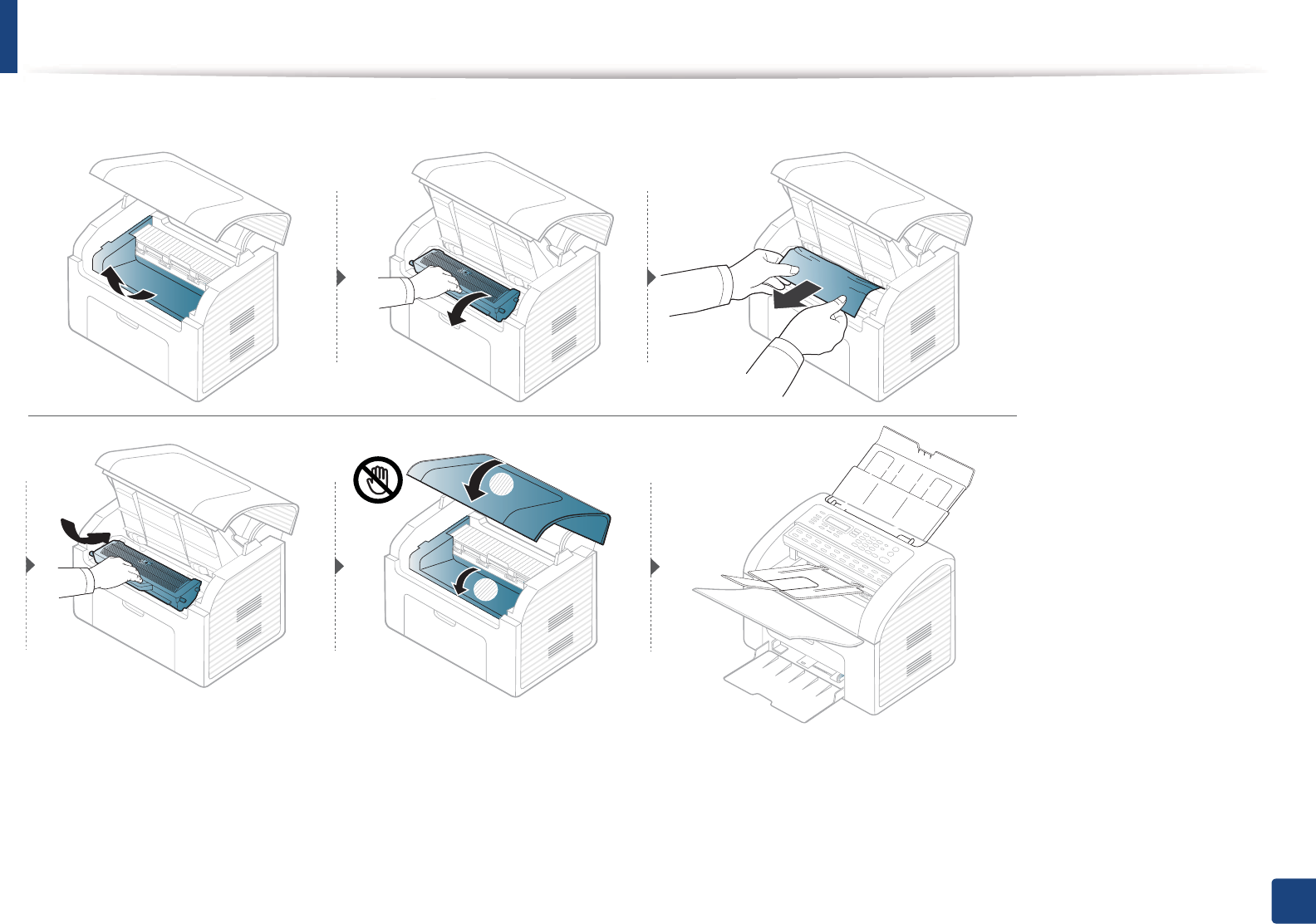
Clearing paper jams
84
4. Troubleshooting
If you do not see the paper in this area, stop and go to next step:
1
2
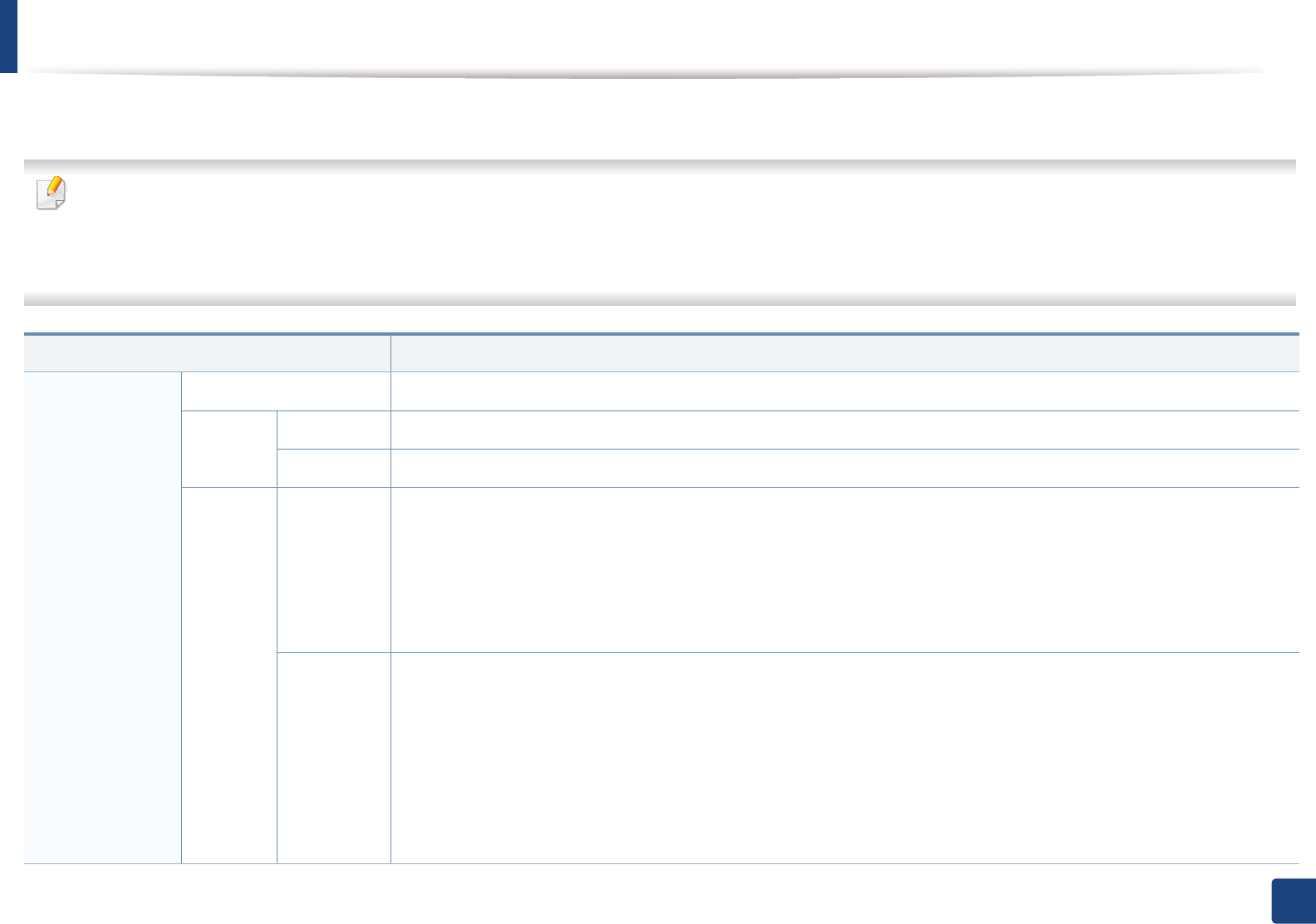
85
4. Troubleshooting
Understanding the status LED
The color of the LED indicates the machine's current status.
• To resolve the error, look at the error message and its instructions from the troubleshooting part (see"Understanding display messages" on page 87).
• You also can resolve the error with the guideline from the computers’s Printing Status or Smart Panel program window (see"Using Samsung Printer Status" on
page 173 or see"Using Smart Panel" on page 175
• If the problem persists, call a service representative.
Status Description
Status LED Off The machine is off-line.
Green Blinking When the backlight blinks, the machine is receiving or printing data.
On The machine is on-line and can be used.
Red Blinking • A minor error has occurred and the machine is waiting for the error to be cleared. Check the display message. When
the problem is cleared, the machine resumes. For some models that does not support the display screen on the
control panel, this feature is not applicable.
• Small amount of toner is left in the cartridge. The estimated cartridge lifea of toner is close. Prepare a new cartridge for
replacement. You may temporarily increase the printing quality by redistributing the toner (see "Redistributing toner"
on page 64).
On • A toner cartridge has almost reached its estimated cartridge lifea. It is recommended to replace the toner cartridge
(see "Replacing the toner cartridge" on page 66).
• The cover is opened. Close the cover.
• There is no paper in the tray when receiving or printing data. Load paper in the tray.
• The machine has stopped due to a major error. Check the display message (see "Understanding display messages" on
page 87).
• A paper jam has occurred (see "Clearing paper jams" on page 82).
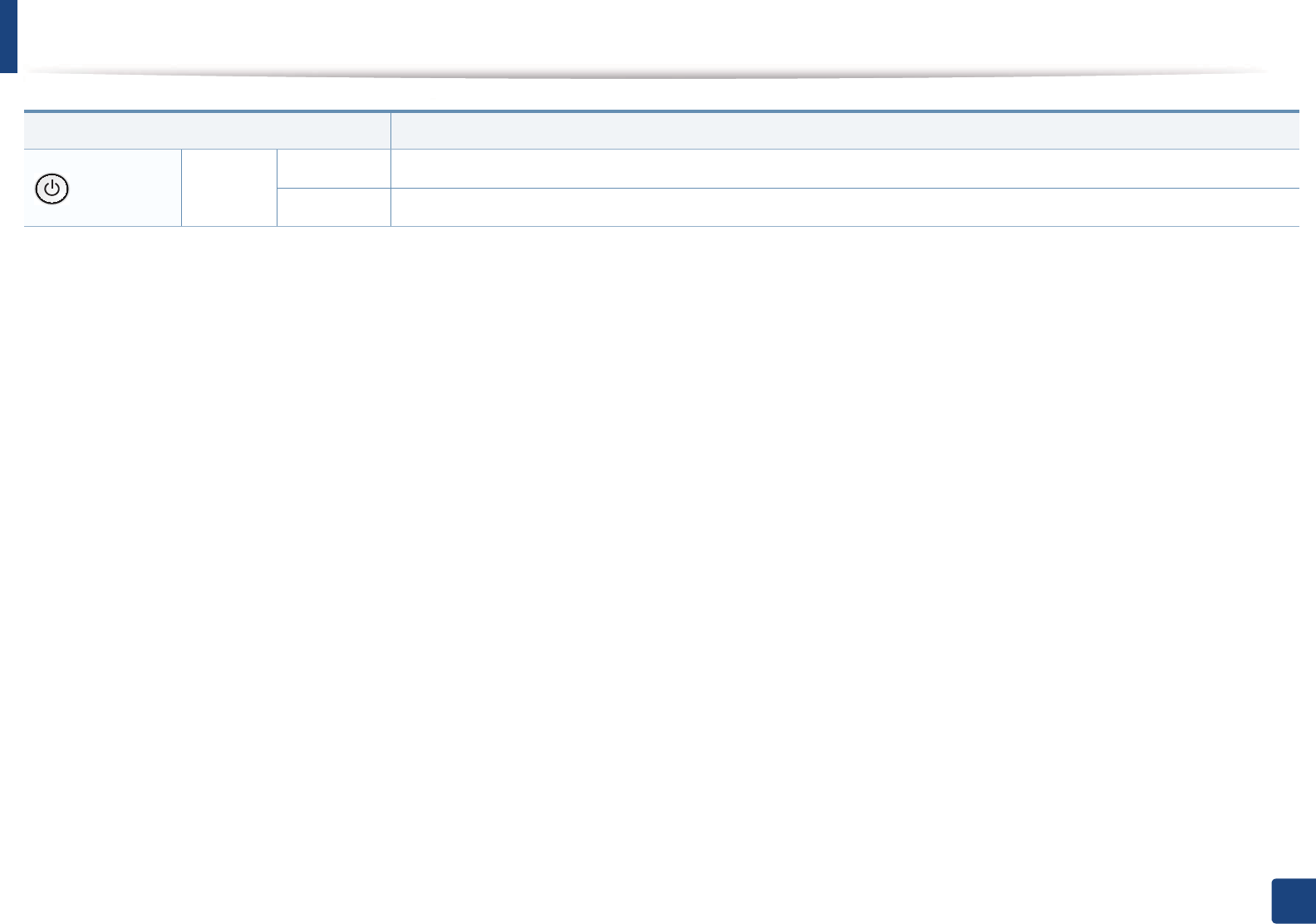
Understanding the status LED
86
4. Troubleshooting
Power LED
Blue On The machine is in power save mode.
Off The machine is in ready mode or machine’s power is off.
a. Estimated cartridge life means the expected or estimated toner cartridge life, which indicates the average capacity of print-outs and is designed pursuant to ISO/IEC 19752. The number of pages
may be affected by operating environment, percentage of image area, printing interval, graphics, media and media size. Some amount of toner may remain in the cartridge even when red LED is
on and the printer stops printing.
Status Description
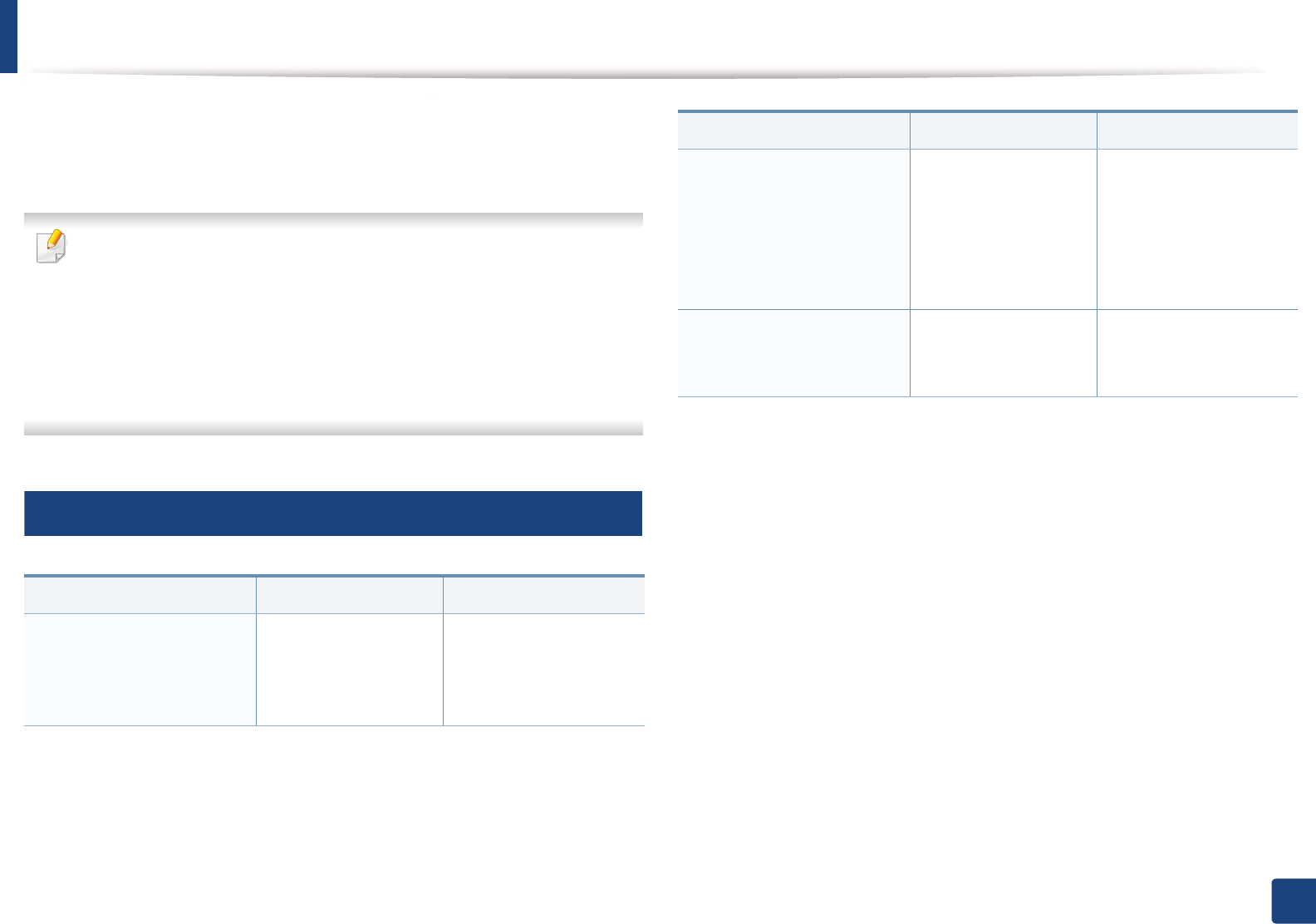
87
4. Troubleshooting
Understanding display messages
Messages appear on the control panel display to indicate the machine’s status
or errors. Refer to the tables below to understand the messages’ and their
meaning, and correct the problem, if necessary.
• If a message is not in the table, reboot the power and try the printing job
again. If the problem persists, call a service representative.
• When you call for service, provide the service representative with the
contents of display message.
• Some messages may not appear on the display depending on the
options or models.
• [error number] indicates the error number.
5
Paper Jam-related messages
Message Meaning Suggested solutions
Document jam.
Remove jam
The loaded original
document has
jammed in the
document feeder.
Clear the jam (see
"Clearing original
document jams" on
page 80).
Jam or Empty
Door Open&Close
• Paper has jammed
in the paper feed
area.
• There is no paper in
tray.
•Clear the jam (see "In
tray" on page 82).
• Load paper in tray
(see "Loading paper
in the tray" on page
37).
Paper Jam
inside machine
Paper has jammed in
the inside machine.
Clear the jam (see "Inside
the machine" on page
83).
Message Meaning Suggested solutions
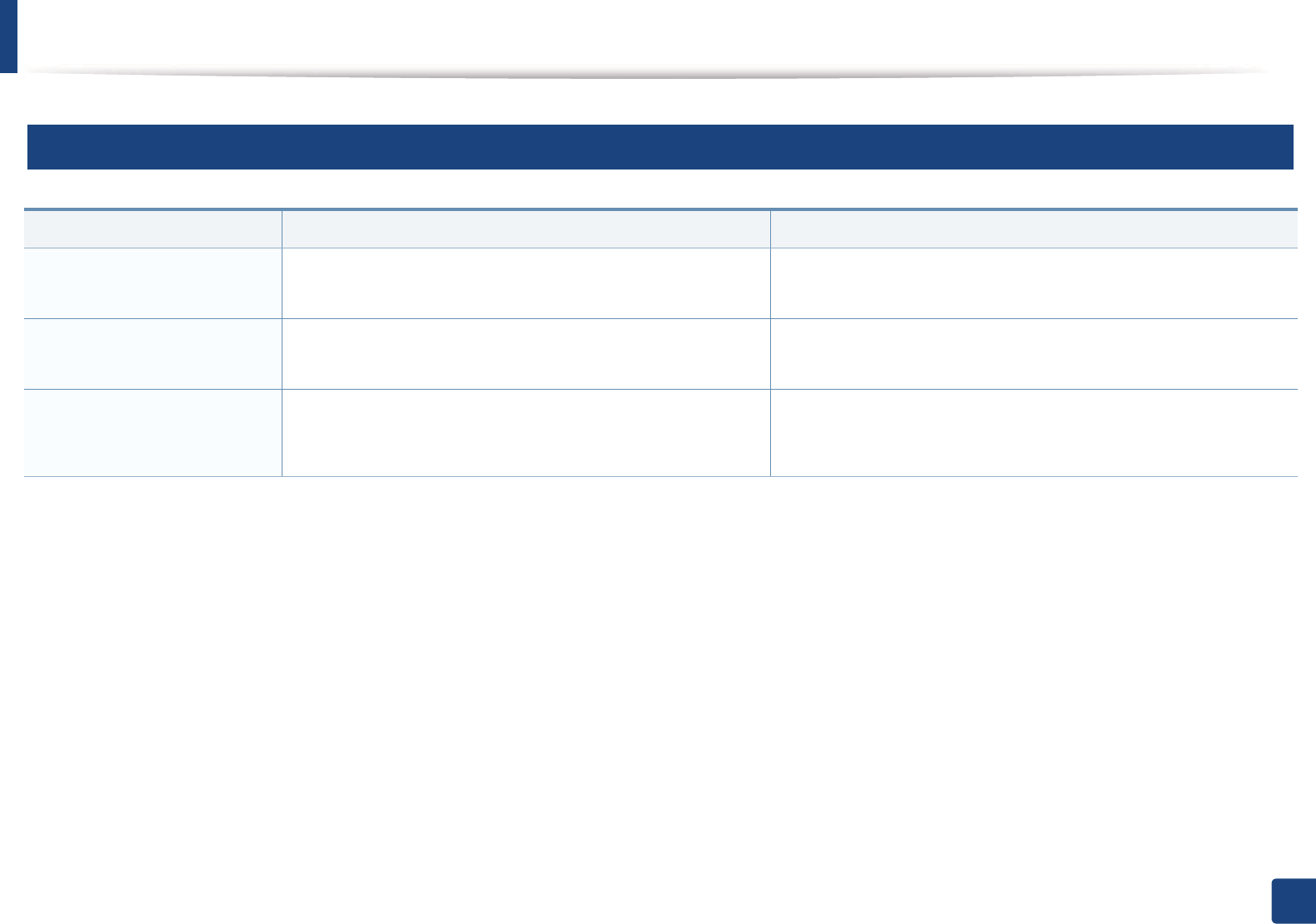
Understanding display messages
88
4. Troubleshooting
6
Toner-related messages
Message Meaning Suggested solutions
Install Toner
Cartridge
A toner cartridge is not installed. Install a toner cartridge.
Not compatible
toner cartridge
The toner cartridge you have installed is not for your machine. Install a Samsung-genuine toner cartridge, designed for your
machine.
Prepare new cartridge Small amount of toner is left in the indicated cartridge. The
estimated cartridge life of toner is close.
Prepare a new cartridge for a replacement. You may temporarily
increase the printing quality by redistributing the toner (see
"Redistributing toner" on page 64).
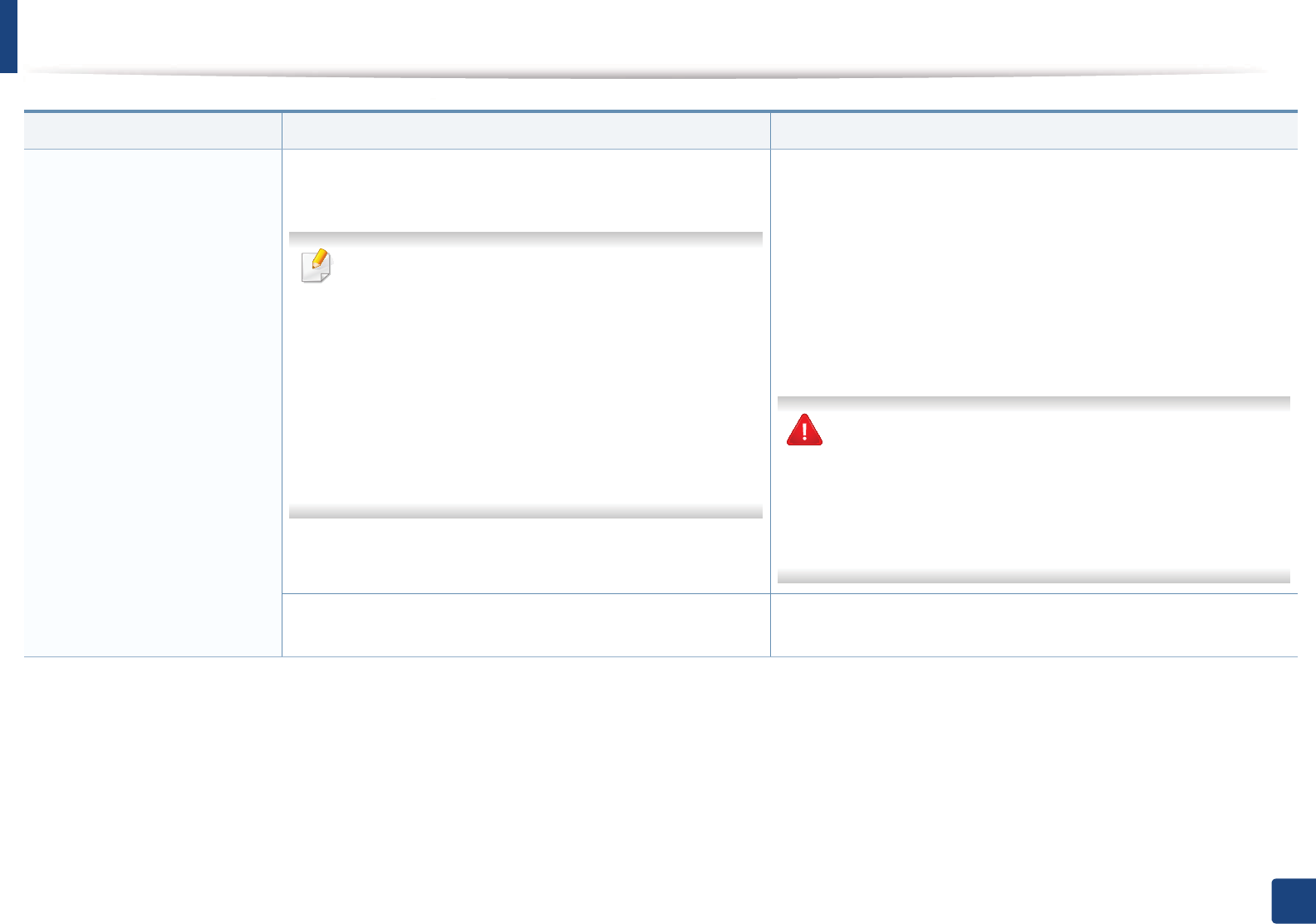
Understanding display messages
89
4. Troubleshooting
Replace new cartridge The indicated toner cartridge has almost reached its estimated
cartridge life.
Estimated cartridge life means the expected or
estimated toner cartridge life, which indicates the
average capacity of print-outs and is designed pursuant
to ISO/IEC 19752 (see "Available supplies" on page 60).
The number of pages may be affected by operating
environment, percentage of image area, printing
interval, media, percentage of image area, and media
size. Some amount of toner may remain in the cartridge
even when replace new cartridge appears and the
machine stops printing.
• You can choose Stop or Continue as shown on the control panel.
If you select Stop, the printer stops printing and you cannot print
any more without changing the cartridge. If you select Continue,
the printer keeps printing but the printing quality cannot be
guaranteed.
• Replace the toner cartridge for the best print quality when this
message appears. Using a cartridge beyond this stage can result in
printing quality issues (see "Replacing the toner cartridge" on
page 66).
Samsung does not recommend using a non-genuine
Samsung toner cartridge such as refilled or remanufactured.
Samsung cannot guarantee a non-genuine Samsung toner
cartridge's quality. Service or repair required as a result of
using non-genuine Samsung toner cartridges will not be
covered under the machine warranty.
The indicated toner cartridge has reached its estimated
cartridge life. The machine might stop printing.
Replace the toner cartridge (see "Replacing the toner cartridge" on
page 66).
Message Meaning Suggested solutions
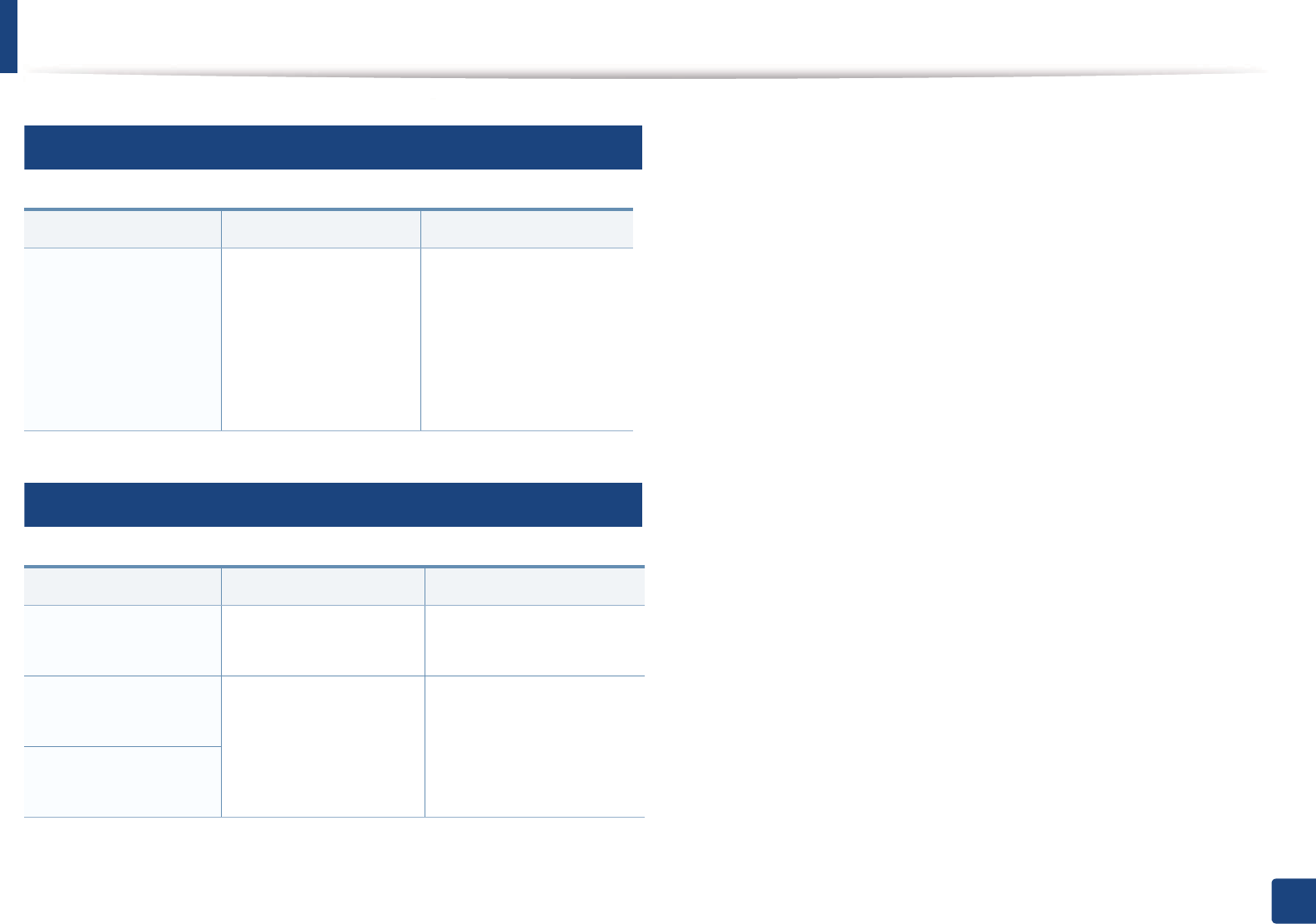
Understanding display messages
90
4. Troubleshooting
7
Tray-related messages
8
Misc. messages
Message Meaning Suggested solutions
Jam or Empty
Door Open&Close
• Paper has jammed in
the paper feed area.
• There is no paper in
tray or manual
feeder.
• Clear the jam (see "In
tray" on page 82).
• Load paper in tray (see
"Loading paper in the
tray" on page 37,
"Manual feeding in the
tray" on page 39).
Message Meaning Suggested solutions
Door Open
Close it
The cover is not securely
latched.
Close the cover until it
locks into place.
Error [error number]
Turn off then on
The machine unit cannot
be controlled.
Reboot the power and try
the printing job again. If
the problem persists,
please call for service.
Error [error number]
Call for service
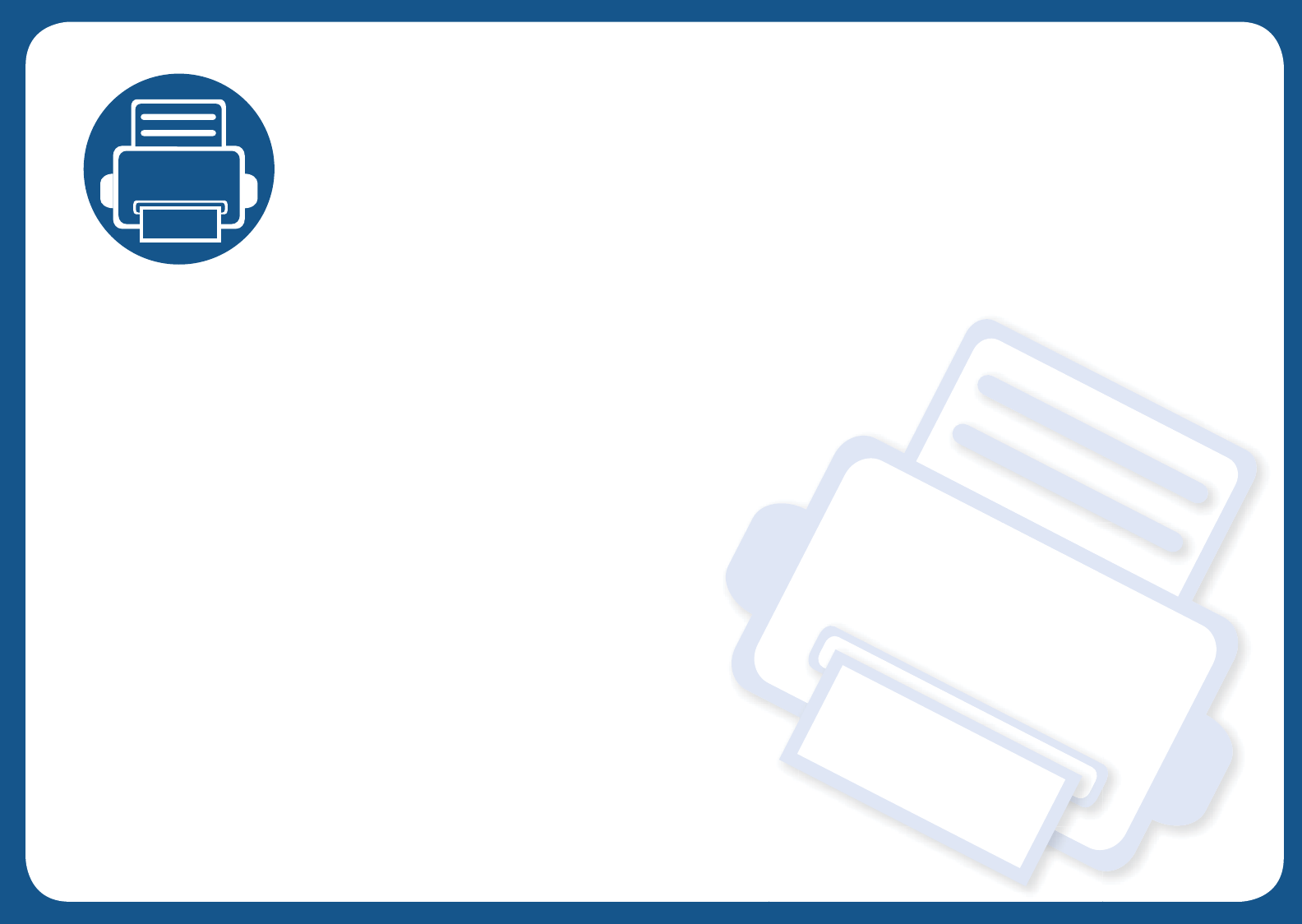
5. Appendix
This chapter provides product specifications and information concerning applicable regulations.
•Specifications 92
• Regulatory information 100
• Copyright 110
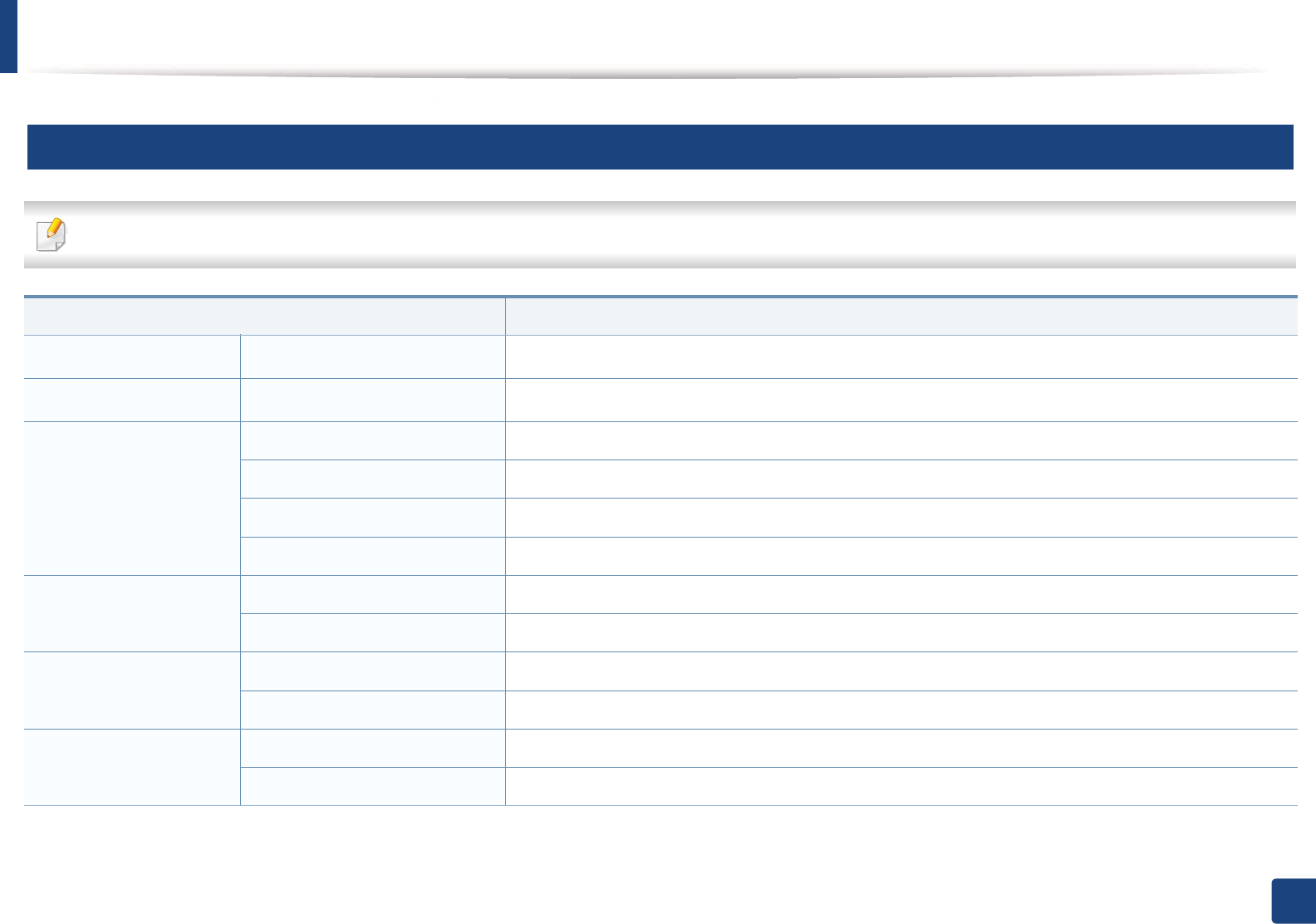
92
5. Appendix
Specifications
1
General specifications
The specification values listed below are subject to change without notice. See www.samsung.com for possible changes in information.
Items Description
DimensionaWidth x Length x Height 362 x 260 x 280 mm (14.25 x 10.24 x 11.02 inches)
WeightaMachine with consumables 6.4 Kg (14.11 Ibs)
Noise LevelbReady mode 26 dB (A)
Print mode Less than 50 dB (A)
Copy mode Less than 52 dB (A)
Scan mode Less than 52 dB (A)
Temperature Operation 10 to 32°C (50 to 89.6°F)
Storage (packed) -20 to 40°C (-4 to 104°F)
Humidity Operation 20 to 80% RH
Storage (packed) 10 to 90% RH
Power ratingc110 volt models AC 110 - 127 V
220 volt models AC 220 - 240 V

Specifications
93
5. Appendix
Power consumption Average operating mode Less than 310 W
Ready mode Less than 30 W
Power save mode Less than 2.3 W
Power off mode Less than 0.45 W (0.1 Wd)
a. Not included Handset.
b. Sound Pressure Level, ISO 7779. Configuration tested: basic machine installation, A4 paper, simplex printing.
c. See the rating label on the machine for the correct voltage (V), frequency (hertz) and of current (A) for your machine.
d. For the machine that has a power switch.
Items Description
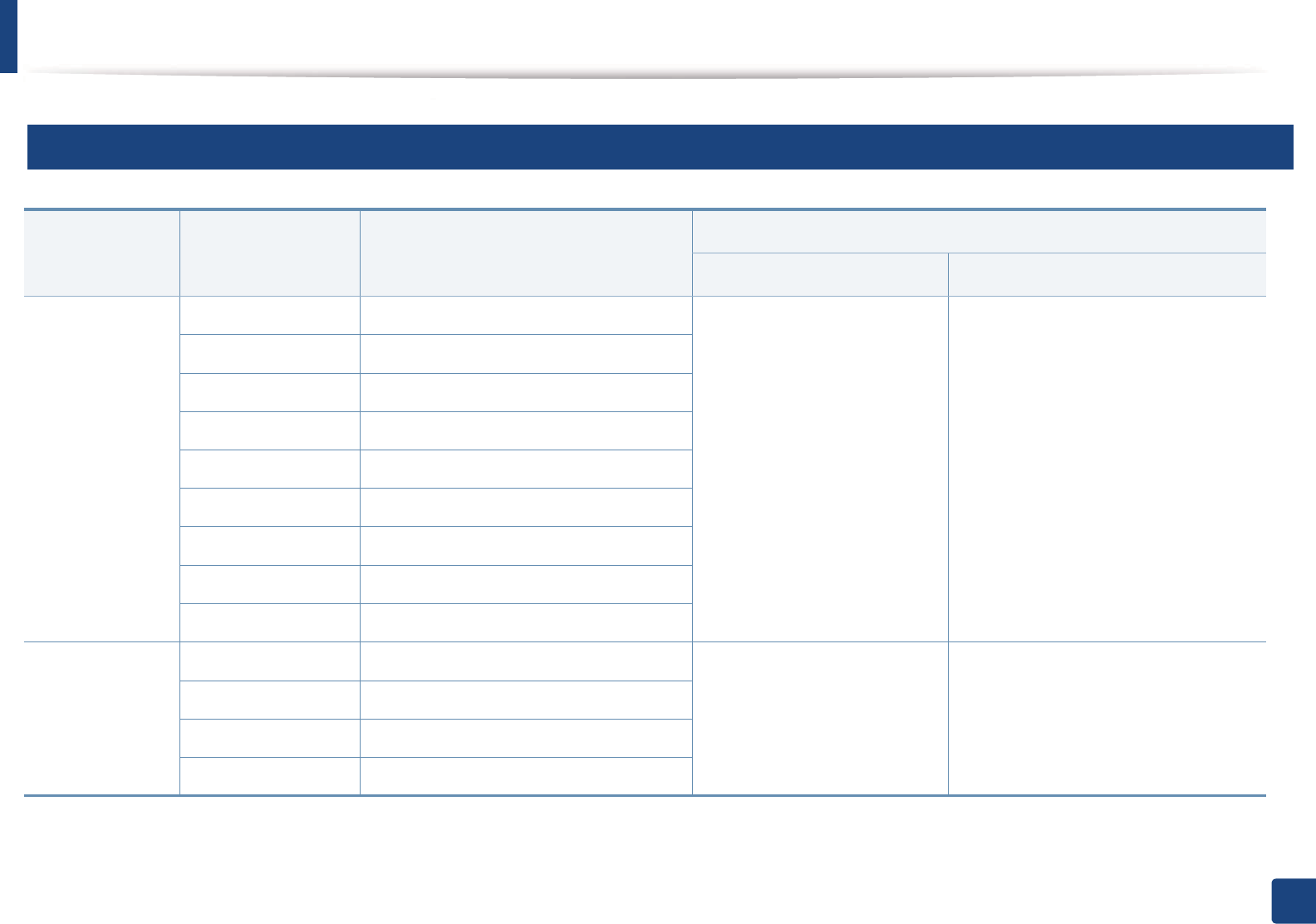
Specifications
94
5. Appendix
2
Print media specifications
Type Size Dimensions
Print media weight/Capacitya
Tray Manual feeding in trayb
Plain paper
Letter 216 x 279 mm (8.5 x 11 inches) 71 to 85 g/m2 (19 to 23 lbs
bond)
• 150 sheets of 80 g/m2 (21 lbs
bond)
71 to 85 g/m2 (19 to 23 lbs bond)
• 1 sheets
Legal 216 x 356 mm (8.5 x 14 inches)
US Folio 216 x 330 mm (8.5 x 13 inches)
A4 210 x 297 mm (8.27 x 11.69 inches)
Oficio 216 x 343 mm (8.5 x 13.5 inches)
JIS B5 182 x 257 mm (7.17 x 10.12 inches)
ISO B5 176 x 250 mm (6.93 x 9.84 inches)
Executive 184 x 267 mm (7.25 x 10.5 inches)
A5 148 x 210 mm (5.83 x 8.27 inches)
Envelope
Envelope Monarch 98 x 191 mm (3.87 x 7.5 inches) 75 to 90 g/m2 (20 to 24 lbs
bond)
• 10 sheets
75 to 90 g/m2 (20 to 24 lbs bond)
• 1 sheets
Envelope No. 10 105 x 241 mm (4.12 x 9.5 inches)
Envelope DL 110 x 220 mm (4.33 x 8.66 inches)
Envelope C5 162 x 229 mm (6.38 x 9.02 inches)
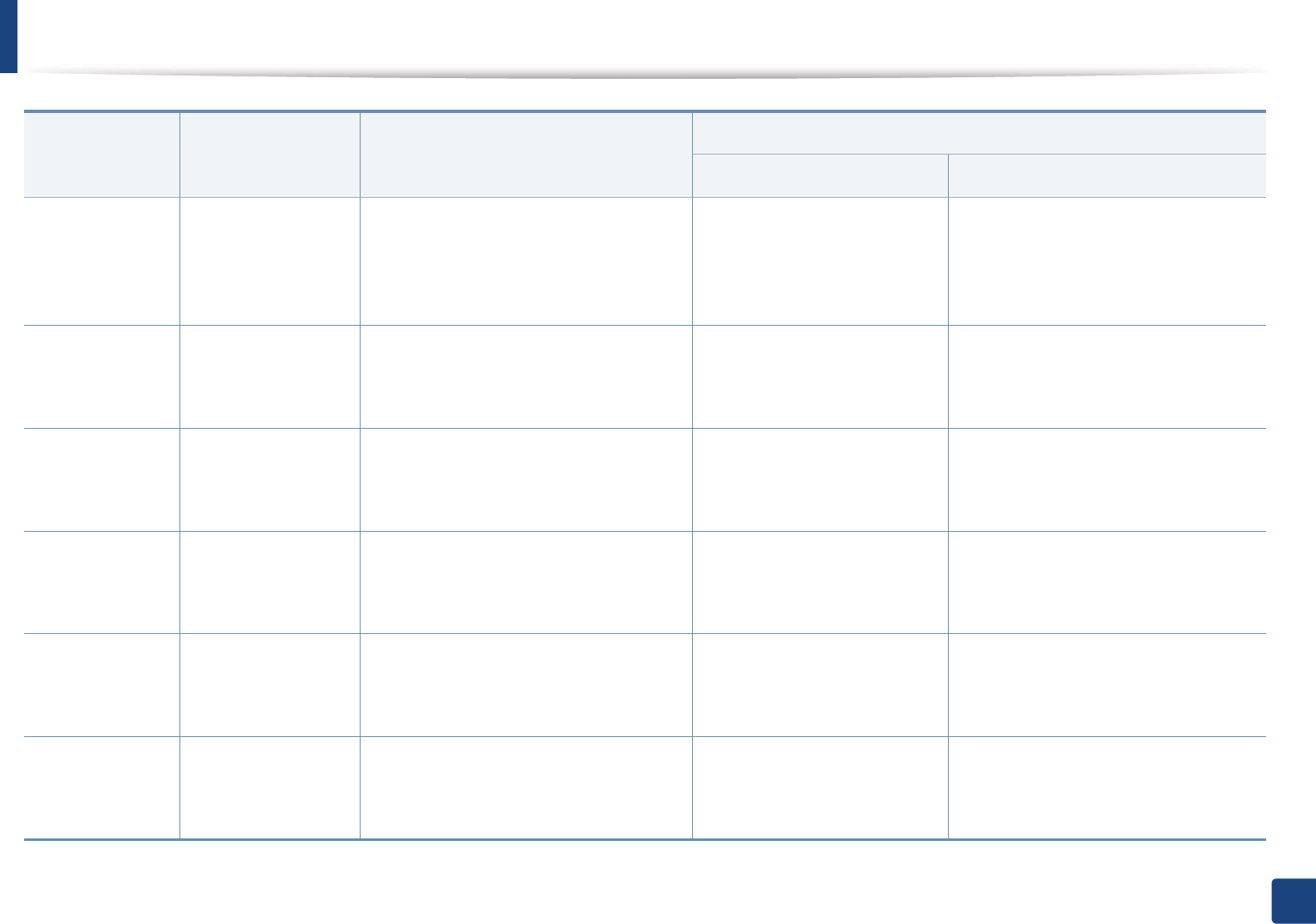
Specifications
95
5. Appendix
Thick paper Refer to the Plain
paper section
Refer to the Plain paper section 86 to 120 g/m2 (23 to 32 lbs
bond)
• 50 sheets of 120 g/m2 (32 lbs
bond)
86 to 120 g/m2 (23 to 32 lbs bond)
• 1 sheets
Thin paper Refer to the Plain
paper section
Refer to the Plain paper section 60 to 70 g/m2 (16 to 19 lbs bond)
• 160 sheets of 60 g/m2 (16 lbs
bond)
60 to 70 g/m2 (16 to 19 lbs bond)
• 1 sheets
Cotton Refer to the Plain
paper section
Refer to the Plain paper section 75 to 90 g/m2 (20 to 24 lbs bond)
• 150 sheets of 80 g/m2 (21 lbs
bond)
75 to 90 g/m2 (20 to 24 lbs bond)
• 1 sheets
Colored Refer to the Plain
paper section
Refer to the Plain paper section 75 to 90 g/m2 (20 to 24 lbs bond)
• 150 sheets of 80 g/m2 (21 lbs
bond)
75 to 90 g/m2 (20 to 24 lbs bond)
• 1 sheets
Pre-printed Refer to the Plain
paper section
Refer to the Plain paper section 75 to 90 g/m2 (20 to 24 lbs bond)
• 150 sheets of 80 g/m2 (21 lbs
bond)
75 to 90 g/m2 (20 to 24 lbs bond)
• 1 sheets
Recycled Refer to the Plain
paper section
Refer to the Plain paper section 60 to 90 g/m2 (16 to 24 lbs bond)
• 150 sheets of 80 g/m2 (21 lbs
bond)
60 to 90 g/m2 (16 to 24 lbs bond)
• 1 sheets
Type Size Dimensions
Print media weight/Capacitya
Tray Manual feeding in trayb
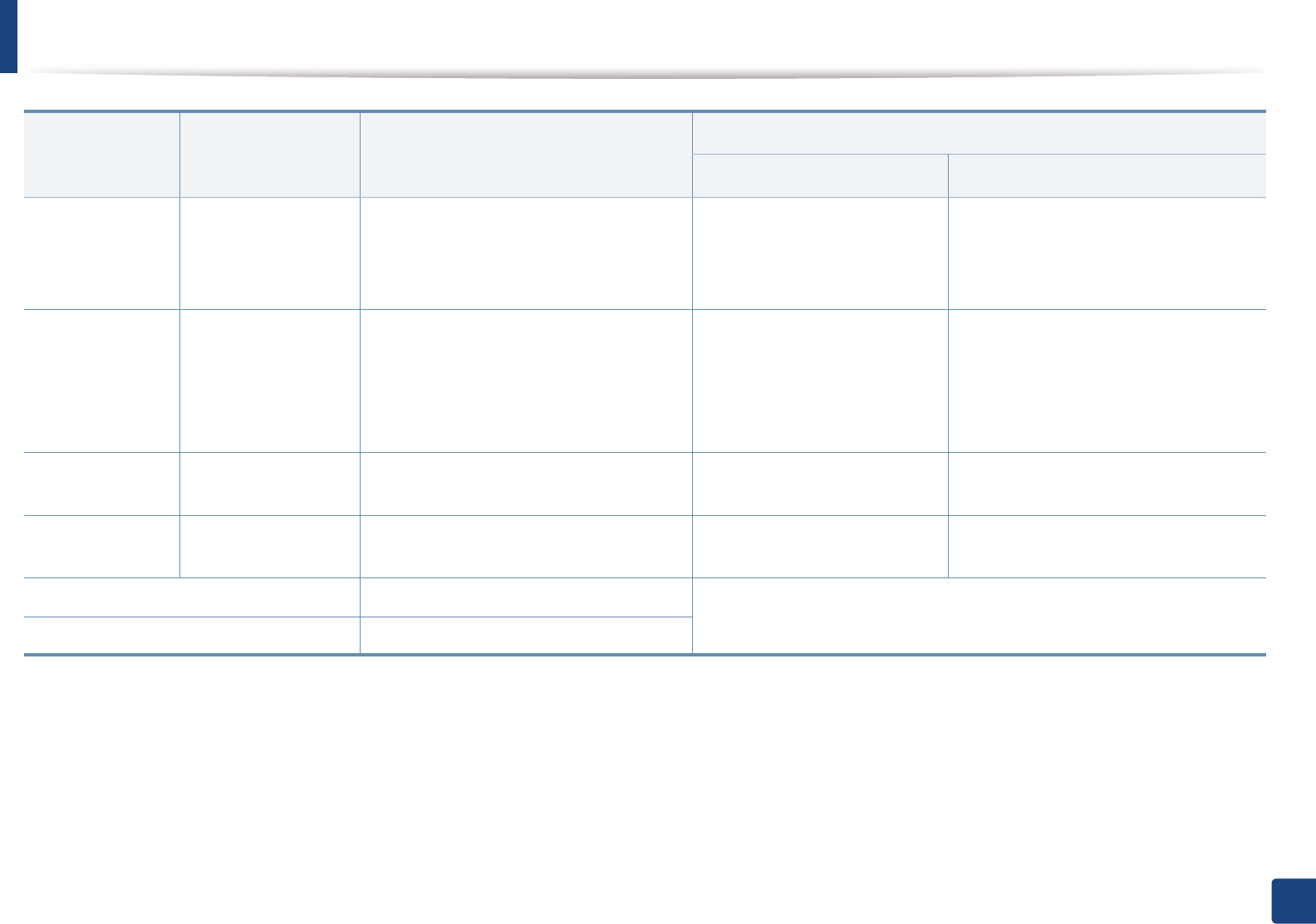
Specifications
96
5. Appendix
Labelsc
Letter, Legal, Oficio,
US Folio, A4, JIS B5,
ISO B5, Executive,
A5
Refer to the Plain paper section 120 to 150 g/m2 (32 to 40 lbs
bond)
• 10 sheets
120 to 150 g/m2 (32 to 40 lbs bond)
• 1 sheets
Card stock
Letter, Legal, Oficio,
US Folio, A4, JIS B5,
ISO B5, Executive,
A5,
Postcard 4x6
Refer to the Plain paper section 121 to 163 g/m2 (32 to 43 lbs
bond)
• 10 sheets
121 to 163 g/m2 (32 to 43 lbs bond)
• 1 sheets
Bond paper Refer to the Plain
paper section
Refer to the Plain paper section • 10 sheets • 1 sheets
Archive Refer to the Plain
paper section
Refer to the Plain paper section • 100 sheets • 1 sheets
Minimum size (custom) 76 x 127 mm (3 x 5 inches) 60 to 163 g/m2 (16 to 43 lbs bond)
Maximum size (custom) 216 x 356 mm (8.5 x 14 inches)
a. Maximum capacity may differ depending on media weight, thickness, and environmental conditions.
b. 1 sheet for manual feeder.
c. The smoothness of the labels used in this machine is 100 to 250 (sheffield). This means the numeric level of smoothness.
Type Size Dimensions
Print media weight/Capacitya
Tray Manual feeding in trayb
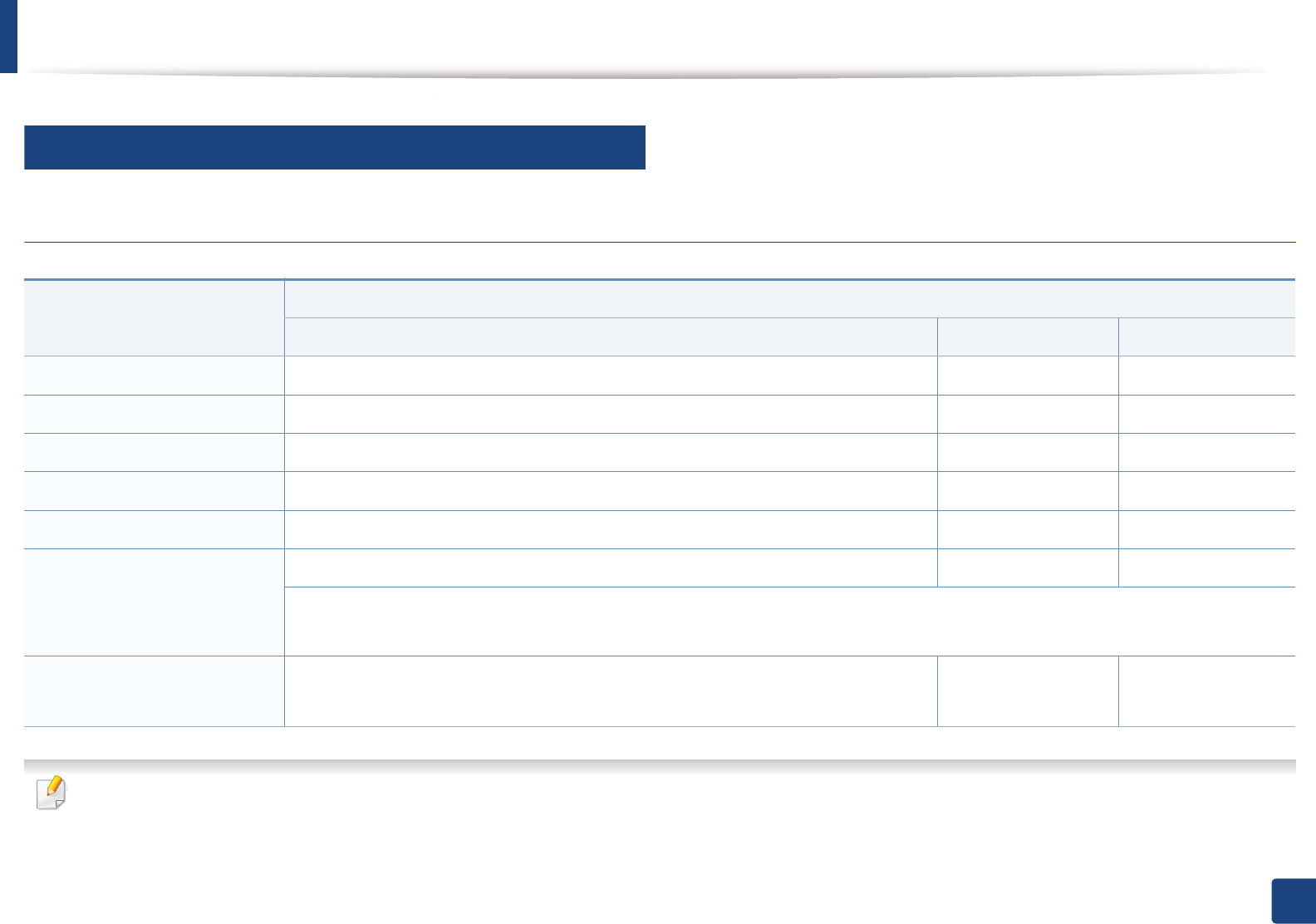
Specifications
97
5. Appendix
3
System requirements
Microsoft® Windows®
• Internet Explorer 6.0 or higher is the minimum requirement for all Windows operating systems.
• Users who have administrator rights can install the software.
Operating system
Requirement (recommended)
CPU RAM free HDD space
Windows® 2000 Intel® Pentium® II 400 MHz (Pentium III 933 MHz) 64 MB (128 MB) 600 MB
Windows® XP Intel® Pentium® III 933 MHz (Pentium IV 1 GHz) 128 MB (256 MB) 1.5 GB
Windows Server® 2003 Intel® Pentium® III 933 MHz (Pentium IV 1 GHz) 128 MB (512 MB) 1.25 GB to 2 GB
Windows Server® 2008 Intel® Pentium® IV 1 GHz (Pentium IV 2 GHz) 512 MB (2 GB) 10 GB
Windows Vista® Intel® Pentium® IV 3 GHz 512 MB (1 GB) 15 GB
Windows® 7 Intel® Pentium® IV 1 GHz 32-bit or 64-bit processor or higher 1 GB (2 GB) 16 GB
• Support for DirectX® 9 graphics with 128 MB memory (to enable the Aero theme).
•DVD-R/W Drive
Windows Server® 2008 R2 Intel® Pentium® IV 1 GHz (x86) or 1.4 GHz (x64) processors (2 GHz or faster) 512 MB (2 GB) 10 GB
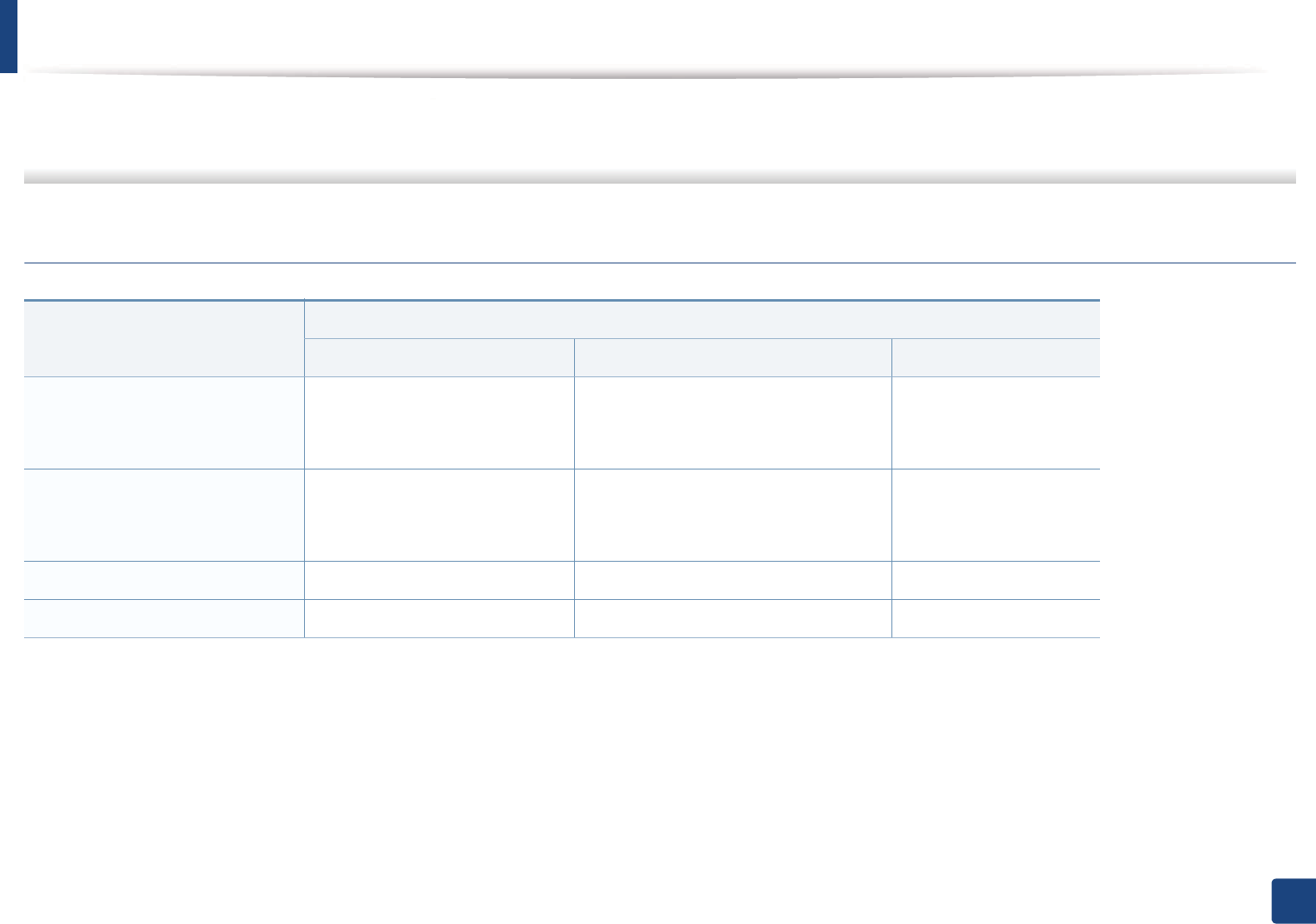
Specifications
98
5. Appendix
•Windows Terminal Services is compatible with your machine.
•For Windows 2000, Services Pack 4 or higher is required.
Macintosh
Operating system
Requirements (Recommended)
CPU RAM Free HDD space
Mac OS X 10.4 • Intel® processors
•PowerPC G4/G5
• 128 MB for a powerPC based Mac
(512 MB)
• 512 MB for an Intel-based Mac (1 GB)
1 GB
Mac OS X 10.5 • Intel® processors
• 867 MHz or faster Power PC G4/
G5
512 MB (1 GB) 1 GB
Mac OS X 10.6 • Intel® processors 1 GB (2 GB) 1 GB
Mac OS X 10.7 • Intel® processors 1 GB (2 GB) 1 GB
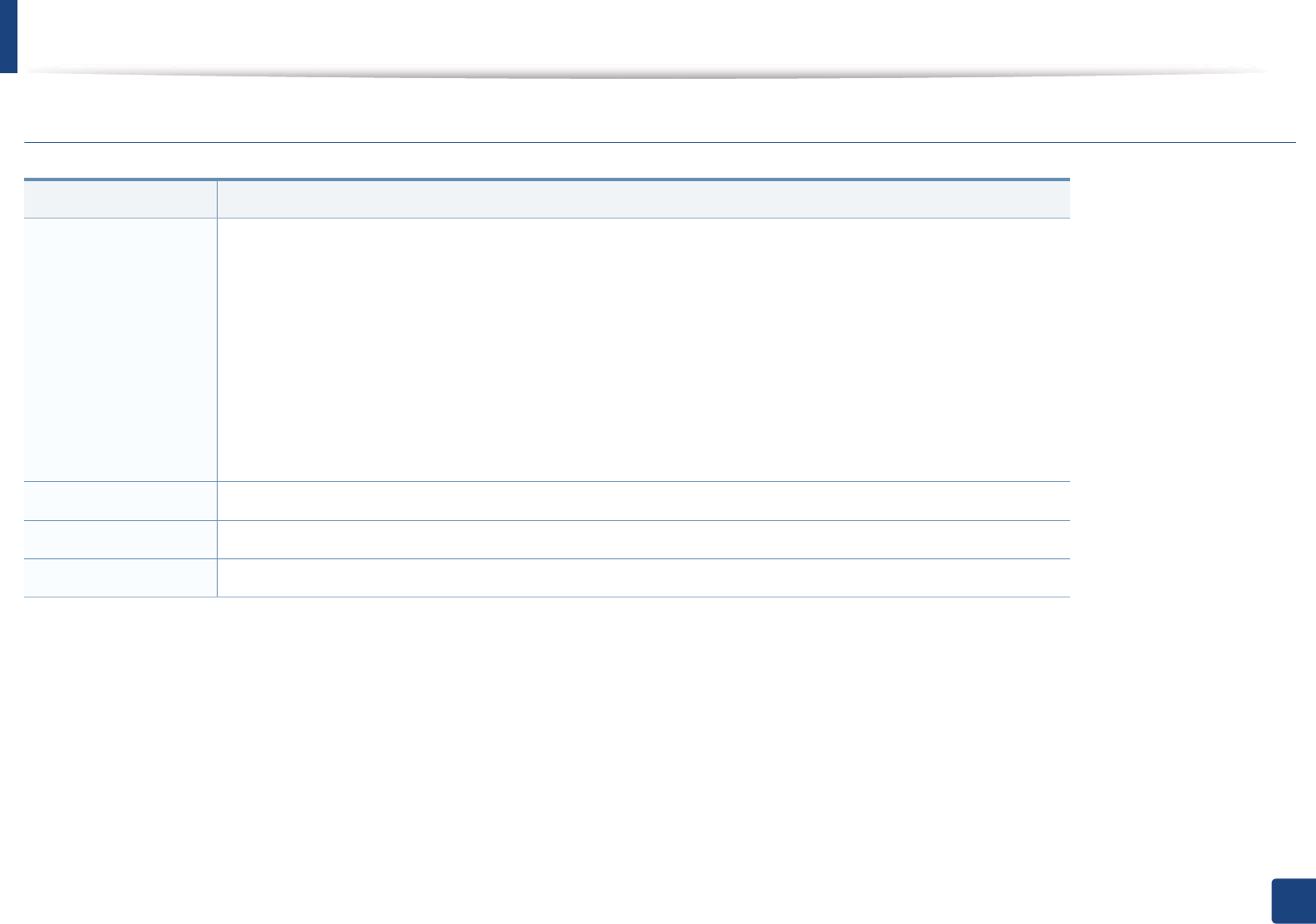
Specifications
99
5. Appendix
Linux
Items Requirements
Operating system Redhat® Enterprise Linux WS 4, 5 (32/64 bit)
Fedora 5 ~ 13 (32/64 bit)
SuSE Linux 10.1 (32 bit)
OpenSuSE® 10.2, 10.3, 11.0, 11.1, 11.2 (32/64 bit)
Mandriva 2007, 2008, 2009, 2009.1, 2010 (32/64 bit)
Ubuntu 6.06, 6.10, 7.04, 7.10, 8.04, 8.10, 9.04, 9.10, 10.04 (32/64 bit)
SuSE Linux Enterprise Desktop 10, 11 (32/64 bit)
Debian 4.0, 5.0 (32/64 bit)
CPU Pentium IV 2.4GHz (Intel Core™2)
RAM 512 MB (1 GB)
Free HDD space 1 GB (2 GB)
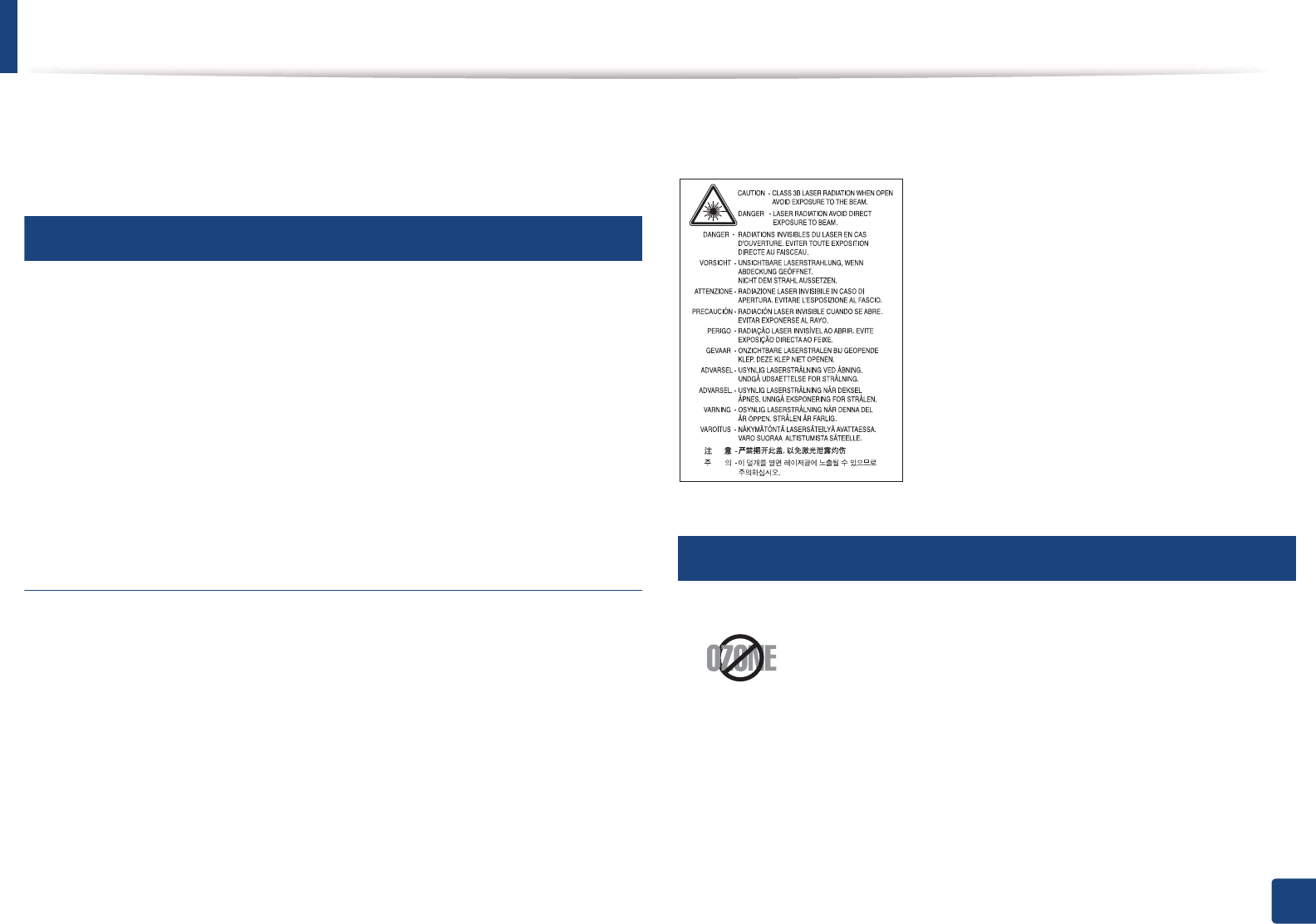
100
5. Appendix
Regulatory information
This machine is designed for a normal work environment and certified with
several regulatory statements.
4
Laser safety statement
The printer is certified in the U.S. to conform to the requirements of DHHS 21
CFR, chapter 1 Subchapter J for Class I(1) laser products, and elsewhere is
certified as a Class I laser product conforming to the requirements of IEC 60825-
1 : 2007.
Class I laser products are not considered to be hazardous. The laser system and
printer are designed so there is never any human access to laser radiation above
a Class I level during normal operation, user maintenance or prescribed service
condition.
Warning
Never operate or service the printer with the protective cover removed from
laser/scanner assembly. The reflected beam, although invisible, can damage
your eyes.
When using this product, these basic safety precautions should always be
followed to reduce risk of fire, electric shock, and injury to persons:
5
Ozone safety
This product’s ozone emission rate is under 0.1 ppm. Because
ozone is heavier than air, keep the product in a place with good
ventilation.